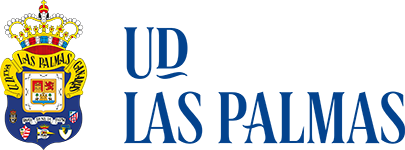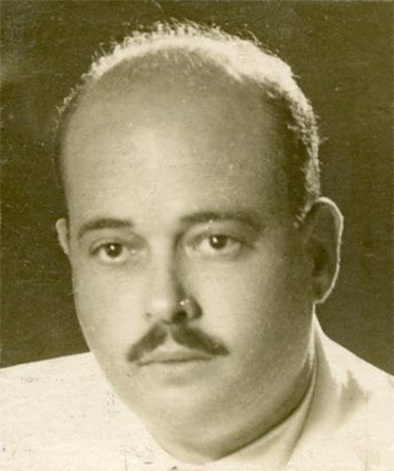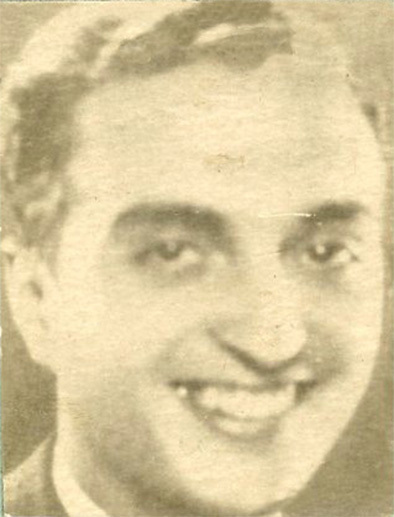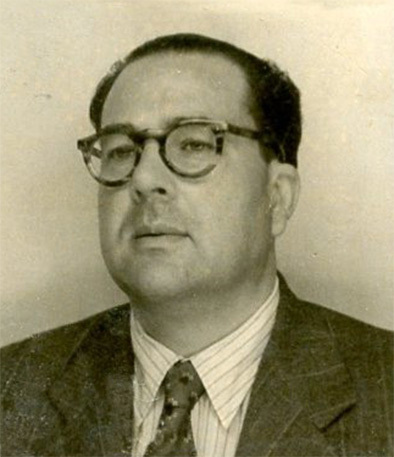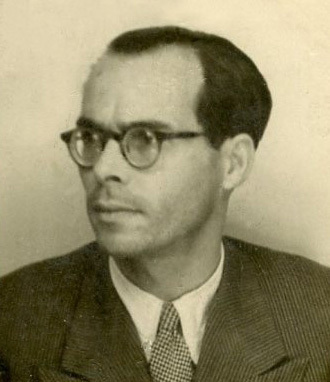YOU MUST PAY A DEBT OF GRATITUDE
Without having references or parallels with any Spanish club, UD Las Palmas arrived from nowhere to the highest category of national football. It was born from nothing because it came to life in moments of player disarray, of moral disarray in a fan base that was created in the shadow of the club's exploits. Nothing and no one has been able to diminish its refined brilliance.
From among the shrouds of that regional football in which no one believed anymore, the aspiration that surrounded the project was nourished, a madness for the most and a solution for the least.
We do not intend to recount again the first steps or those melodramatic initial babblings. But it is worth remembering and exalting those truly overwhelming vicissitudes of unlimited significance for two men who carried on their backs the never well-considered audacity. In one the idea was born; in another, the duty to model it. In both, push it with faith towards the goal. With what titanic efforts they both expended themselves in the fight! They worked a miracle, not only of convincing but of injecting love and faith into a team that would worthily represent the prestige of our football.
UD Las Palmas already has a history that requires great pages. History full of illusions and realities, of sorrows and joys. A proud history with living examples of selflessness and sacrifice, of darkness and light...
These men, who the reader will have already guessed, are creditors of a monument in the hearts of all the Canaries.
In these triumphant hours when the idols born in the heat of victory are most exalted, we forget those who made our present joy possible.
Those of us from Gran Canaria who have followed the trajectory of our UD Las Palmas since its birth and have closely experienced all the obstacles, difficulties and inconveniences throughout its history know of our obligatory debt of gratitude to two good people, two men who, although Already gone, they left us the most precious treasure of an ancient inheritance.
| MANUEL RODRÍGUEZ MONROY | ADOLFO MIRANDA ORTEGA | |
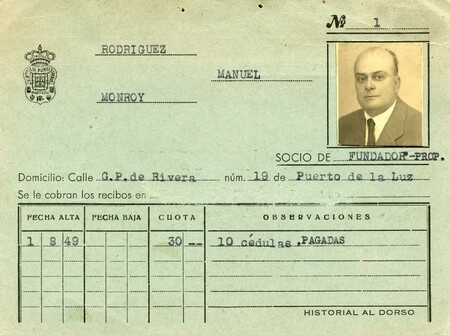 |
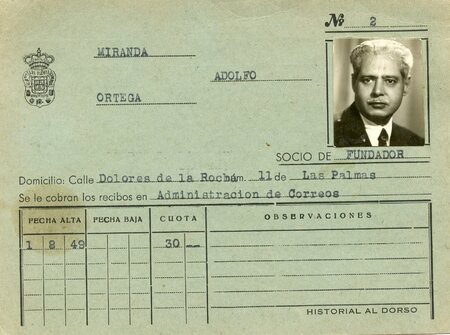 |
|
| Manuel Rodríguez Monroy, the first founding partner, was the manager of the idea of creating the U.D. Las Palmas. | Adolfo Miranda Ortega, president of the Las Palmas Regional Federation, promoter and channeler of the project. | |
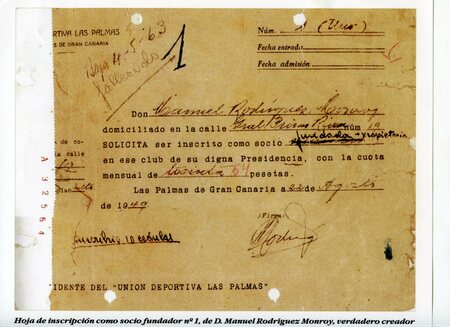 |
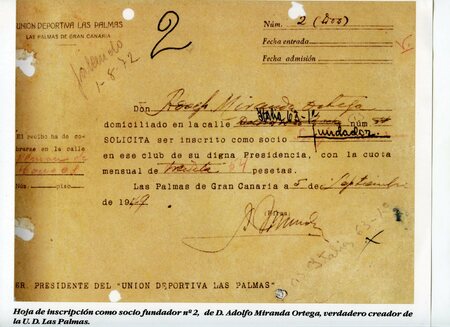 |
|
| Registration sheets as first founding members of Mr. Manuel Rodríguez Monroy and Mr. Adolfo Miranda Ortega, true creators of the U.D.Las Palmas. | ||
Origin and birth of UD Las Palmas
How, when, where and why UD Las Palmas was born and what were the true reasons and process of its constitution.
This detail, although it may seem trivial and at first glance irrelevant, has a deep background and meaning that distinguishes it and makes it particular. And what really is that differentiating feature?
In fact, after analyzing it carefully on many occasions, I have come to the firm conclusion that its peculiarity is caused by various random or distant factors: geographical, anthropological, ethnographic, sociological, linguistic, etc., which form an indissoluble and non-transferable corpus that is difficult to identify. delimit individually.
Although it may border on excessive hyperbole, UD Las Palmas transcends the merely earthly or everyday. It is as I have repeatedly stated and as stated in the title of one of my books “the pride of an ancient heritage” and therefore a state of the soul that should be approached from a more spiritual or metaphysical perspective.
It is not simply about the achievement of a sports classification or the mere success of a management. It is also about the unconditional adhesion of an entire people. Citizens without the slightest notion of the art of football but who feel UD Las Palmas as something inherent to their own lives; a symbol of loyalty and affection, or emotional identification that comes from all social classes since UD Las Palmas would become, from the first moment, an authentic social phenomenon, a vehicle of popular expression and everyone's club; It is enough as shown by the immense archive of members that the club has had throughout its history where it would be strange not to find a connection or relationship with a family member.
A few days ago a man approached me in the middle of the street and gave me as a paradigm his grandparents and his uncles who lived in the most remote and wild places on the island and had never been on a soccer field. However, when Sunday afternoon arrived, the first thing that came to their minds was wondering what the result of UD Las Palmas had been, not giving up their efforts until they found out.
Obviously, depending on whether this was favorable or not was also his mood.
And since the day it was founded, our club has been a pulse or emotional heartbeat in the heart of the city, an attitude toward life itself.
I assume that the topic to be developed in this chapter may be somewhat legislative and sometimes cumbersome, but I have considered it necessary and of obligatory reference to show with all documentary evidence how our club was truly created and who made its birth possible.
It has been written on rare occasions about the subject and sadly most of the time with great frivolity and lightness and what is even worse, without any reliable support or documentary evidence.
The events did not happen as fleetingly and superficially as I have read on occasion, but rather it was an arduous and slow process.
Already in 1925, a few athletes from the C.D. Gran Canaria conceived the idea of establishing a football federation on the island. It was up to Mr. Rafael Navarro Jiménez to carry out the first steps that he carried out successfully, getting Las Palmas to join the Andalusian Regional Federation.
In our capital, a subcommittee dependent on the aforementioned Regional was then established, with the Tenerife clubs also joining.
A few years later this subcommittee was segregated, producing a schism between the two islands. From this separation, both Canary Islands federations would have complete sporting autonomy. These regionals were consolidated and the Spanish Football Federation would integrate us into the Spanish Cup.
After the long break caused by the Spanish Civil War, the Las Palmas Football Federation was reorganized, with the great sportsman Mr. Fernando Rivero del Castillo Olivares assuming the presidency. He did an outstanding job, culminating in the achievement of the interregional competition. Later, Mr. Adolfo Miranda Ortega took over the presidency and began efforts at the national level.
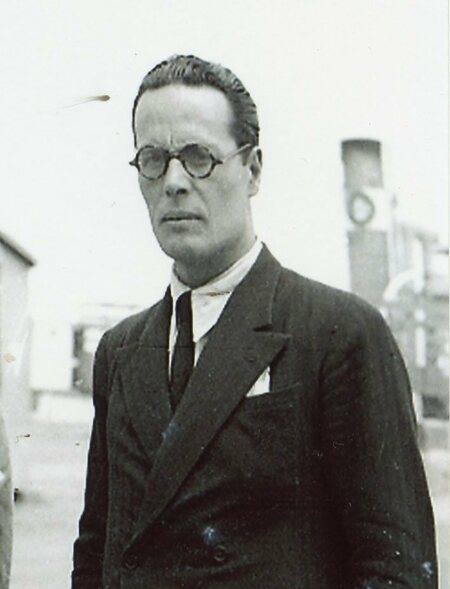
Mr. Fernando Rivero del Castillo Olivares
Given the precarious situation that our clubs were going through at the end of the forties of the last century, and the decline that our regional competition had experienced, Mr. Manuel Rodríguez Monroy, vice president of the Regional Federation and a man of recognized equanimity and rectitude, arrives to the full conviction that it is only through the merger of the five teams that made up the First Regional Category that our football could be incorporated into national competitions and thus solve its difficult situation.
The Canary Islands needed to join national football if they wanted to return to the splendor of yesteryear and without the merger it would not have been possible to present our request to the Royal Spanish Federation.
Each follower of the five teams had to see in the merged club the continuity of their own club and had to identify with its new colors.
This correct idea is raised by Rodríguez Monroy to the president of the Regional Federation, Adolfo Miranda Ortega, with whom, in addition to the employment relationship, he had great ties of friendship. Encouraged by this and the other members of the Federative Council, he presents a motion to the Federation in which he calls on the five teams of the First Regional for the merger, putting above all the sporting honor of the Canary Islands and starting from the great axiom “unity is strength”.
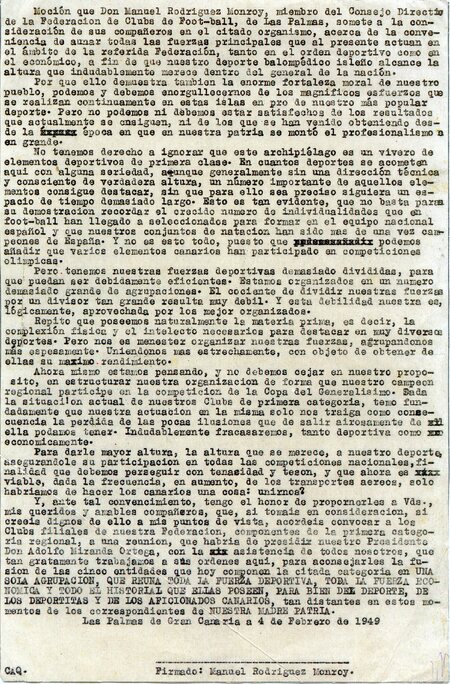
| Motion presented to the Regional Football Federation of Las Palmas, on February 4, 1949 by the vice president Mr. Manuel Rodríguez Monroy, in which he calls on the five teams of the First Regional with the purpose of their merger, putting Above all, the sporting honor of the Canary Islands and based on the great axiom “unity is strength”. |
On February 4, 1949, the motion presented by the member of said organization Rodríguez Monroy was submitted to the verdict of the board of directors of the Federation of Las Palmas, in order to achieve the incorporation of the island to the national category.
Once the happy idea was received by the federative council, Mr. Adolfo Miranda Ortega, the great promoter of the project, called a meeting on February 28 of the same year at the Regional Football Federation of Las Palmas, which at that time was located in the Dr. Domingo Déniz street No. 3 of Alameda de Colón, inviting the representatives of the five clubs: R.C. Victoria, Marino C.F., C.D. Gran Canaria, Atlético Club and Arenas Club.
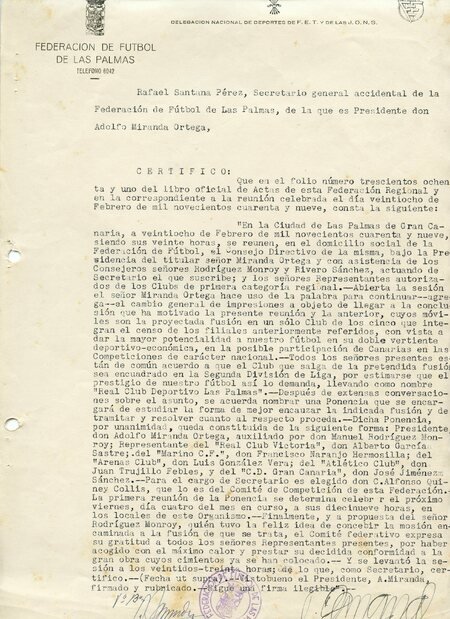 |
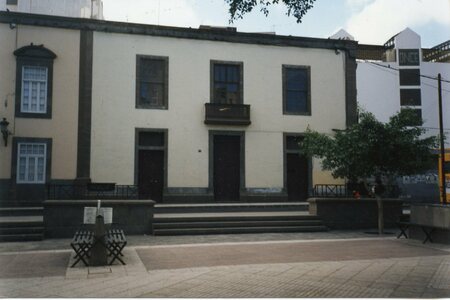 |
| Writing from the Las Palmas Regional Football Federation. | Headquarters of the Regional Federation of Las Palmas, located at 3 Dr. Domingo Déniz Street in Alameda de Colón. The representatives of the historical clubs were summoned and the Fusion Presentation carried out its work. |
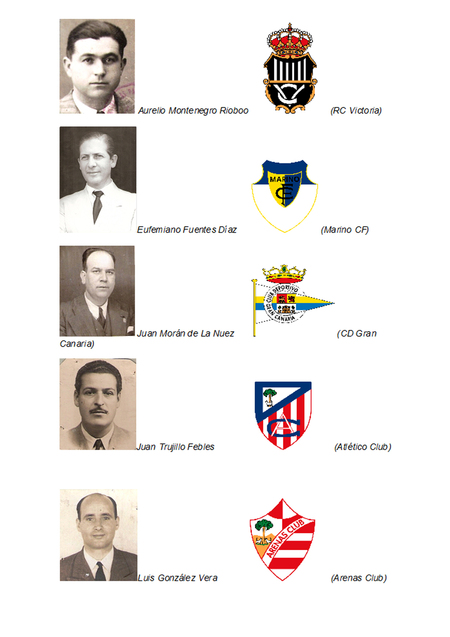
The representatives of these teams attended the meeting with good will and predisposition, but showing certain reluctance and doubts. On the one hand, it was giving up an entire historical context and past and fundamentally some colors that have been deeply rooted over so many years.
On the other hand, there was no complete conviction that the idea would prosper, with some clubs considering the venture very risky.
C.D.Gran Canaria, Arenas Club and Atlético Club opted from the first moment in favor of the idea. Their sports societies had hit rock bottom and they saw this alternative as their salvation. It must be understood that their societies, although with a worthy history, did not have the great social mass of R.C.Victoria and Marino C.F. nor the possibility of selling its great players to clean up its battered economy.
The R.C.Victoria and the Marino C.F. Although they cooperated in the project from the beginning, they were indecisive and fearful of the repercussions that the company could have on the social masses. Its leaders and partners did not fully commit to the merger, showing division of opinion.
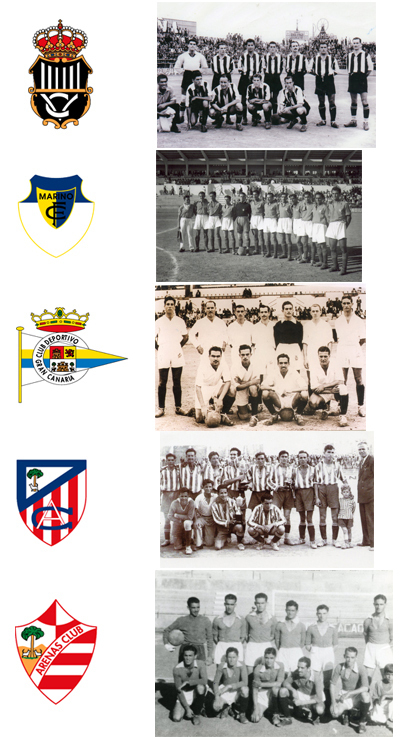
To continue addressing all these issues, it was agreed to appoint a Presentation, which would be called from the outset “Fusion Presentation”. This would meet every Monday at the premises of the Regional Federation, being made up of a member and a substitute from each club, in addition to the president, vice-president and secretary of the Regional Federation.
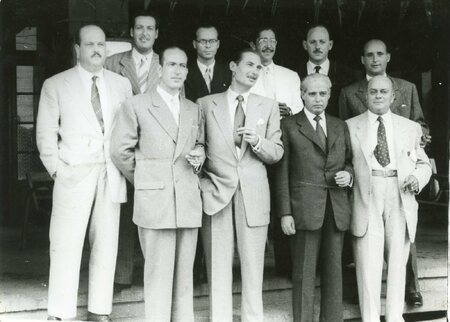 |
| Fusion Presentation. Photo taken at the Frontón Las Palmas on Monday, July 17, 1951 on the occasion of the celebration of promotion to the First National Division. |
| In second row. From left to right: Mr. Francisco Naranjo Hermosilla, Mr. Juan Trujillo Febles, Mr. Manuel Hernández Sánchez,D. Luis Rivero Noble, Mr. Vicente di Napoli Bottone and Mr. Luis González Vera In the front row Mr. José Jiménez Sánchez, Mr. Alfonso Quiney Collis, Mr. Adolfo Miranda Ortega and Mr. Manuel Rodríguez Monroy. Missing from the appointment are Mr. Alberto García Sastre, Mr. Simón Doreste Struch, Mr. Antonio Cabrera Azopardo, Mr. Miguel Peñate Peñate and Mr. Guillermo Wyttenbach García. |
The Fusion Presentation was configured as follows:
|
Federación Regional de Fútbol de Las Palmas |
||
| President | Vicepresident | Secretary |
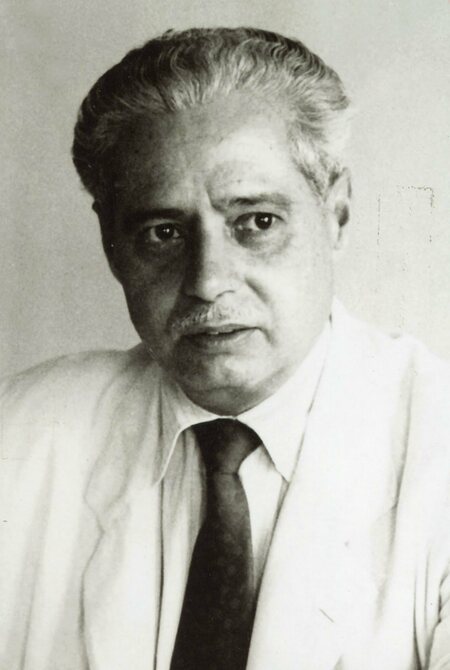 |
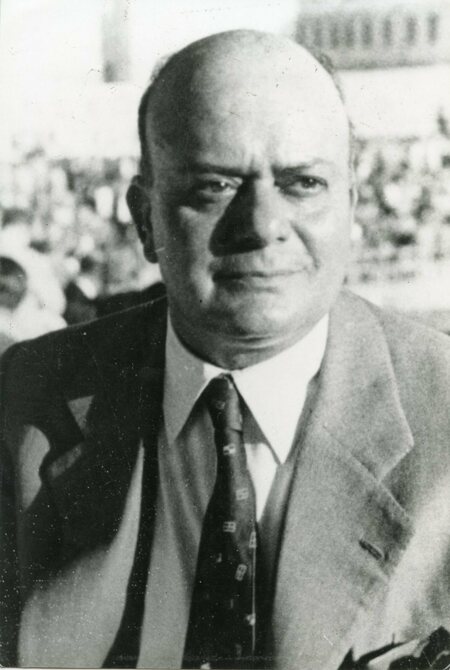 |
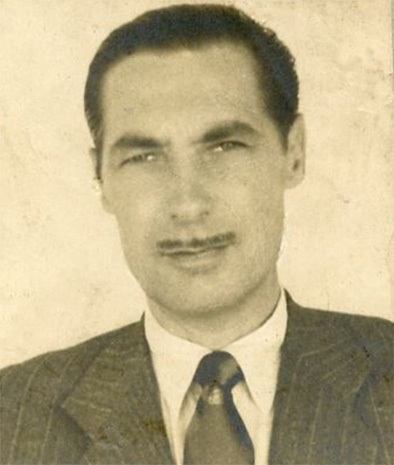 |
|
Mr. Adolfo Miranda Ortega |
Mr. Manuel Rodríguez Monroy |
Mr. Alfonso Quiney Collis |
|
|
Marino C.F. |
|
|
|
|
|
|
Mr. Francisco Naranjo Hermosilla |
Mr. Antonio Cabrera Azopardo |
Subsequently, Mr. Simón Doreste Struch |
| R.C. Victoria | |
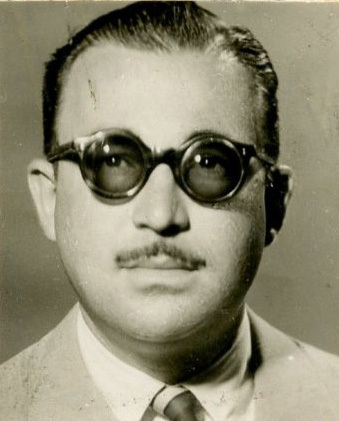 |
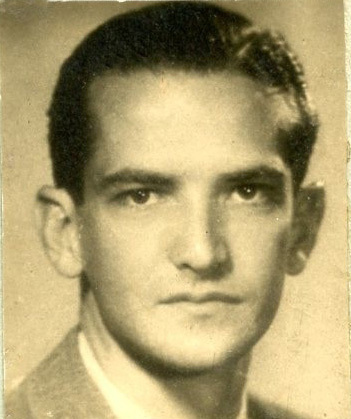 |
|
Mr. Guillermo Wyttenbach García
|
Mr. Alberto García Sastre |
| C.D. Gran Canaria | ||
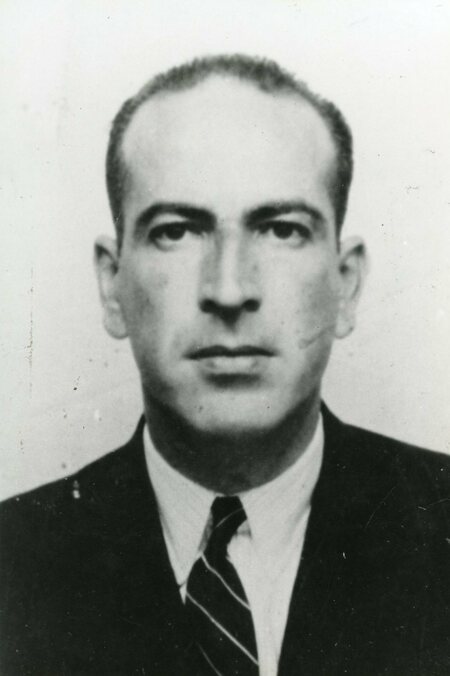 |
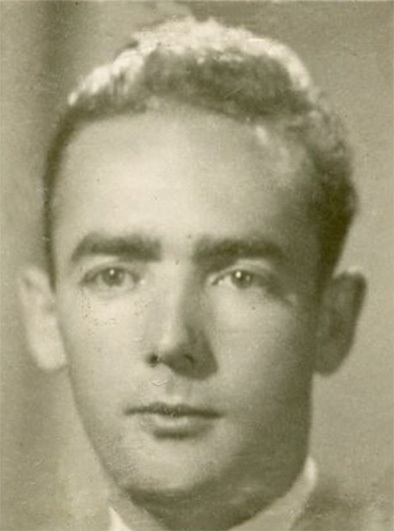 |
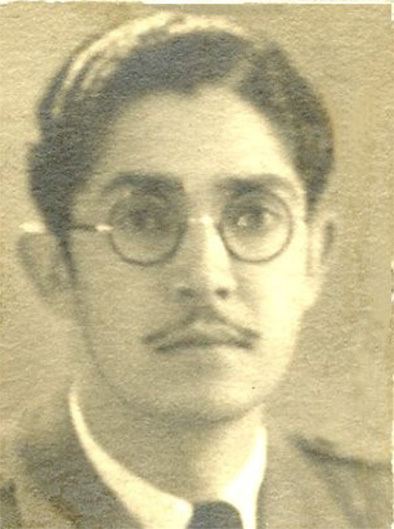 |
|
Mr. José Jiménez Sánchez |
Mr. Miguel Peñate Peñate |
Subsequently, Mr. Luis Rivero Noble |
| Atlético Club | |
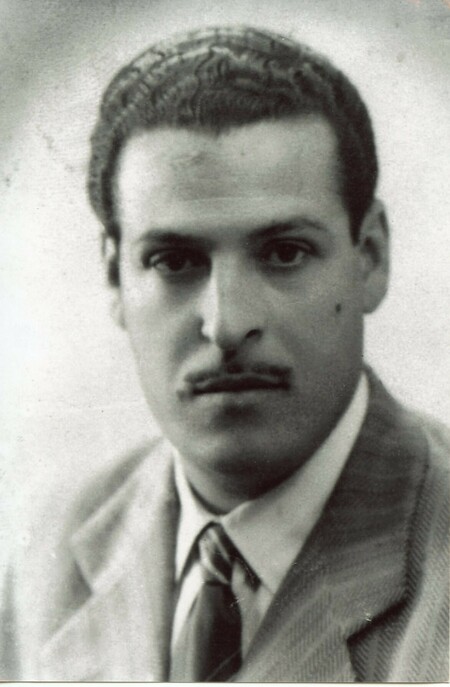 |
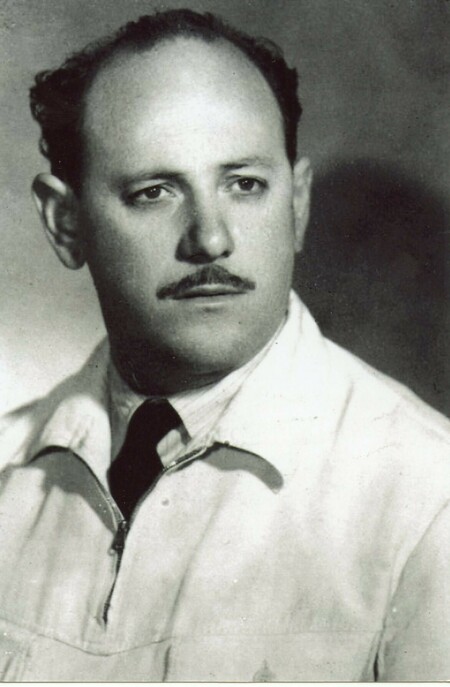 |
|
Mr. Juan Trujillo Febles
|
Mr. Vicente di Nápoli Bottone |
|
Arenas Club
|
|
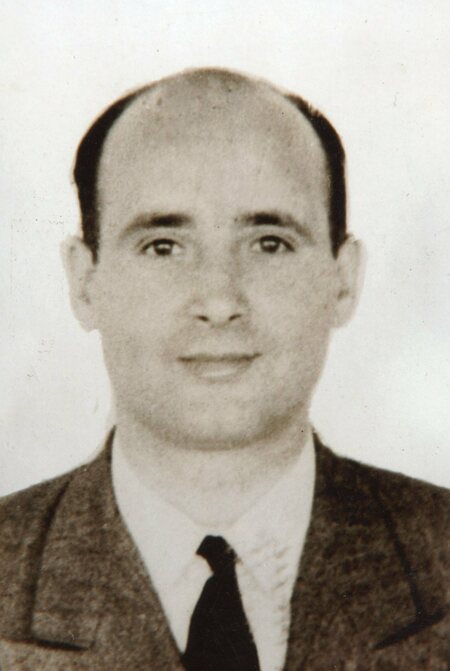 |
|
|
Mr. Luis González Vera
|
Mr. Manuel Hernández Sánchez |
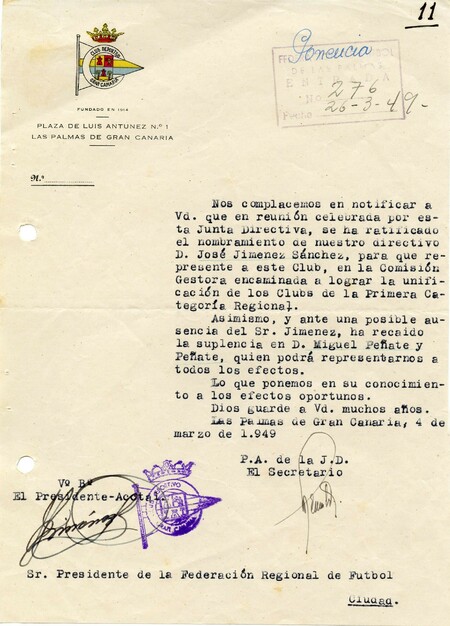 |
 |
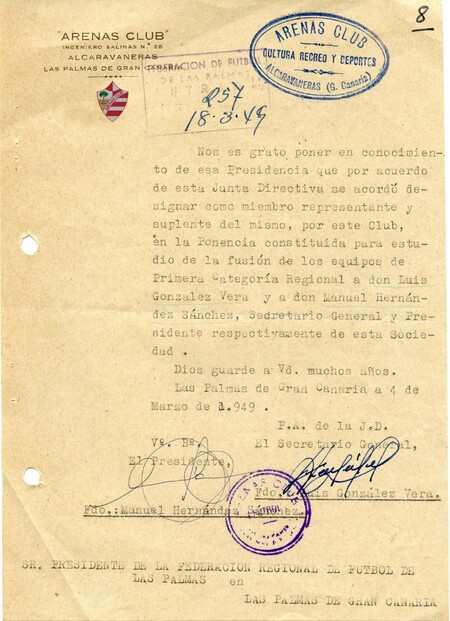 |
|
C.D. Note Gran Canaria notifying the Regional Federation of the appointment of its director Mr. José Jiménez Sánchez as representative of said club, with his replacement being Mr. Miguel Peñate y Peñate.
|
The R.C. Victoria appoints the directors Mr. Alberto García Sastre and Mr. Guillermo Wyttenbach García as representatives.
|
The Arenas Club agrees to elect Mr. Luis González Vera as representative member, with Mr. Manuel Hernández Sánchez being his substitute.
|
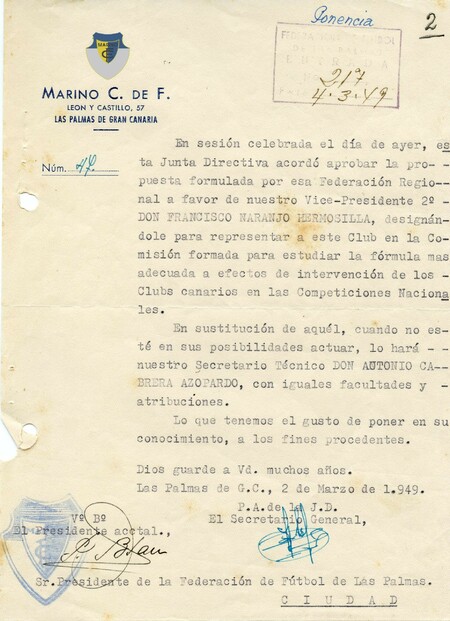 |
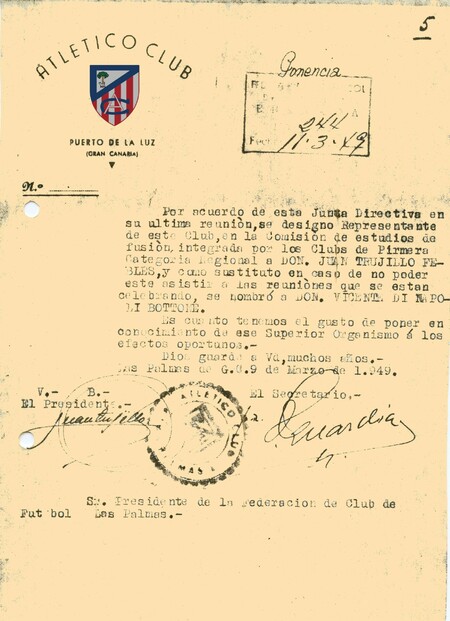 |
|
The representation of Marino C.F. It would fall to its vice president Mr. Francisco Naranjo Hermosilla and as a substitute to the secretary of the albiazul entity Mr. Antonio Cabrera Azopardo who would be replaced by Mr. Simón Doreste Struch.
|
Note from Atlético Club notifying its representative Mr. Juan Trujillo Febles and his substitute Mr. Vicente di Napoli Bottone.
|
The Canary Islands join national football.
It is necessary that in the history of our U.D. Las Palmas records that both the Royal Spanish Football Federation, initially chaired by Mr. Armando Muñoz Calero, and later his replacement in office Mr. Manuel Valdés Larrañaga, Secretary of the Royal Spanish Football Federation Mr. Ricardo Cabot Montal, National Sports Delegation, chaired by the Hon. Mr. Moscardó, as well as the member of the Federation Lieutenant Colonel Laureado Gómez Zamalloa, would close their doors to us in a project that they called “crazy.”
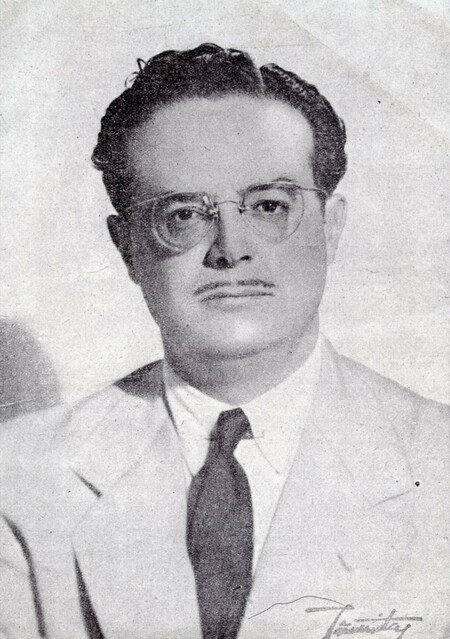 |
 |
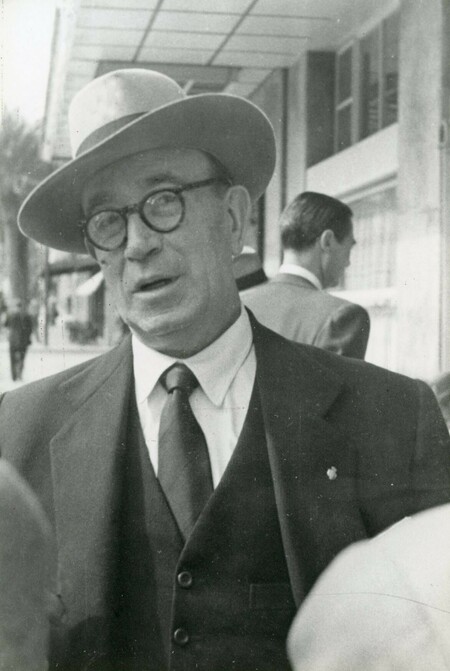 |
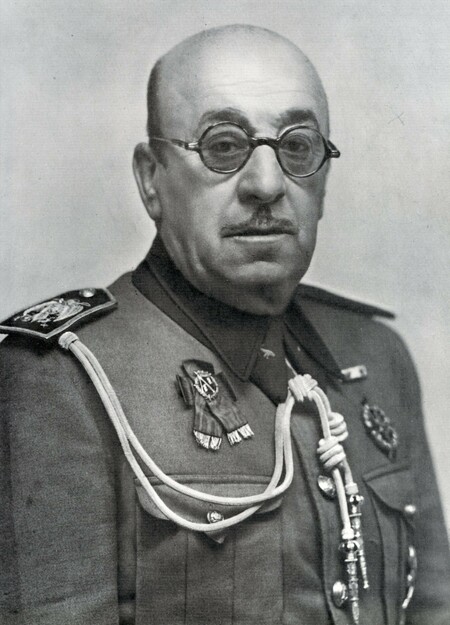 |
| Mr. Armando Muñoz Calero, President of the Spanish Football Federation when the efforts to incorporate Canarian football into national competitions began. He was replaced in office by Mr. Manuel Valdés Larrañaga under whose presidency said objective would be achieved. | Mr. Manuel Valdés Larrañaga, president of the Spanish Football Federation when UD Las Palmas was established. | Mr. Ricardo Cabot Montal, Secretary of the Royal Spanish Football Federation. | Hon. Mr Moscardó |
There were those from the highest levels who ordered that we be given the necessary opportunities until the Canary Islands were definitively integrated into the national football competitions and from that moment new horizons would open for Canary Islands football in general, but for this it was necessary to travel a long and winding road...
Our clubs, especially C.D, Gran Canaria, which was the oldest and later Marino C.F. and the R.C. Victoria had an incontrovertible age of majority: 1894, 1905 and 1910 were its oldest years of foundation.
It was not about the creation of a new club. The club thus formed would have a more meritorious record than the best of them and the seniority of the oldest.
The first agreement of the Fusion Presentation was to commission Mr. Adolfo Miranda Ortega and Mr. Manuel Rodríguez Monroy to bring to the National the proposal for the integration of the single team into the national competitions.
At first they tried to be part of a group integrated into the Second Division, since it was economically more advantageous for the entity.
For this, negotiations were made with local authorities and relevant people in our city. trying to get them to intercede as much as possible, making our aspirations reach the highest levels.
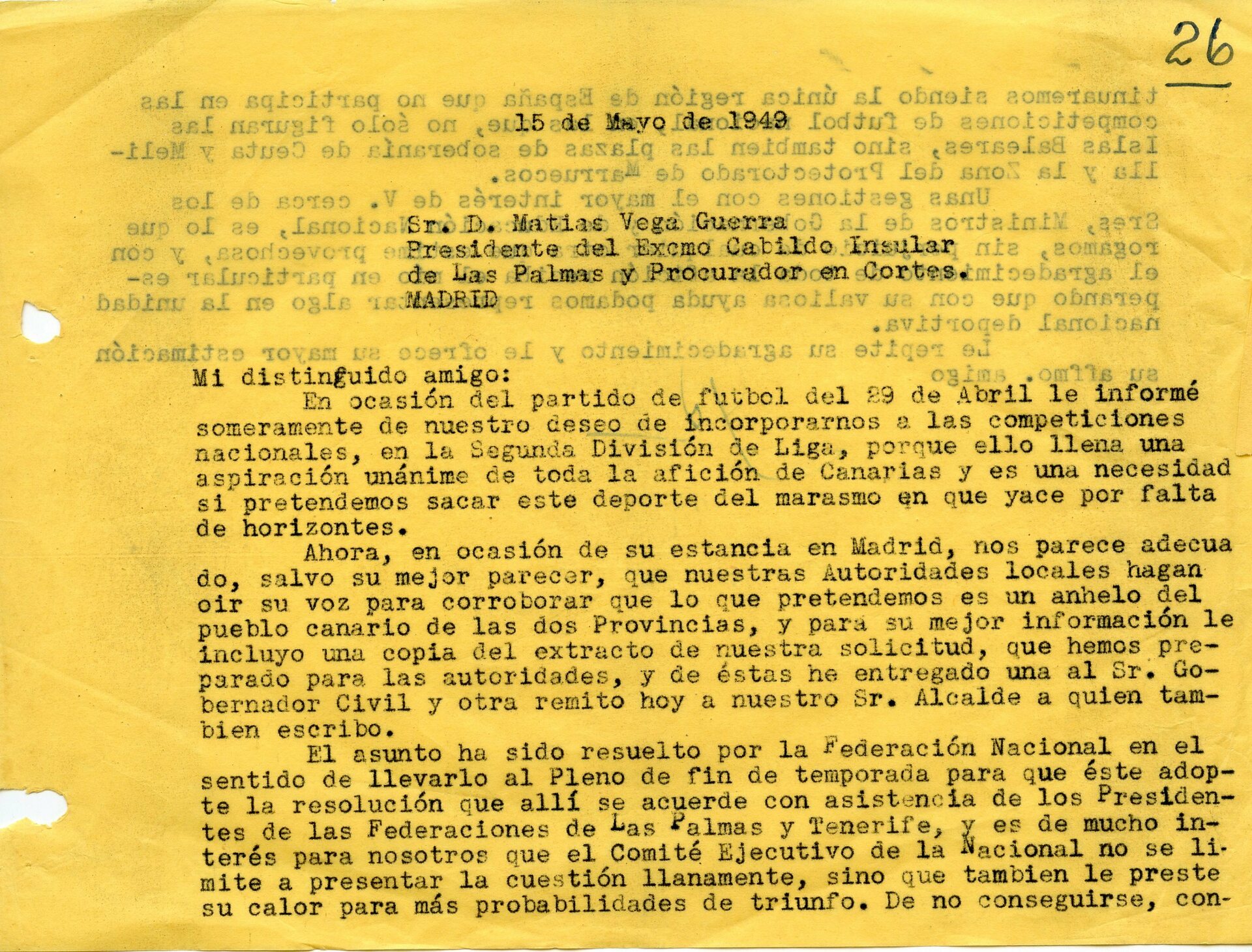 |
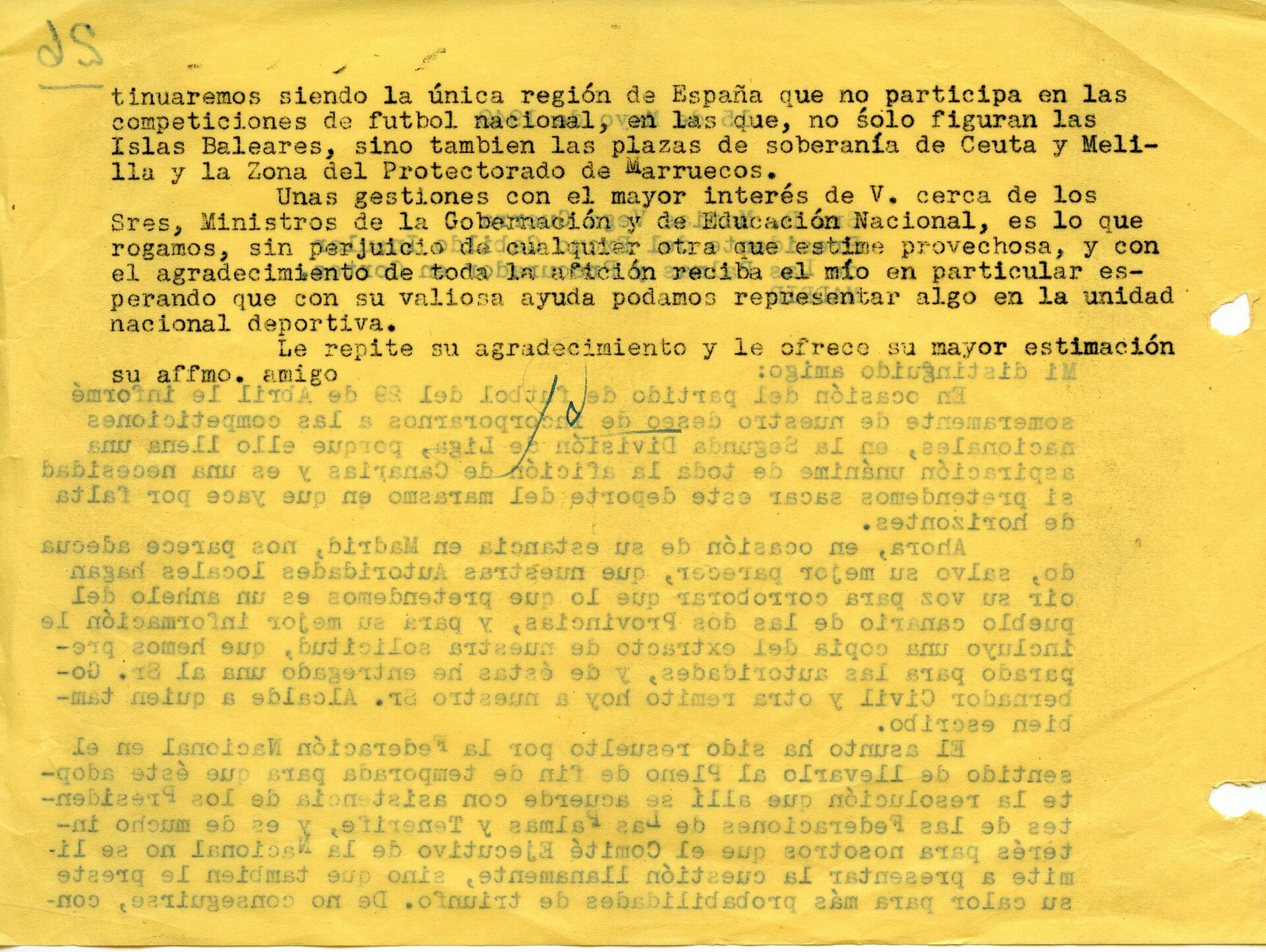 |
| Writing from the President of the Regional Federation of Las Palmas Mr. Adolfo Miranda Ortega to the President of the Hon. Island Council and Cortes Attorney Mr. Matías Vega Guerra begging you to carry out the necessary steps in Madrid with the aim of integrating our football into national competitions. | |
The National Federation chaired by Mr. Valdés Larrañaga responded negatively to the request to include our club in the Second Division, arguing that this concession was detrimental to other teams and substantially altered the general principles that had always regulated promotions to a higher category. .
We continued to be the only region of Spain that was unable to participate in a national football league, which included not only the Balearic Islands but also the sovereign seats of Ceuta and Melilla and the protectorate area of Morocco.
However, its Secretary, Dr. Cabot, promised to take the proposal to a plenary session and look for another alternative.
Replica of the Royal Spanish Football Federation signed by its General Secretary Ricardo Cabot denying our incorporation into the Second Division, arguing that said decision would alter the established rules of the competition.
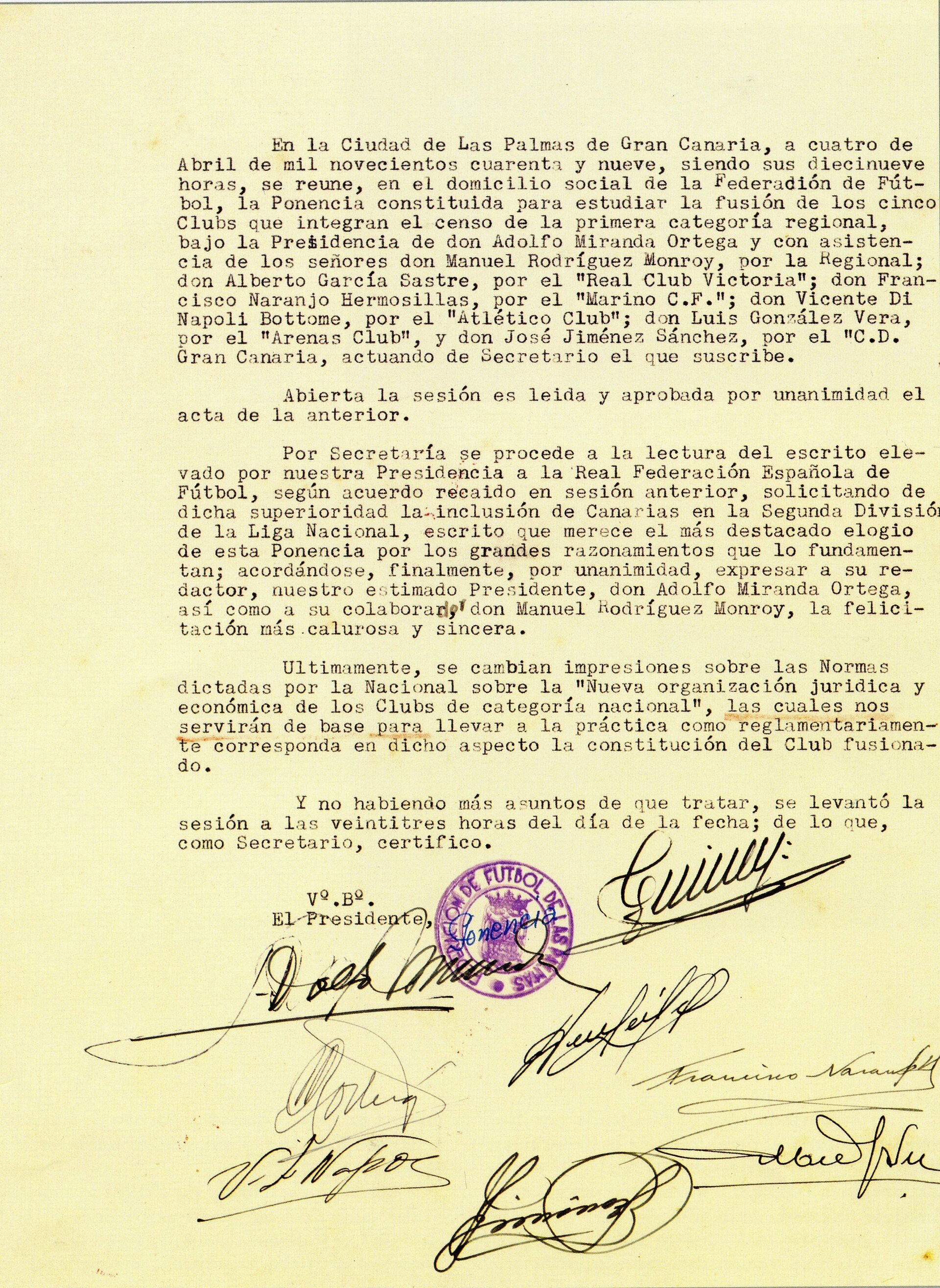 |
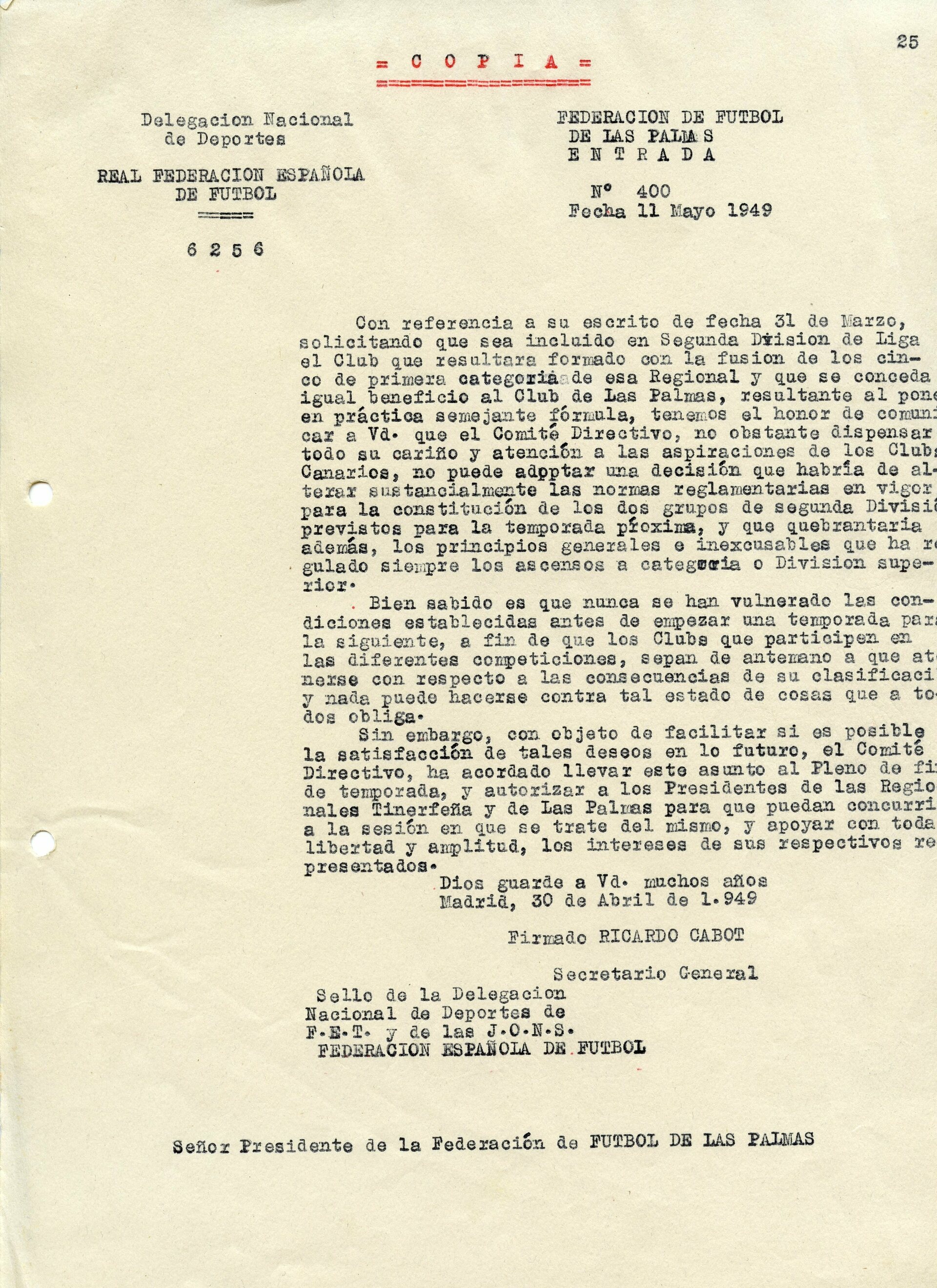 |
|
| Book of minutes of the Las Palmas Football Federation where the request of the Merger Presentation for the Canary Islands to be included in the Second Division is recorded. This request would be denied. | Replica of the Royal Spanish Football Federation signed by its General Secretary Ricardo Cabot denying our incorporation into the Second Division, arguing that said decision would alter the established rules of the competition. |
After a short time, Mr. Adolfo Miranda Ortega and Mr. Manuel Rodríguez Monroy were invited to Madrid by the Royal Spanish Football Federation, reaching a reasonable solution for both parties:
The Canary Islands had been incorporated into National Football.
The President and Vice President of the Regional Federation would send a telegram from Madrid upon hearing the news, addressed to the Merger Report, dated June 6, 1949, indicating the success of the management, which was expressed literally:
“The plenary session unanimously approved the proposal to consider the next Regional Championship as the Third Division, promoting champions Las Palmas Tenerife Second Promotion, we are satisfied and consider it a success given the general problems raised. Greetings Miranda Rodríguez.”
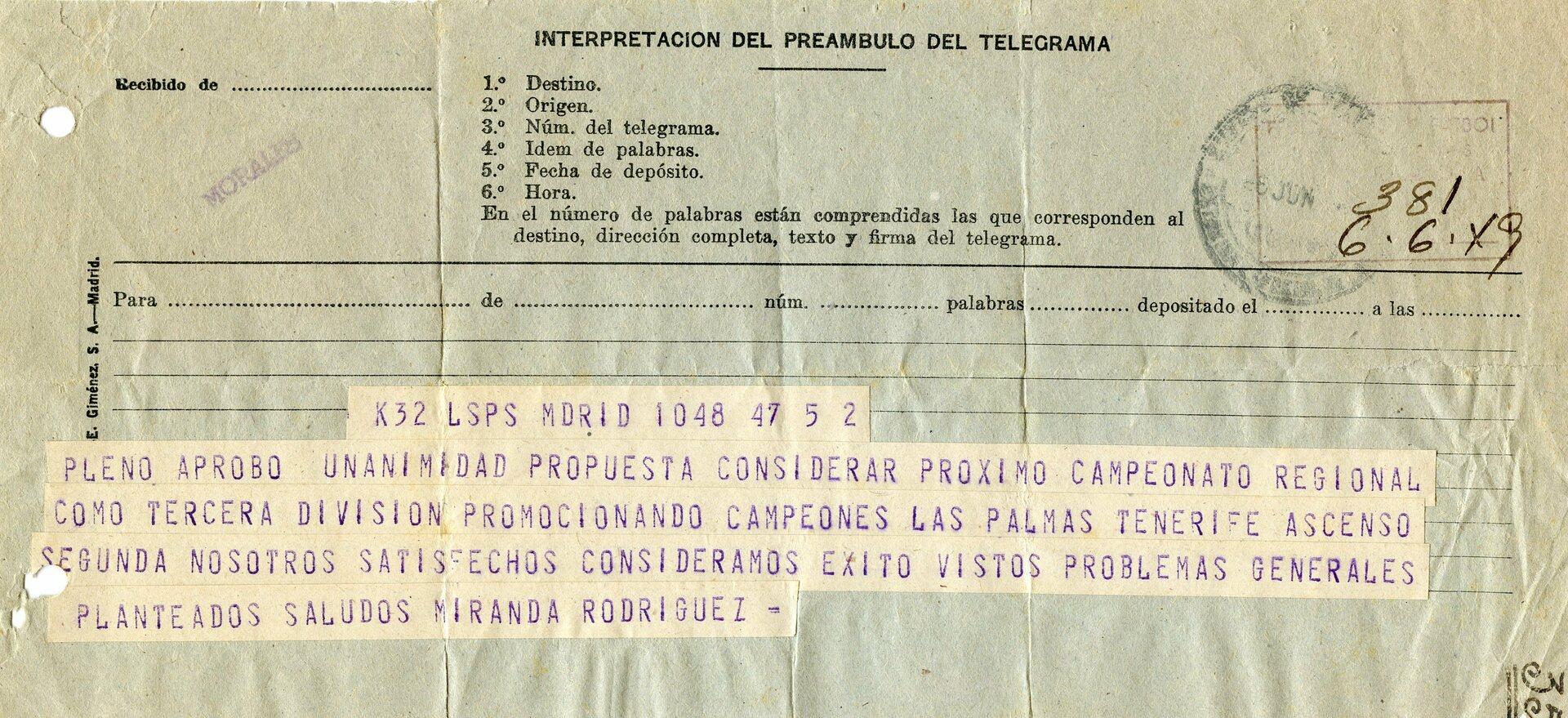 |
| Telegram sent from Madrid by the president of the Regional Federation of Las Palmas, Mr. Adolfo Miranda Ortega and the vice president, Mr. Manuel Rodríguez Monroy, addressed to the Fusion Presentation, when the Canary Islands clubs were integrated for the first time in national competitions . |
Statements by Mr. Adolfo Miranda Ortega.
Upon returning to our city, the two leaders, the President of the Regional Federation, Mr. Adolfo Miranda Ortega, would explain the following:
“After defending the project, first myself and then the representative of the sister island, I stated our pride as Canarians, and that at all times we considered ourselves as much a province as any other in the homeland. We believed that we had the same right as the Balearic Islands and areas of the Protectorate, and in view of the reasonable difficulties that they exposed us to, we suggested the idea that we be considered as a group of
Third division. Our project was received favorably and starting next season the members of Las Palmas and Tenerife will join to play a Third Division Liguilla with the champions and runners-up of each group with the aim of promoting to the Second Division.
The achievement of such a long-awaited incorporation has many names. Naturally, all the components of the “Fusion Presentation”, especially its two most significant figures, as we have already mentioned repeatedly:
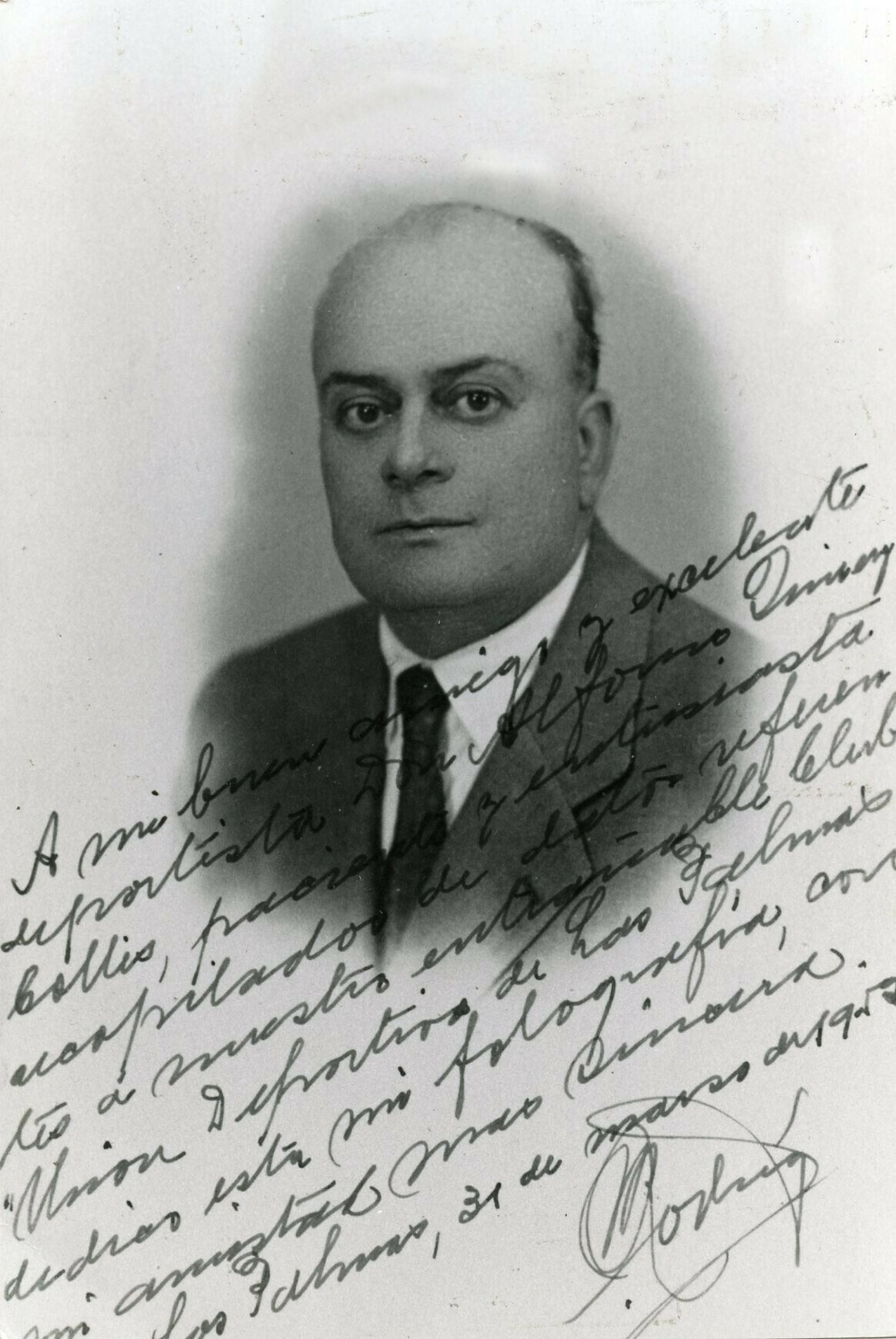
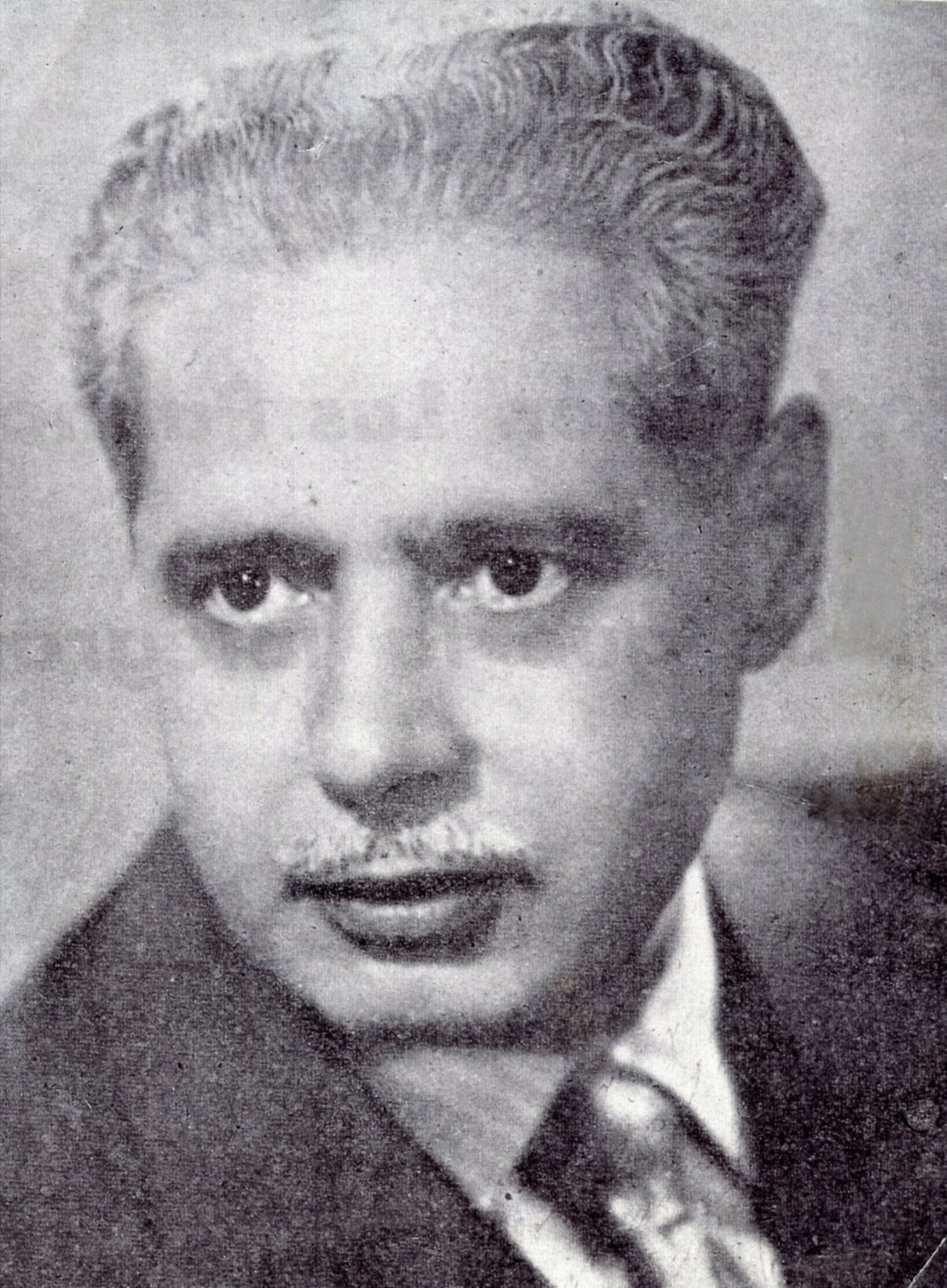
| Mr. Manuel Rodríguez Monroy (manager of the idea of creating the UD Las Palmas, that is, its authentic architect and promoter). | Mr. Adolfo Miranda Ortega (true channeler and great promoter of the project). |
However, on a different scale, it would be fair to point out for his fundamental importance the Captain General of the Canary Islands, Mr. Francisco García Escámez e Iniesta, who had a notable and decisive influence, contacting authorities of great relevance at the national level to incorporate our football into the maximum competition, especially his conversations with the Laureate Lieutenant Colonel Mr. Mariano Gómez Zamalloa, member of the National Federation, according to a writing in his handwriting that is jealously kept in the club's archives.
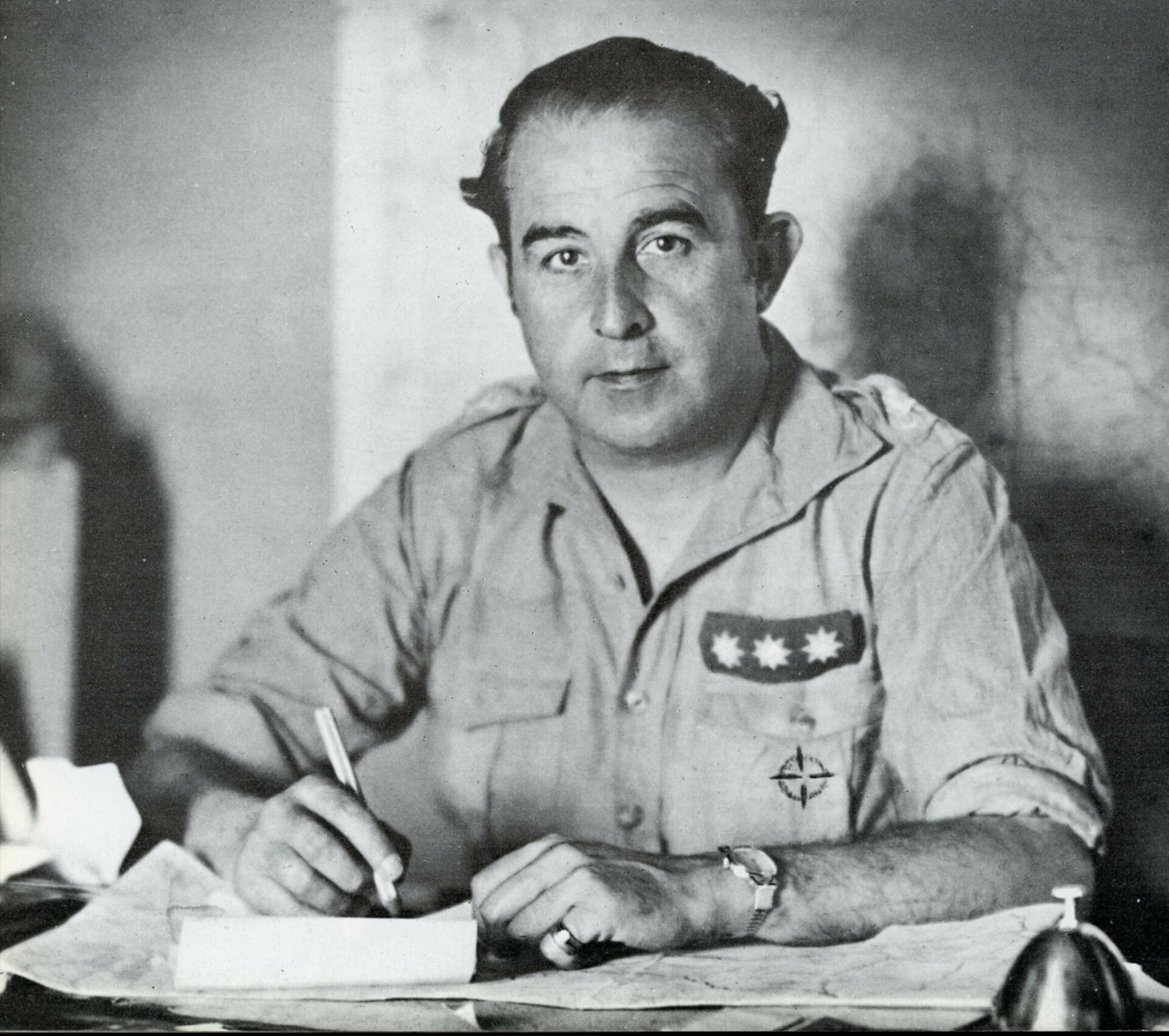
Hon. Mr. Francisco García Escámez e Iniesta.
The President of the Island Council of Gran Canaria, Mr. Matías Vega Guerra, who would also move to Madrid and made his voice heard in the plenary session on July 4, 1949, in addition to entering into negotiations with the Ministers of the Interior and National Education.
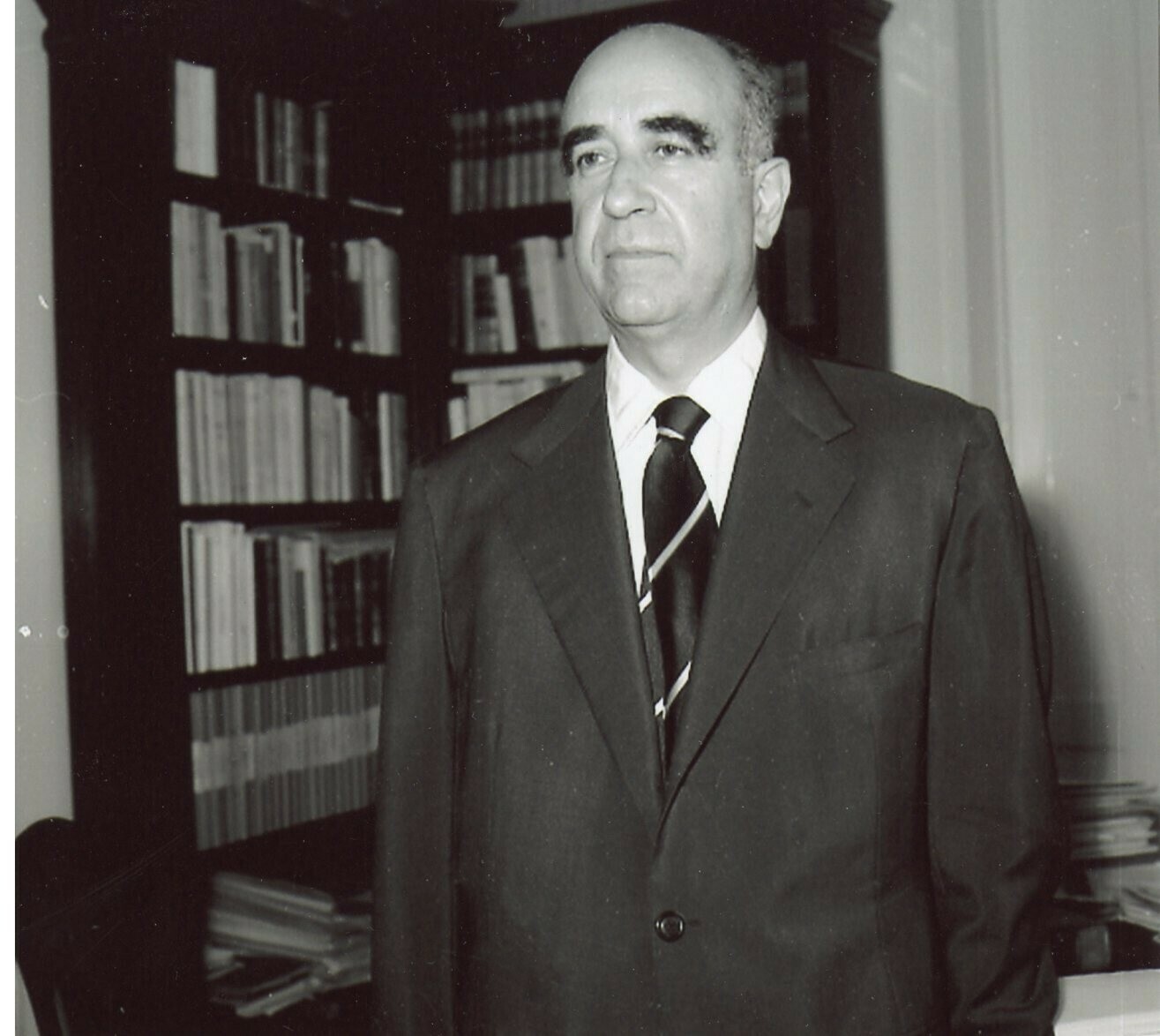
Hon. Mr. Matías Vega Guerra.
It would also be worth highlighting the invaluable help and collaboration of the Mayor of the city of Las Palmas de Gran Canaria, Mr. Francisco Hernández González, for also being present at the plenary session, having previously met with all the mayors of the most important Spanish provinces. with the purpose of asking for an attitude of solidarity and commitment, an action that was highly praised by the national press.
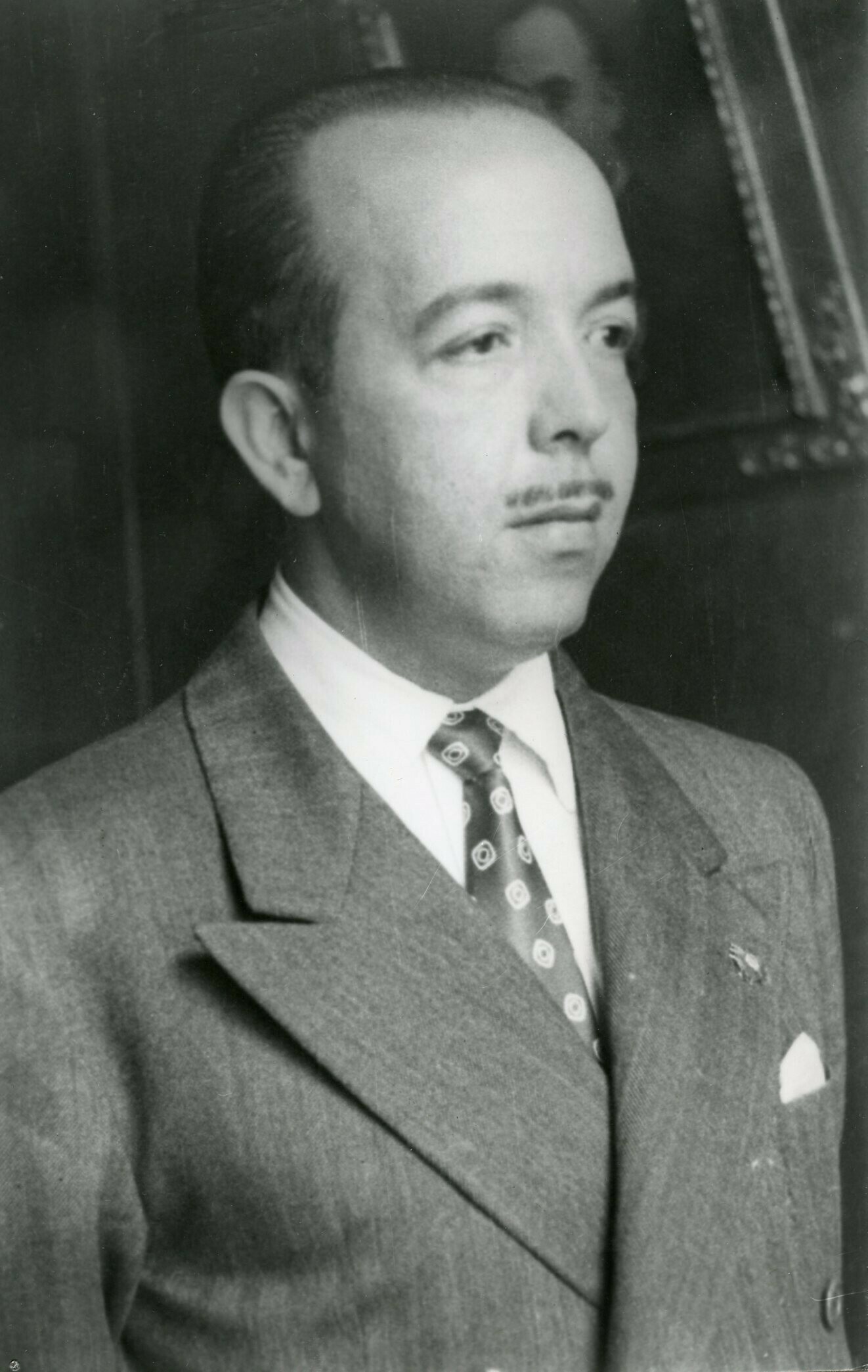
Mr. Francisco Hernández González,
Mayor of Las Palmas de Gran Canaria
Likewise, the praiseworthy cooperation of Mr. Luis Benítez de Lugo (Marquis of The Florida), at the time treasurer and member of Atlético de Madrid and over the years (1952) president of the club, for mediating with the Castilian Federation who was the most reluctant to our incorporation.
But to all these names we should add one truly fundamental one: Mr. José Solís Ruiz, who in those years held the position of National Delegate of Trade Unions, to whom we resorted as a last resort in view of the emphatic refusal of the National Federation and Council. Nacional de Deportes, being at all times an unconditional supporter of our interests.
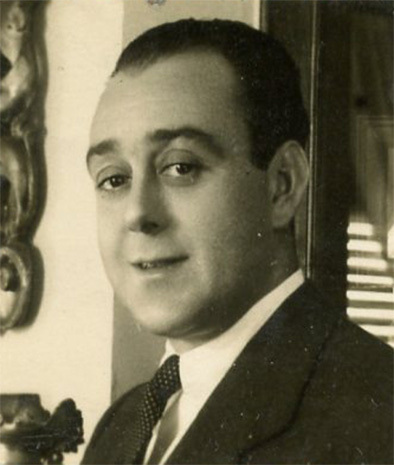 |
 |
|
| Mr. Luis Benítez de Lugo, Marquis of the Florida | Mr. José Solís Ruiz, National Delegate of Unions when the UD Las Palmas was created. He would later serve as general minister of movement for thirteen years. |
The steering committee of the Las Palmas Regional Football Federation at the time of our integration into the national competitions was configured as follows:
- President: Mr. Adolfo Miranda Ortega.
- Vice President: Mr. Manuel Rodríguez Monroy.
- Secretary: Mr. Alfonso Quiney Collis.
- Secretary General: Mr. Juan Vernetta Sarmiento.
- Members: Mr. Manuel Matos del Toro, Mr. Manuel Codorniú Pardo, Mr. Bernardino Correa Viera, Mr. Anacleto Del Pino Rodríguez and Mr. Pelayo Gonçalves Rodriguez.
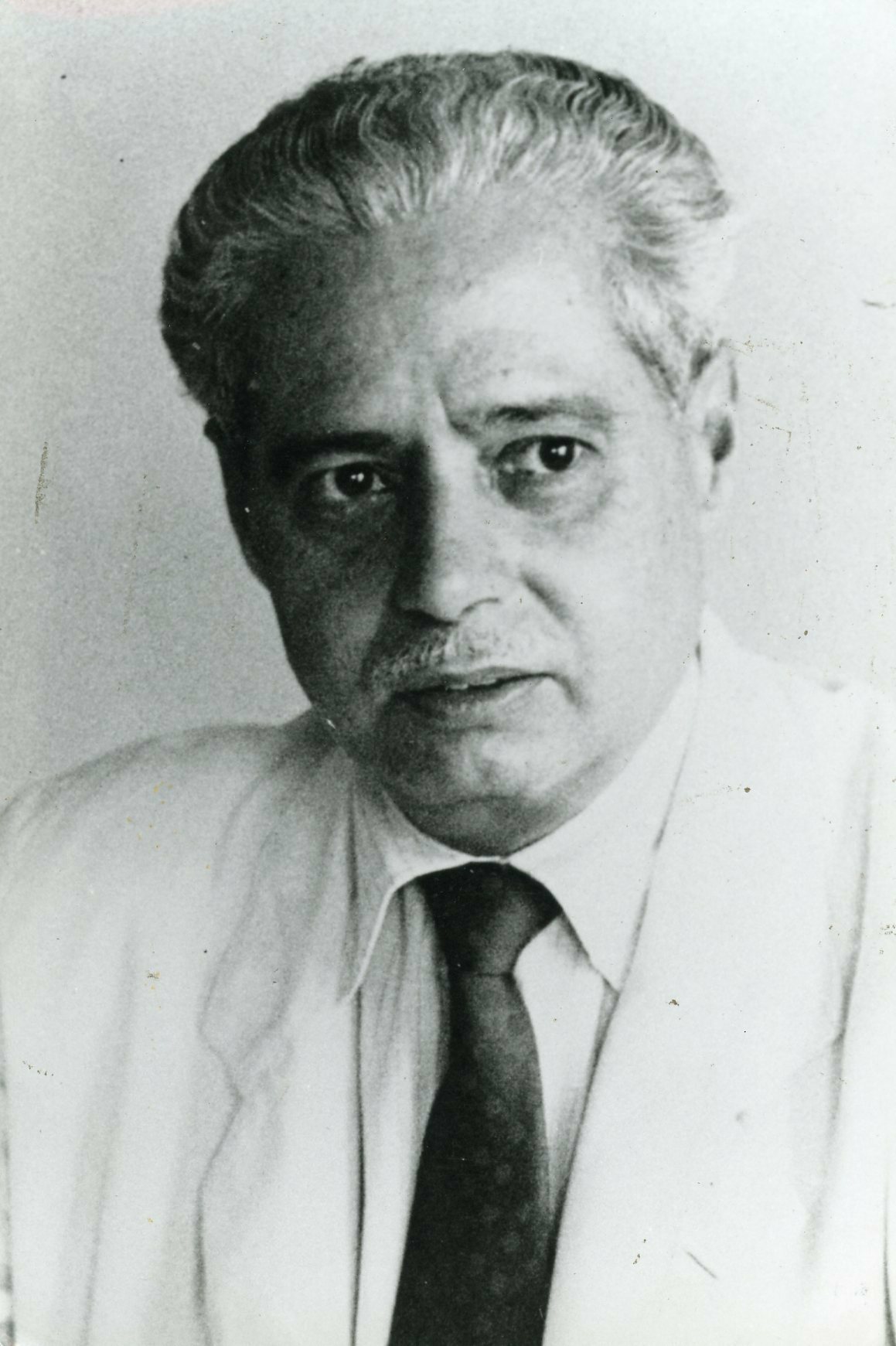 |
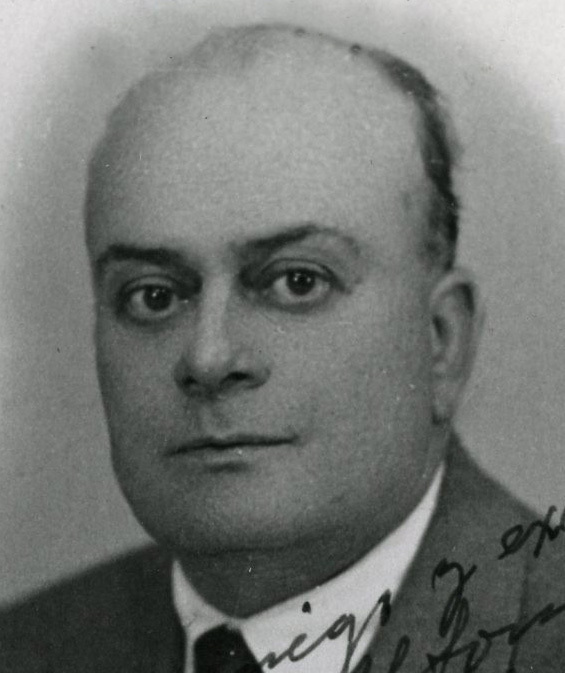 |
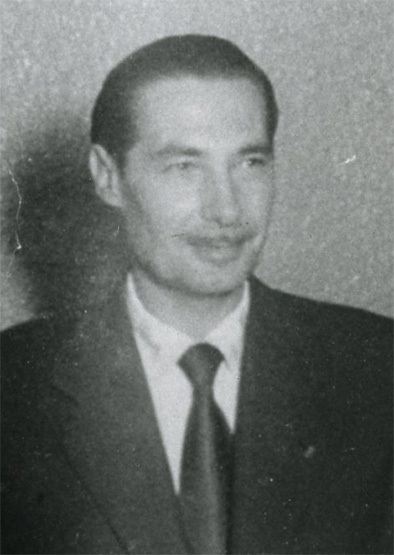 |
| Mr. Adolfo Miranda Ortega | Mr. Manuel Rodríguez Monroy | Mr. Alfonso Quiney Collis |
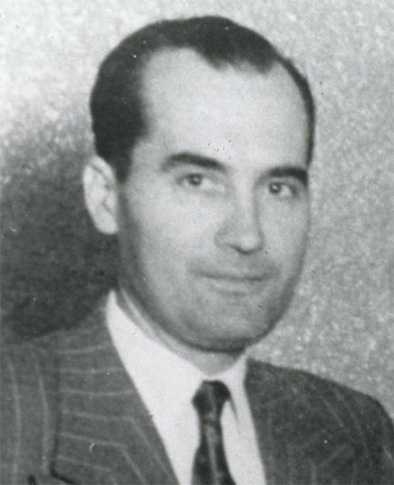 |
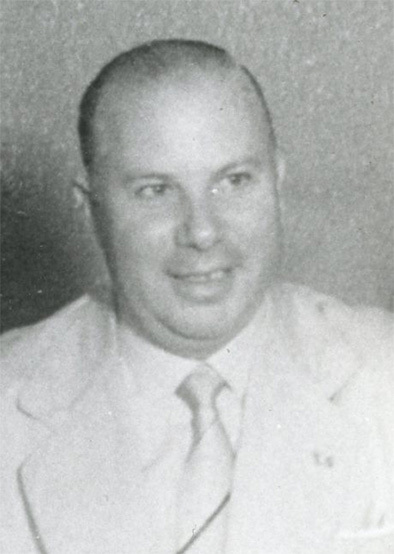 |
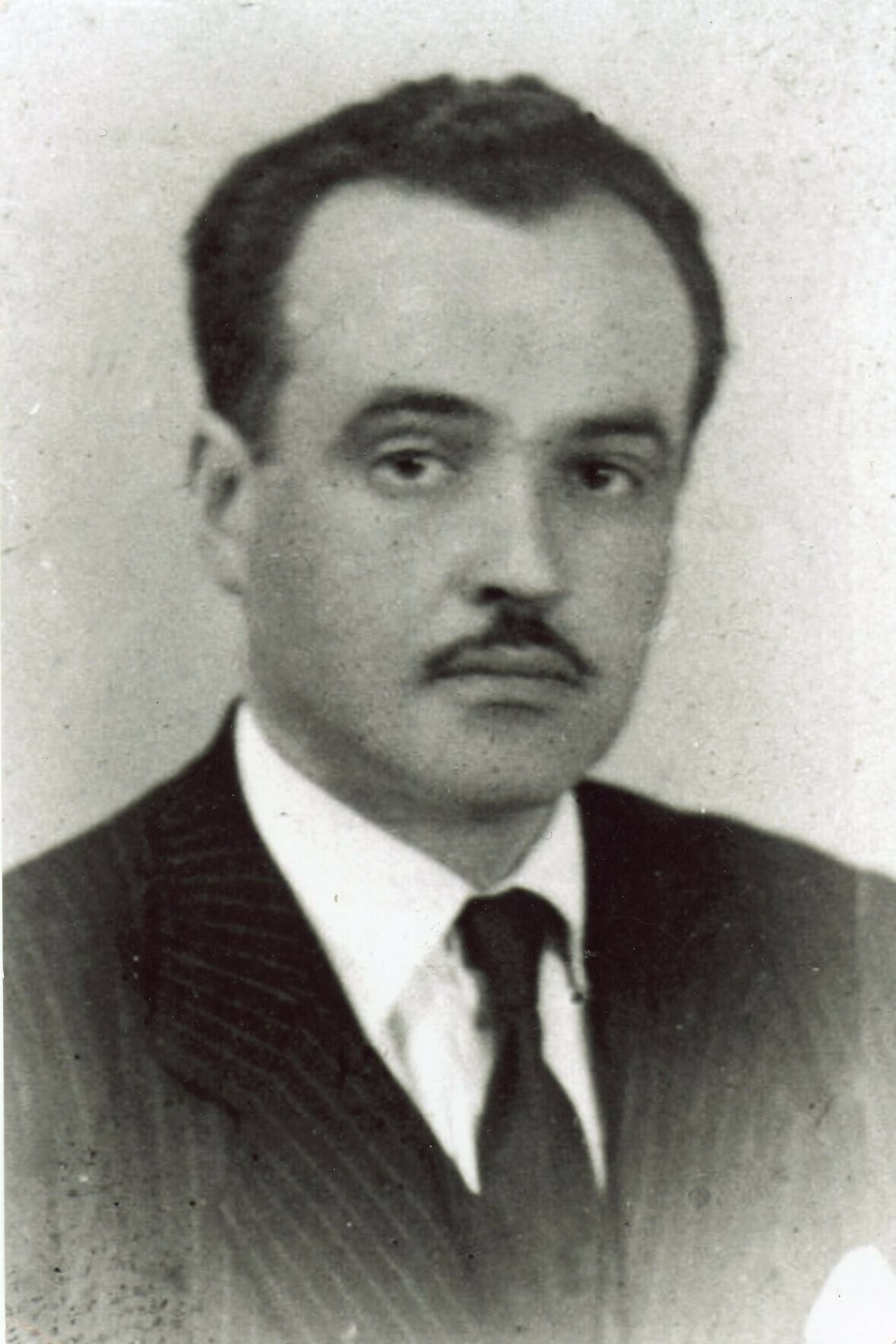 |
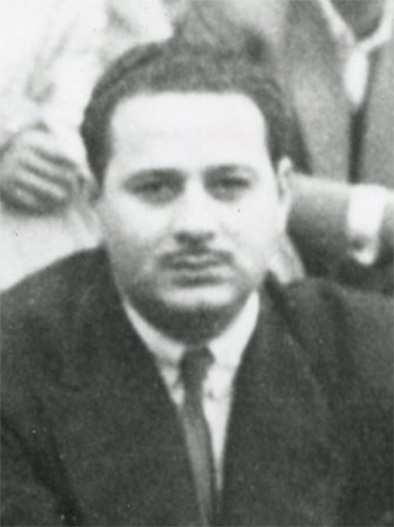 |
| Mr. Manuel Matos del Toro | Mr. Manuel Codorniz Pardo | Mr. Bernardino Correa Viera | Mr. Pelayo Gonçalves Rodríguez |
The Fusion Presentation continues its work.
The Conference, meanwhile, continued to meet every Monday at the Federation's premises. Once the incorporation of our football into the national category was ratified, the five clubs unanimously accepted the following agreements:
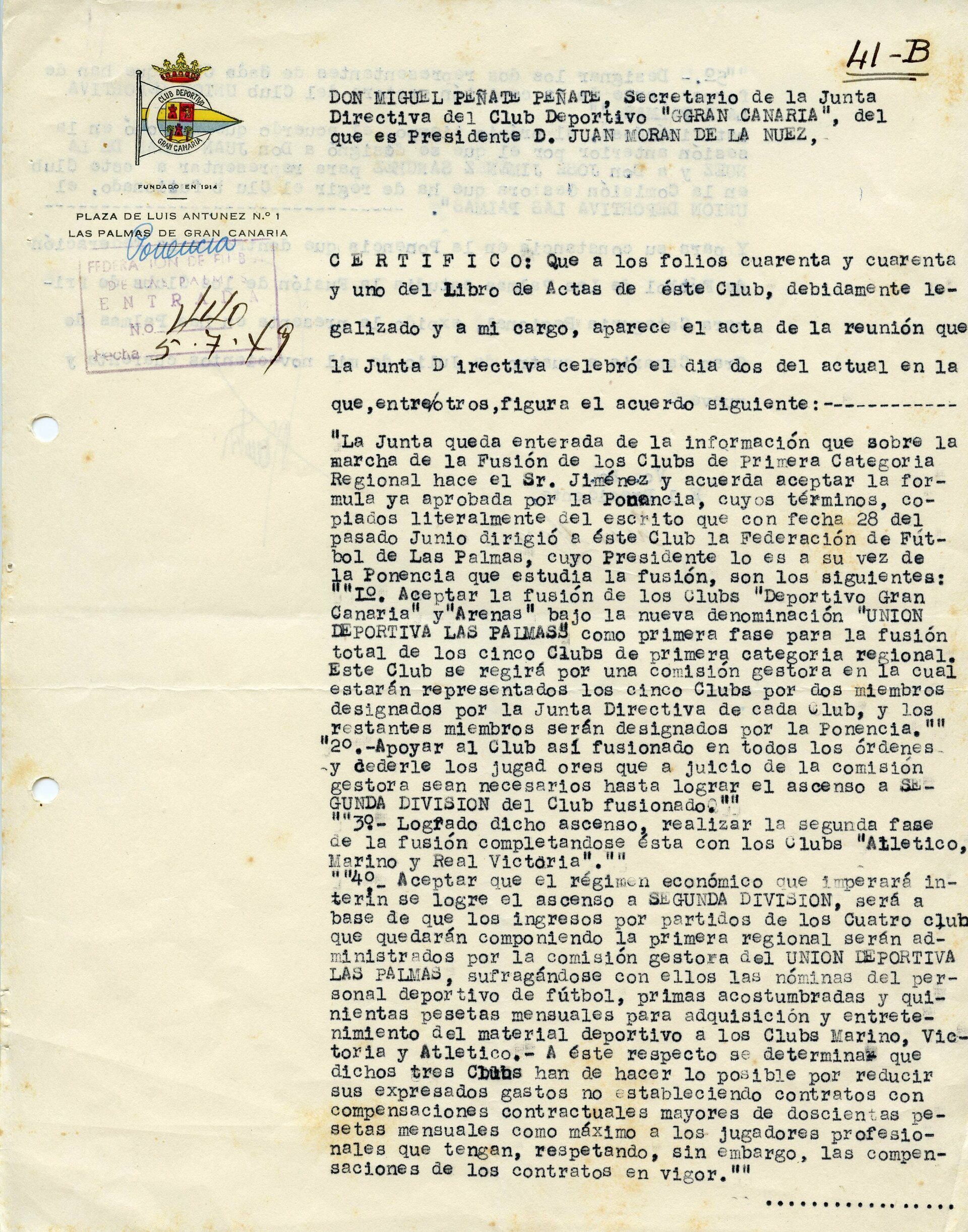 |
| Minutes of the C.D. Gran Canaria where the agreements made by the Merger Presentation are collected once the Canarian clubs were integrated into national football. |
First: Accept the merger of the C.D. Gran Canaria and Arenas Club under the new name of “UD Las Palmas” as the first phase of the total merger of the five First Regional Category clubs. This club would be governed by a new Management Commission in which they would be represented by two members of the board of directors of each club.
Second: Support the merged club in all areas, giving it the players that in the opinion of the Management Committee were necessary, until the merged club is promoted to the Second Division.
Third: Once said promotion has been achieved, carry out the second phase of the merger, completing it with the clubs Atlético Club, Marino C.F. and R.C. Victory.
Fourth: Accept that the economic regime until promotion to the Second Division is achieved would be based on the fact that the income per game of the four clubs that would make up the First Regional would be administered by the Managing Commission of the “single team.”
This agreement would later undergo a slight variation, consisting of moving to the first phase of the merger with Atlético Club and carrying out the Official Regional Championship with only three teams: Unión Deportiva las Palmas, Marino C.F. and R.C. Victory.
Request from Las Palmas Stadium.
Another short-term objective of the Fusion Presentation was to ask the Regional Federation to send a request to the Board of Directors of the Las Palmas Stadium with a view to the acquisition of said sports venue.
This request would initially be contrary to the interests of the Presentation, with the company Marino C.F. refusing. for sale, finally reaching an agreement for its lease. The arrangements for the lease of the Las Palmas Stadium would be carried out directly by Mr. Eufemiano Fuentes Díaz, who explained to those gathered in the Assembly
the conversations that he had held with the different members of the Board of Directors to choose the payment formulas.
This rental fee included the permanent staff of the Stadium, with the lessee being responsible for any expenses, taxes and damages that may occur during the lease.
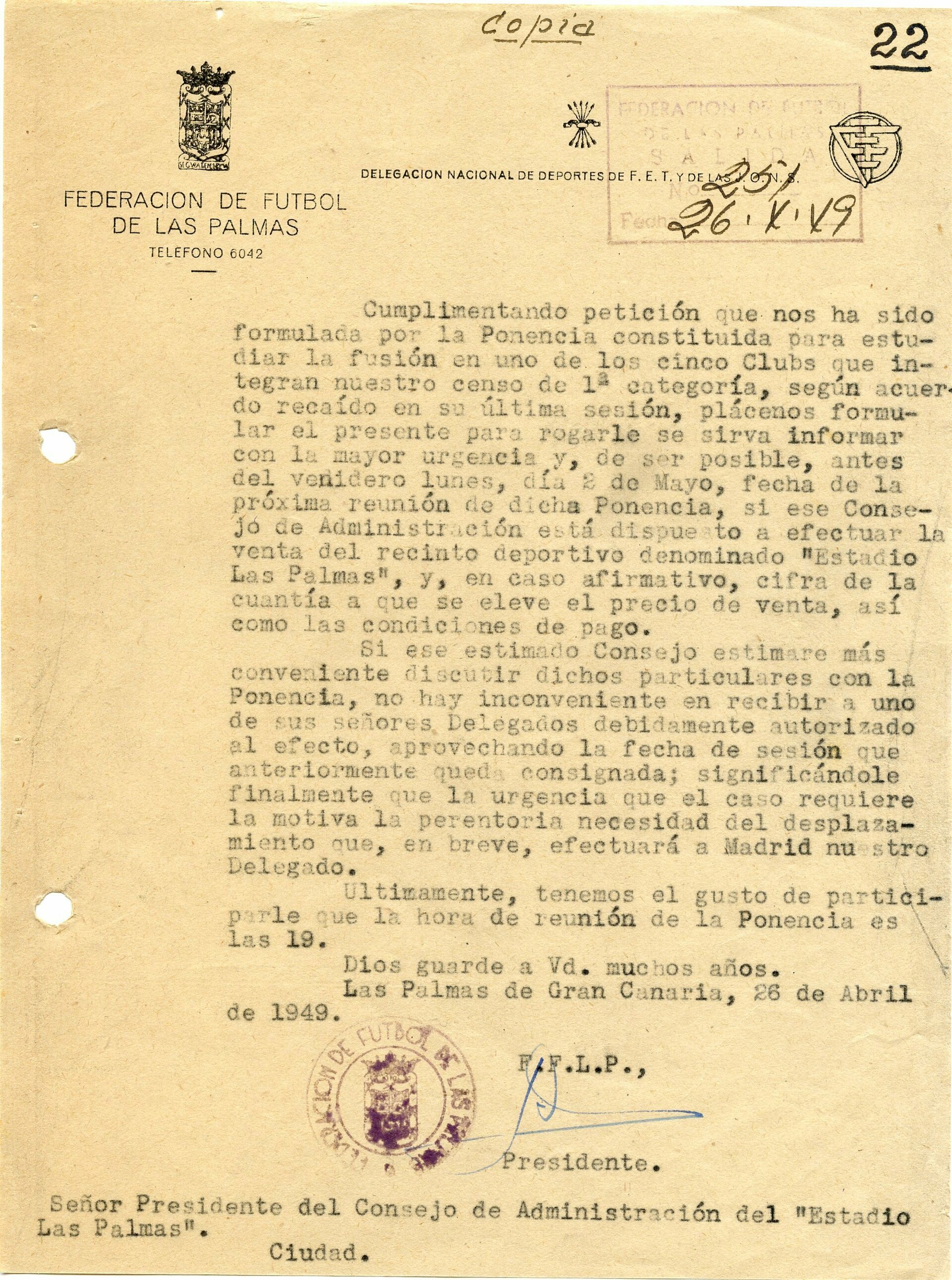 |
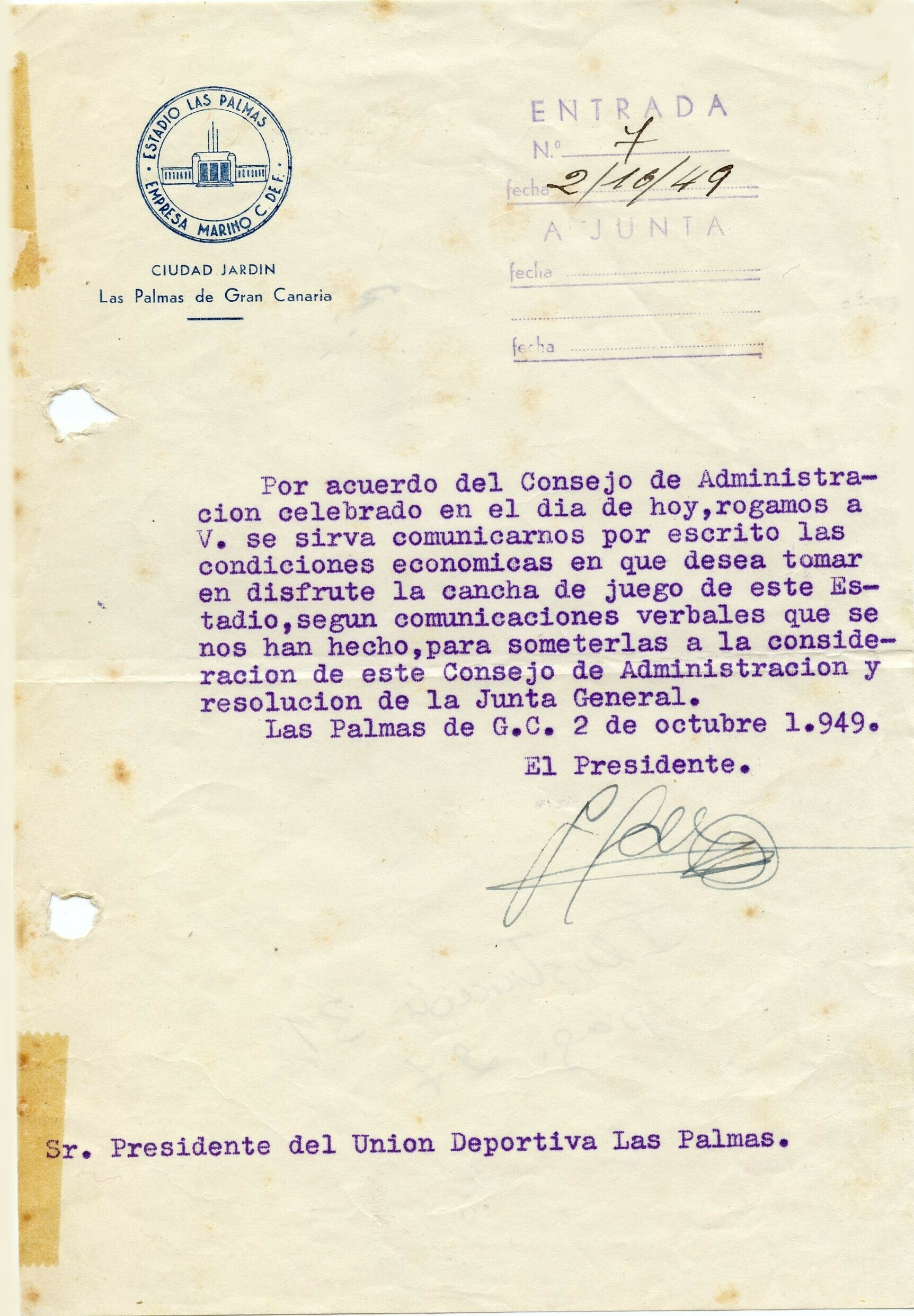 |
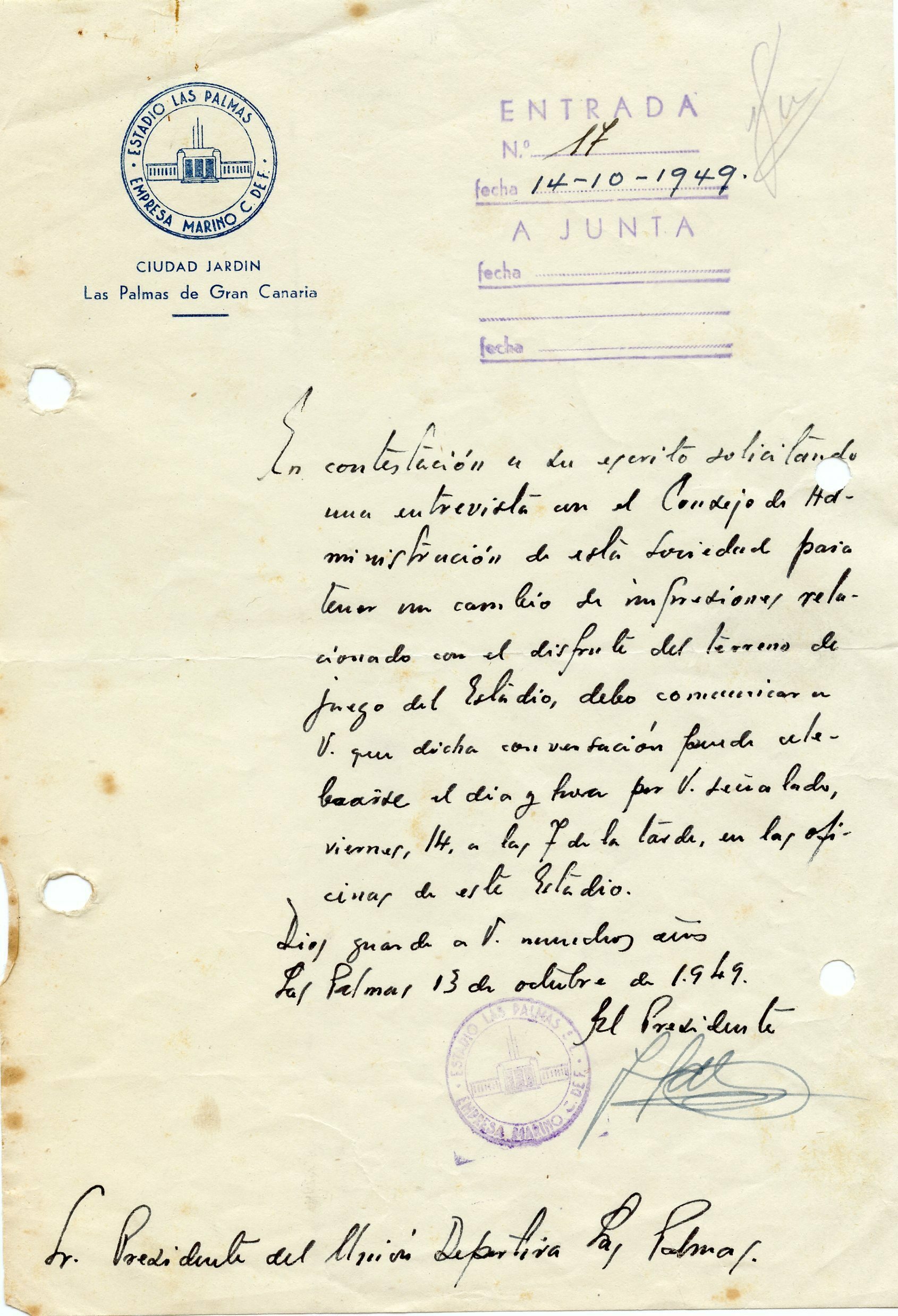 |
||
| Petition letter from the Las Palmas Stadium | Note from the company Marino C.F. owner of the Las Palmas Stadium. | Note from the company Marino C.F. to the president of UD Las Palmas with the purpose of starting talks for its lease. |
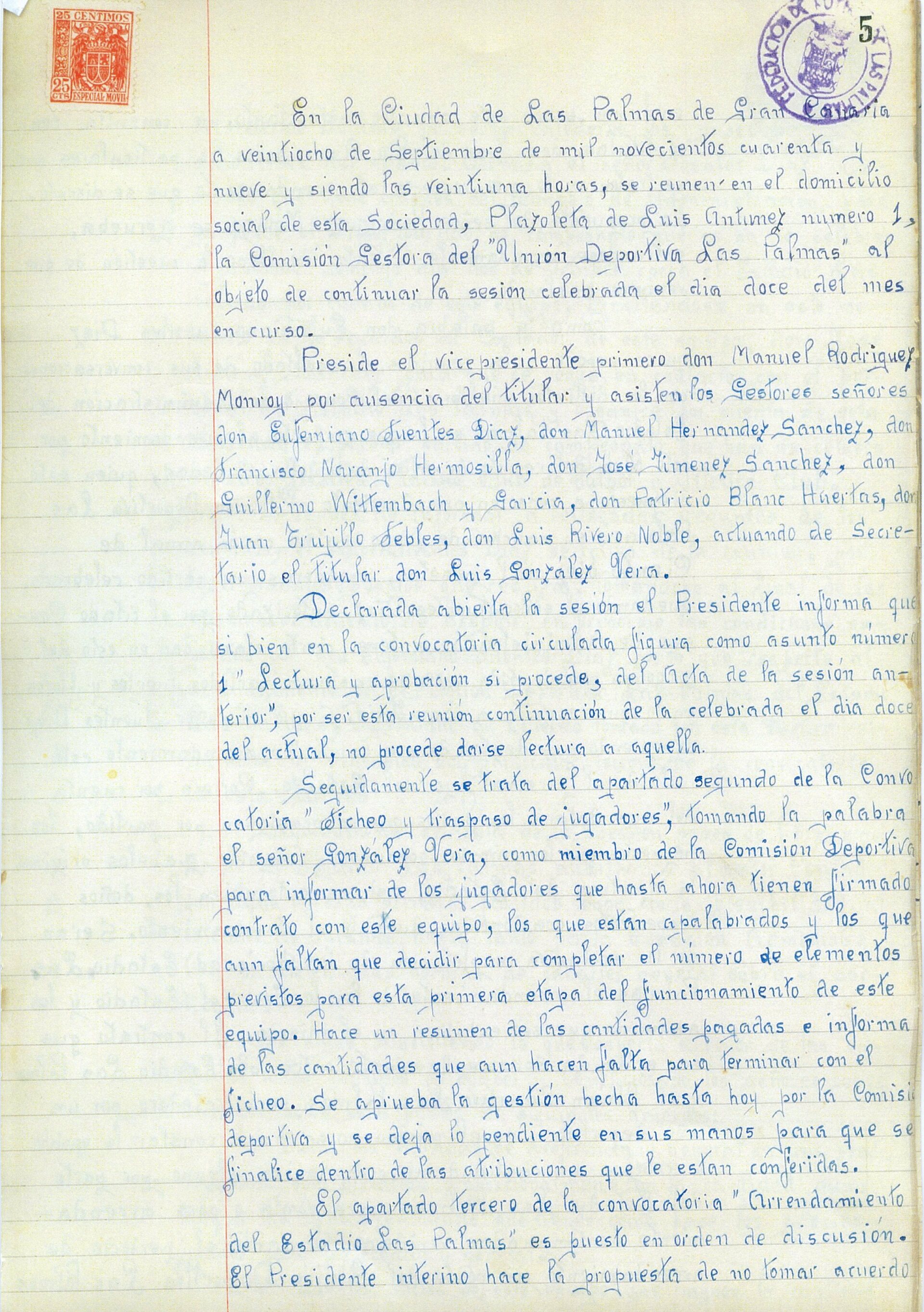 |
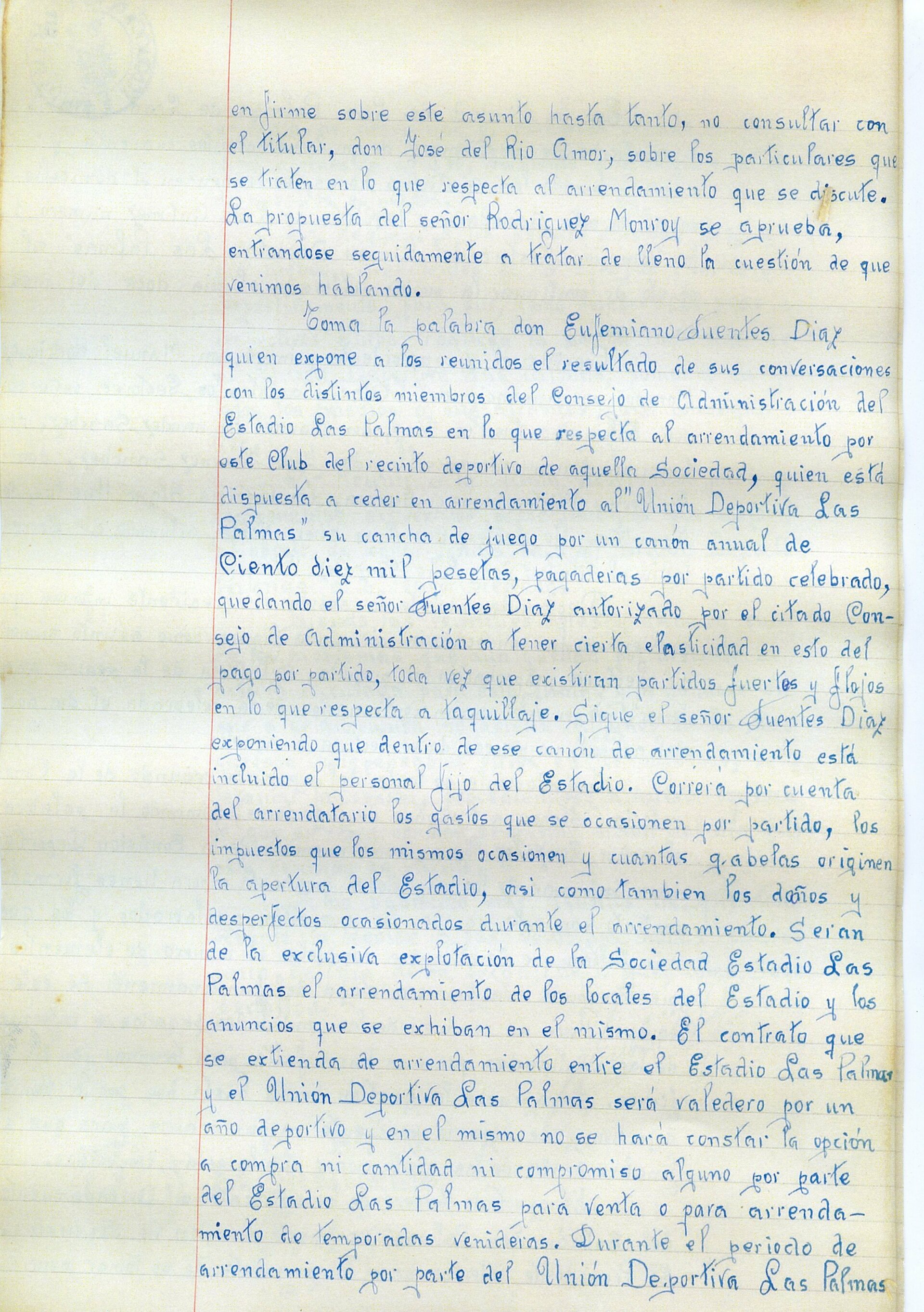 |
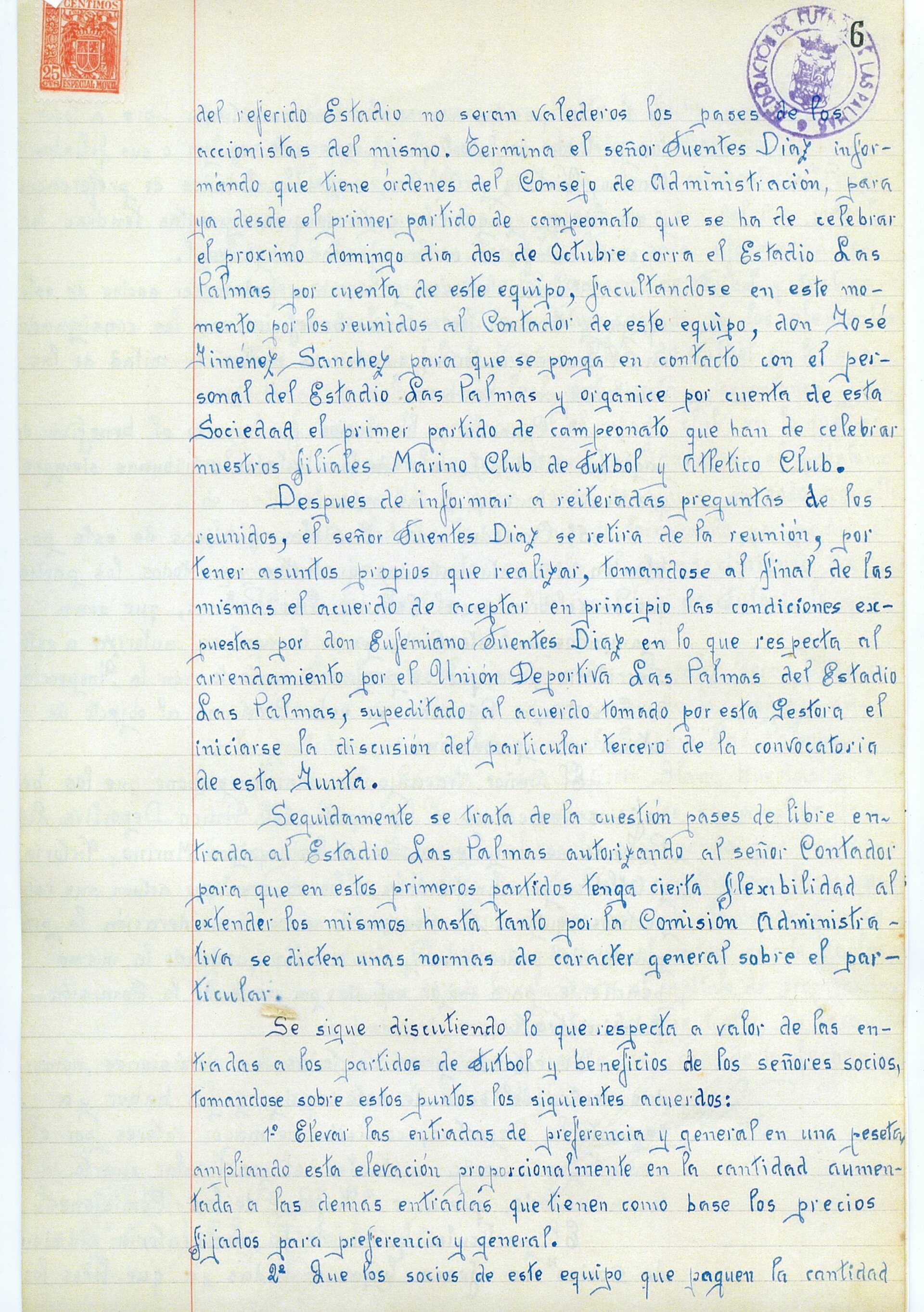 |
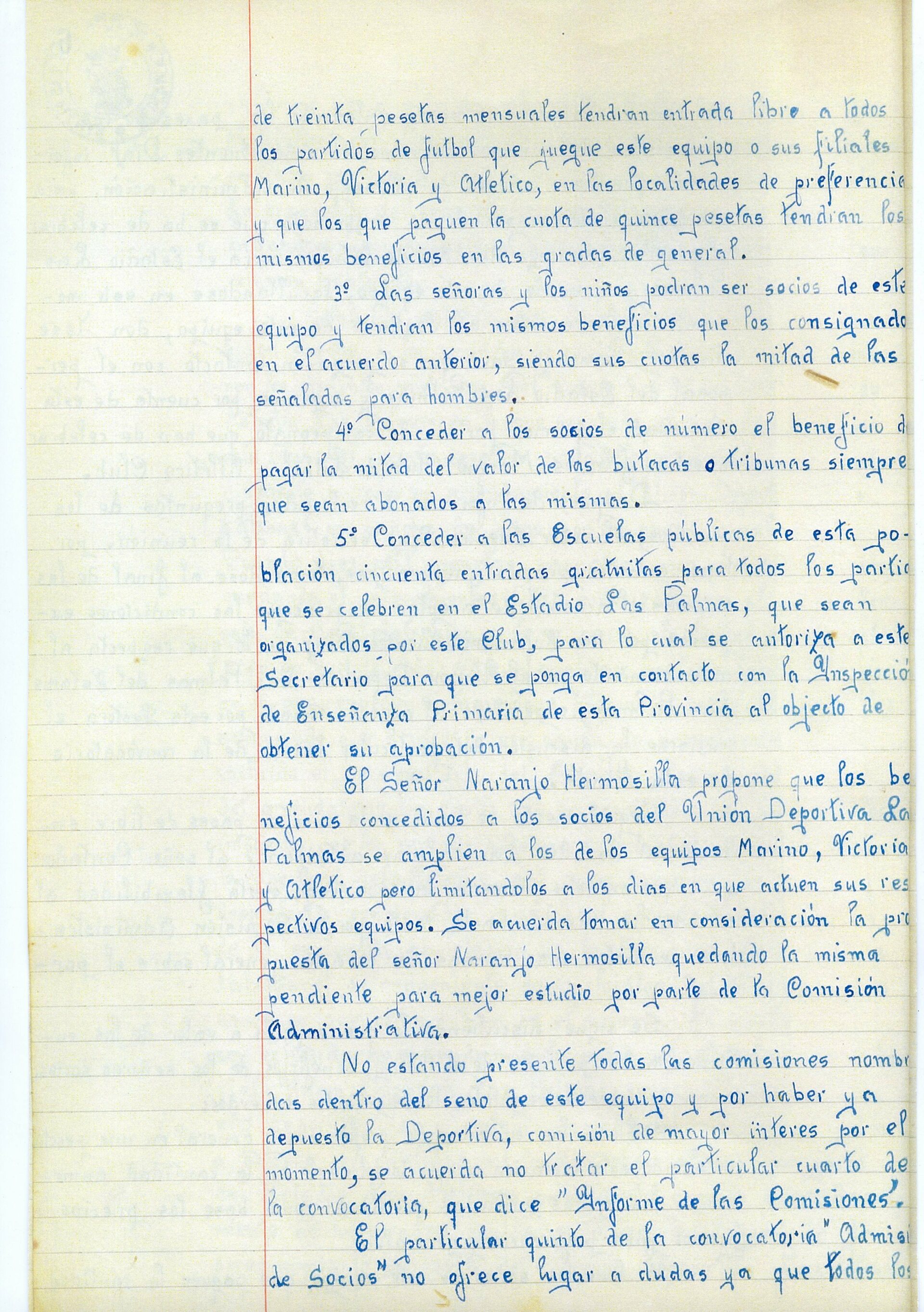 |
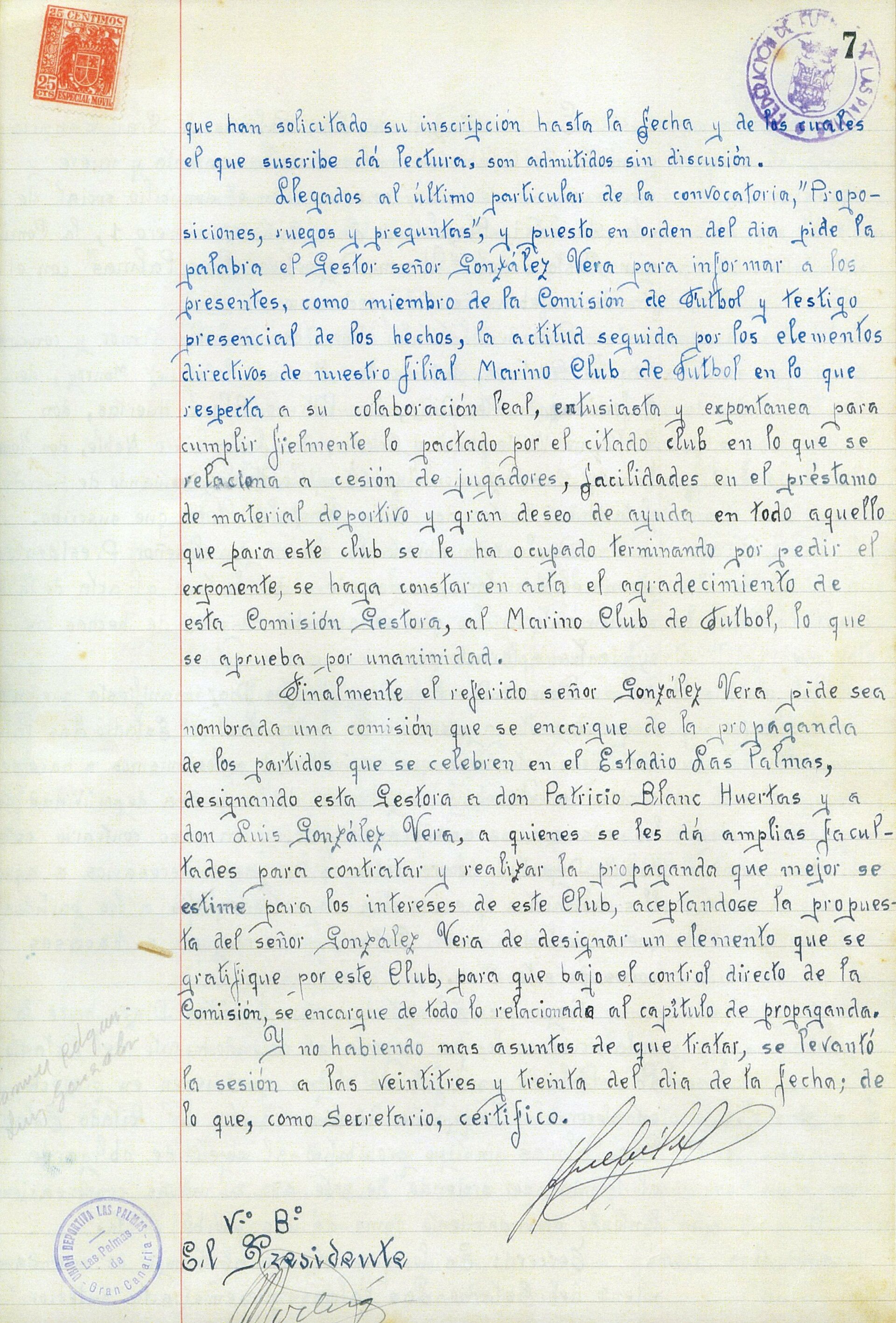 |
Mr. José Jiménez Sánchez: Member of the Merger Presentation and component of the first Manager.
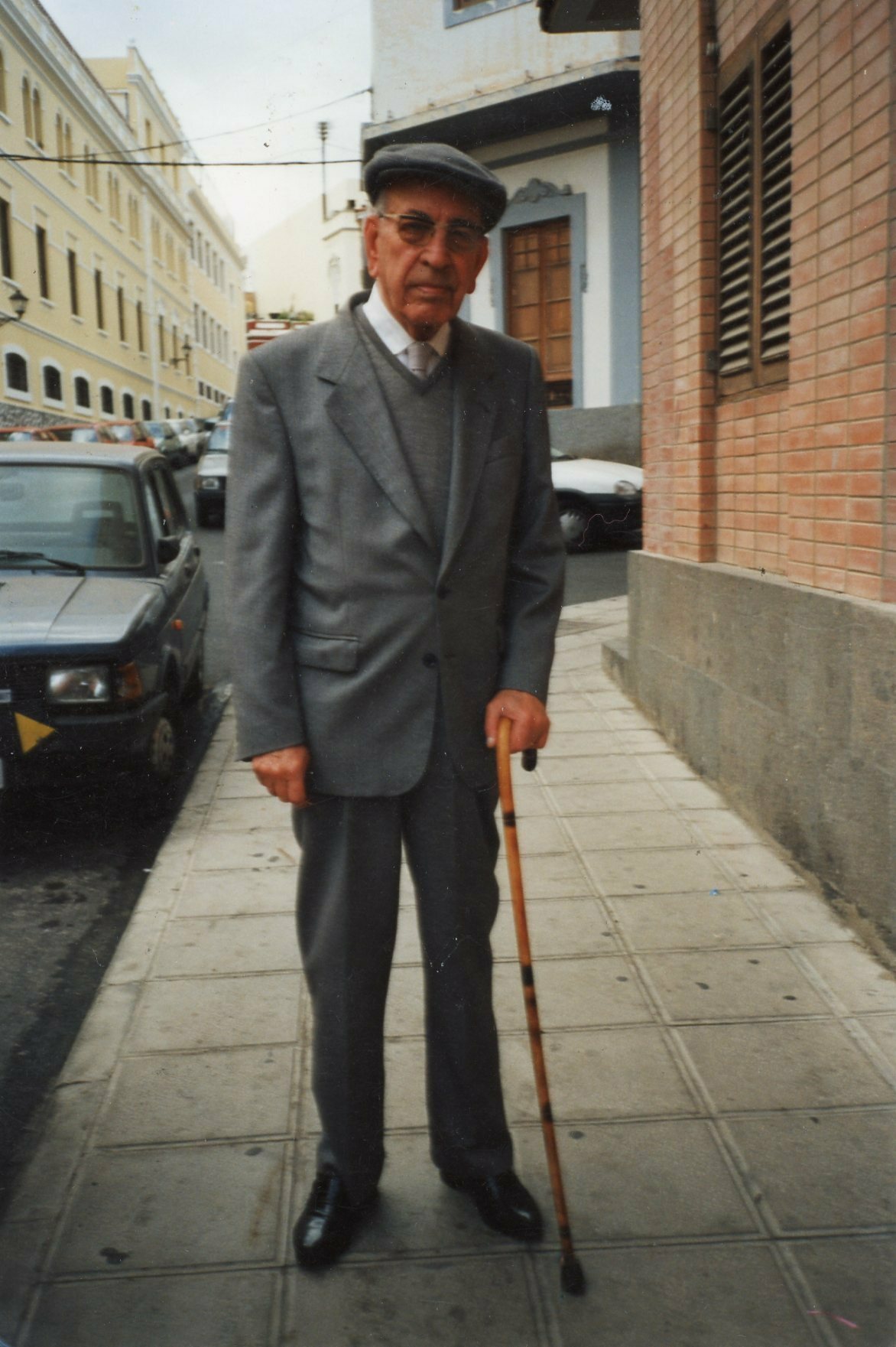 |
| Mr. José Jiménez Sánchez taking his daily walk through the stately neighborhood of Vegueta where he lived until his death. |
Authentic notary of the history of the yellow team since its birth, he was a member of the C.D. board of directors. Gran Canaria in which he would perform various functions until its merger with UD Las Palmas. He was part of the Conference that worked for the creation of the single team and when it became the Magna Assembly of the old R.C. Náutico de Gran Canaria was an integral part of the First Manager of the club and was also the third partner of the entity since its foundation.
Despite the time that has passed, we still remember with devotion his moving words for the first volumes published on the history of UD Las Palmas, which we reproduce literally:
“One day on the way to the stadium to watch a match between the great rivals, Marino C.F. and R.C. Victoria, I met Mr. Manuel Rodríguez Monroy, who expressed to me the idea that he had been developing about the need for the merger.
Far from being surprised, I saw the heavens open given the needs that my club, the C.D., was going through. Gran Canaria, doomed to disappear if urgent measures were not taken. Both the representatives of the Arenas Club and Atlético Club and us for the C.D. Gran Canaria we said yes immediately. The Marino and Victoria clubs raised certain objections and in reality it must be accepted without criticism that there were many disagreements.
To discuss everything related to the Presentation, we continue to meet every Monday at the Federation headquarters located on Domingo Déniz Street in Alameda de Colón.
El Marino could not make up his mind as Eufemiano Fuentes was sanctioned by the Federation and residing in England for a short period of time. The Marinista board, chaired by him, was divided and both its social mass and that of the Real Club Victoria were opposed to the merger due to the great tradition that both clubs had.
When Eufemiano Fuentes returned from England on the steamship “Andes”, Mr. Adolfo Miranda Ortega and Mr. Manuel Rodríguez Monroy were waiting for him at the dock. There would end, in part, all the opposition of Marino C.F.
Given the economic power that Mr. Eufemiano Fuentes exercised in the Marinista entity, the remaining members of the club surrendered to the evidence.
Getting the yes vote from Mr. Eufemiano Fuentes was decisive, since the R.C. Victoria was left alone and would end up gradually giving in.
In any case, it would have to mean that the R.C. Victoria y Marino C.F. They merged only in the sports concept but their recreational societies continued to function with total autonomy, unlike the C.D. Gran Canaria would donate its headquarters with all its trophies and belongings, completely disappearing as a club.
The City Council was asked for the colors of the island's flag and those of the city's shield, bordered with that of the five historic clubs that was designed by Mr. Simón Doreste y Doreste."
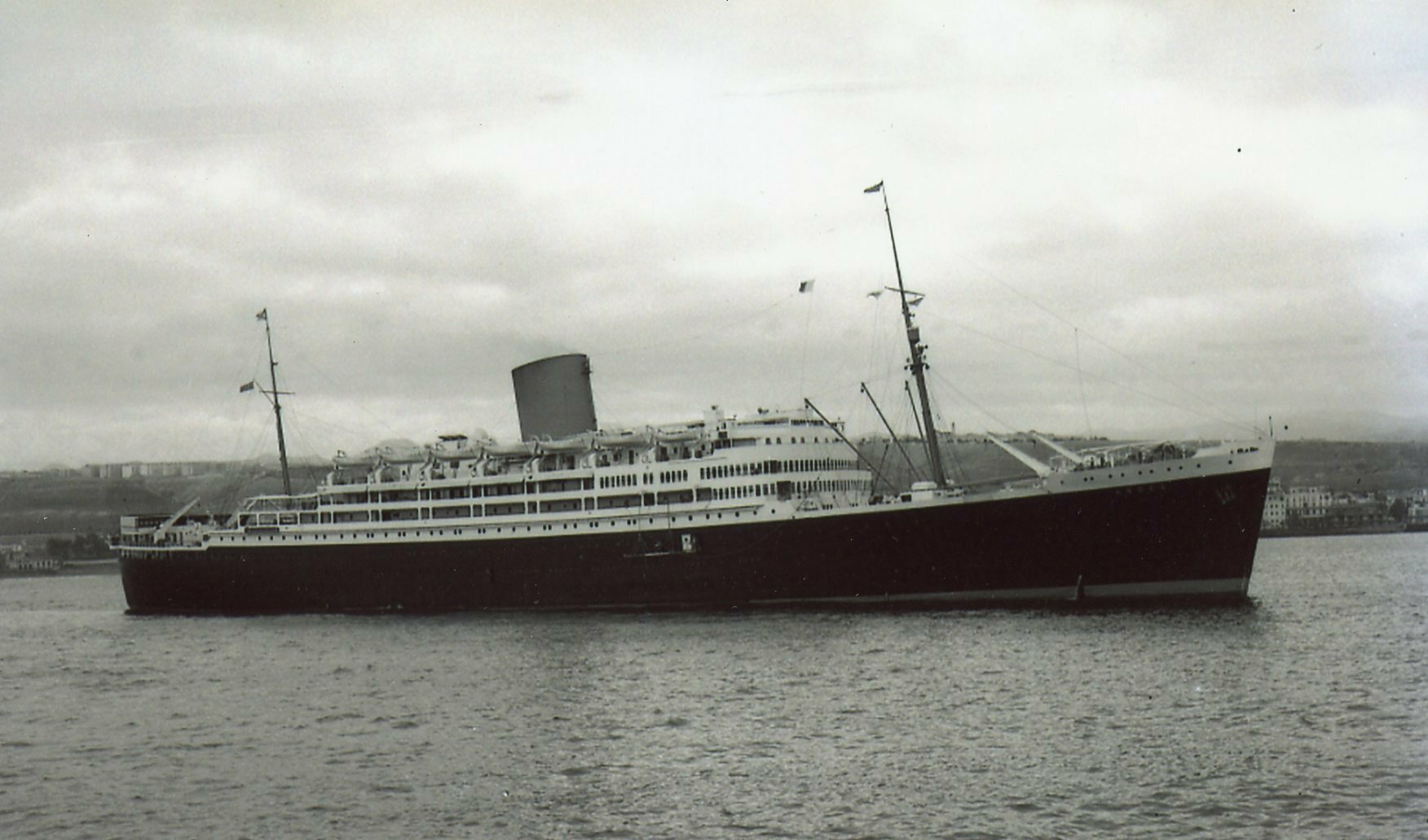
Club name.
“As for the name, it was something more complex. At first, Deportivo Canarias had some strength, but it was rejected for referring to all the islands. I also remember that of Las Palmas and Real de Las Palmas, which were canceled as there was a club with that name at that time.
Finally, we decided, I think with good judgment, to name a team that had been born from the union and effort of all the Canarians, and that would be called the Las Palmas Sports Union.
Integration into national football.
"Integration into national football was very costly." Mr. Valdés Larrañaga, President of the Royal Spanish Football Federation, had had a pleasant stay on the island in 1941, the time of his official visit as undersecretary of labor, stating openly expressed his admiration for Canarian football. Then, years later, when he held the position of President of the Federation, his opinions on our definitive integration into National Football were very different.
The National Federation gave us its approval after many difficulties and with the condition of playing in a previous Regional League that would give us the possibility of playing in a League for Promotion to the Second Division. Such an achievement merited the following comment from the then Secretary of the National Football Federation, Dr. Cabot: “dress the doll well.”
What did he mean with these words? Only he knows, but when we were trying to interpret them, it occurred to us to think about whether we were given the opportunity, convinced that we would fail in the attempt. The doll was dressed in gold based on the results, going in just over a year from playing in regional categories to the First Division of National Soccer.
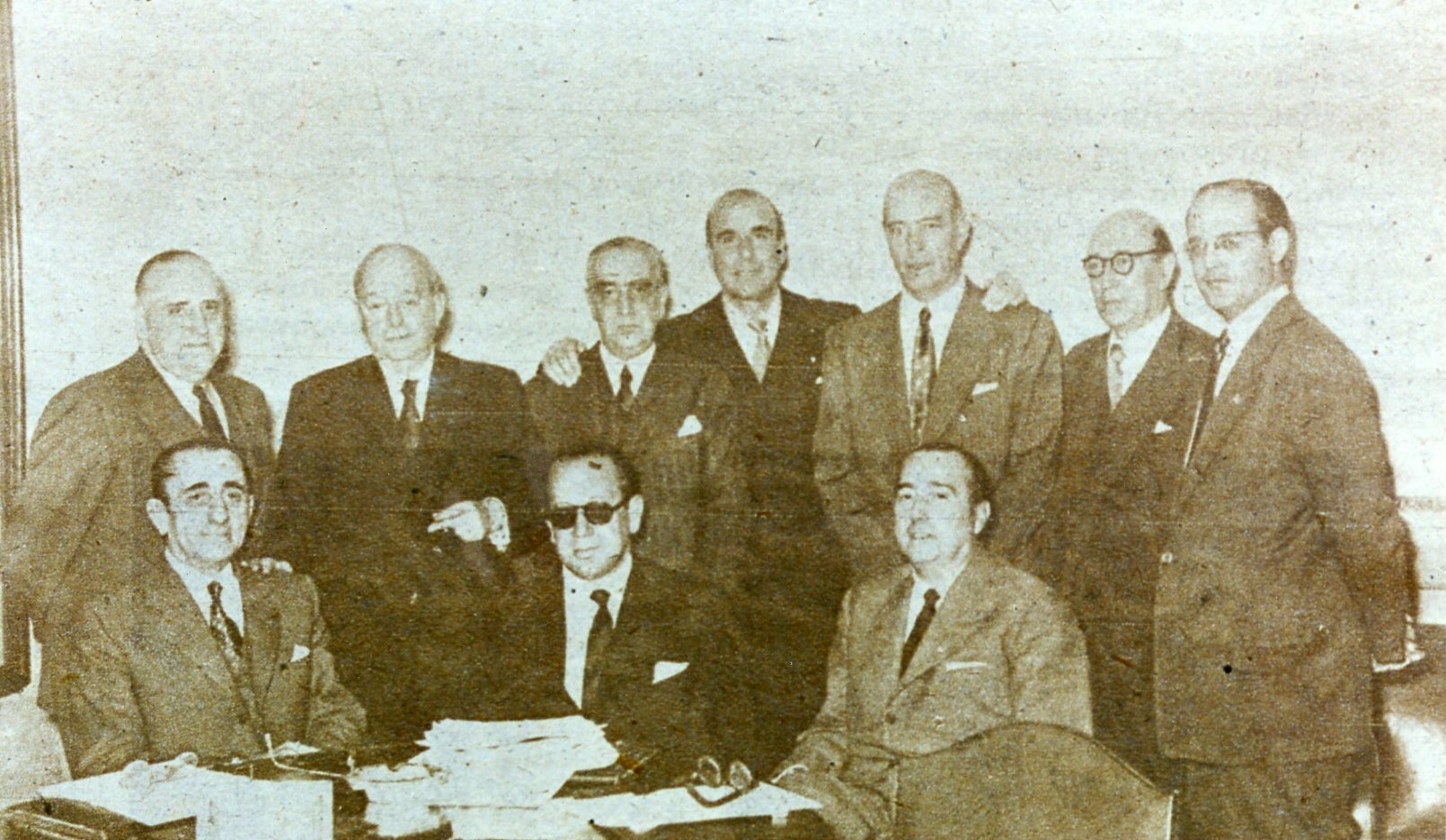 |
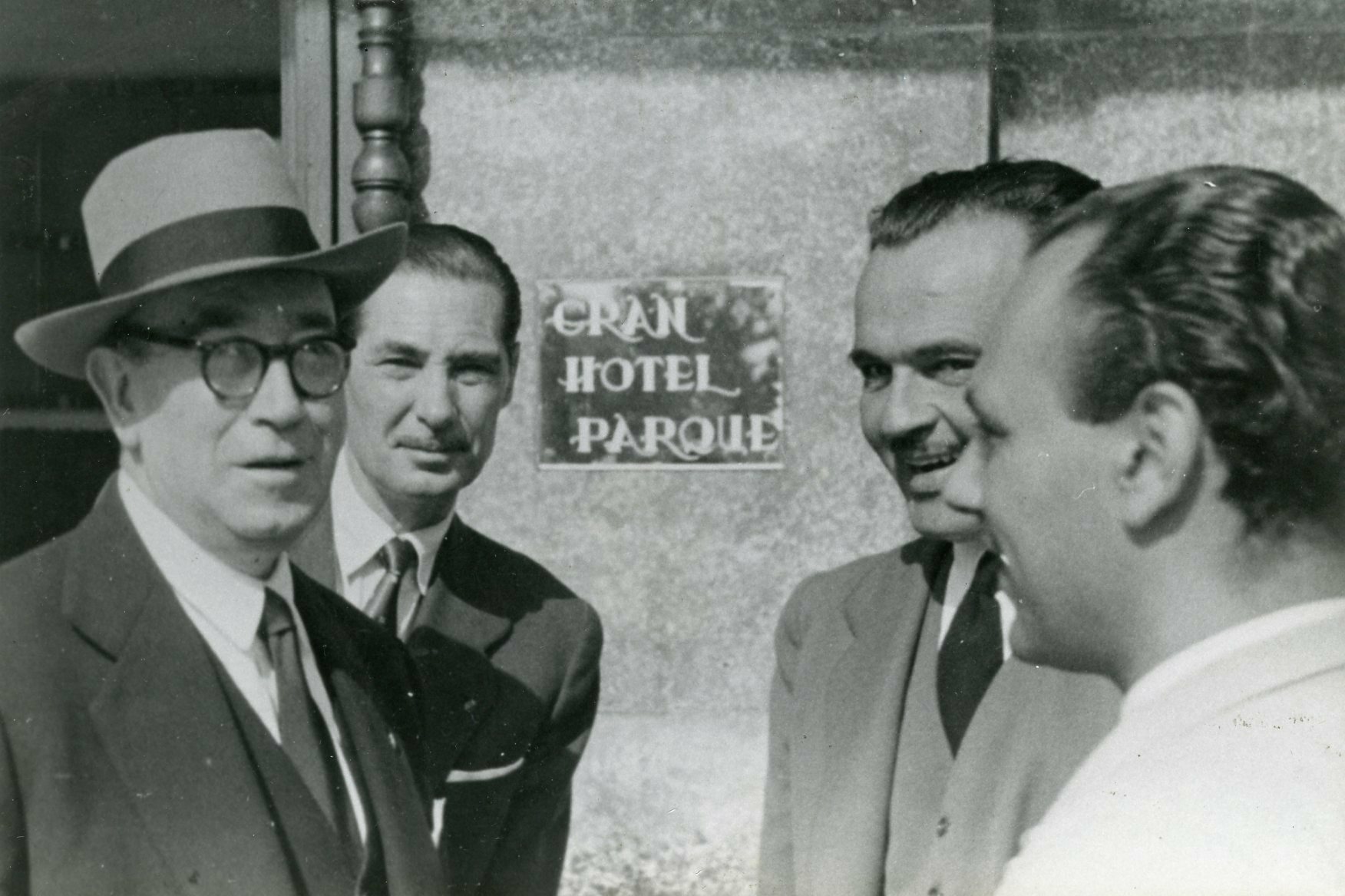 |
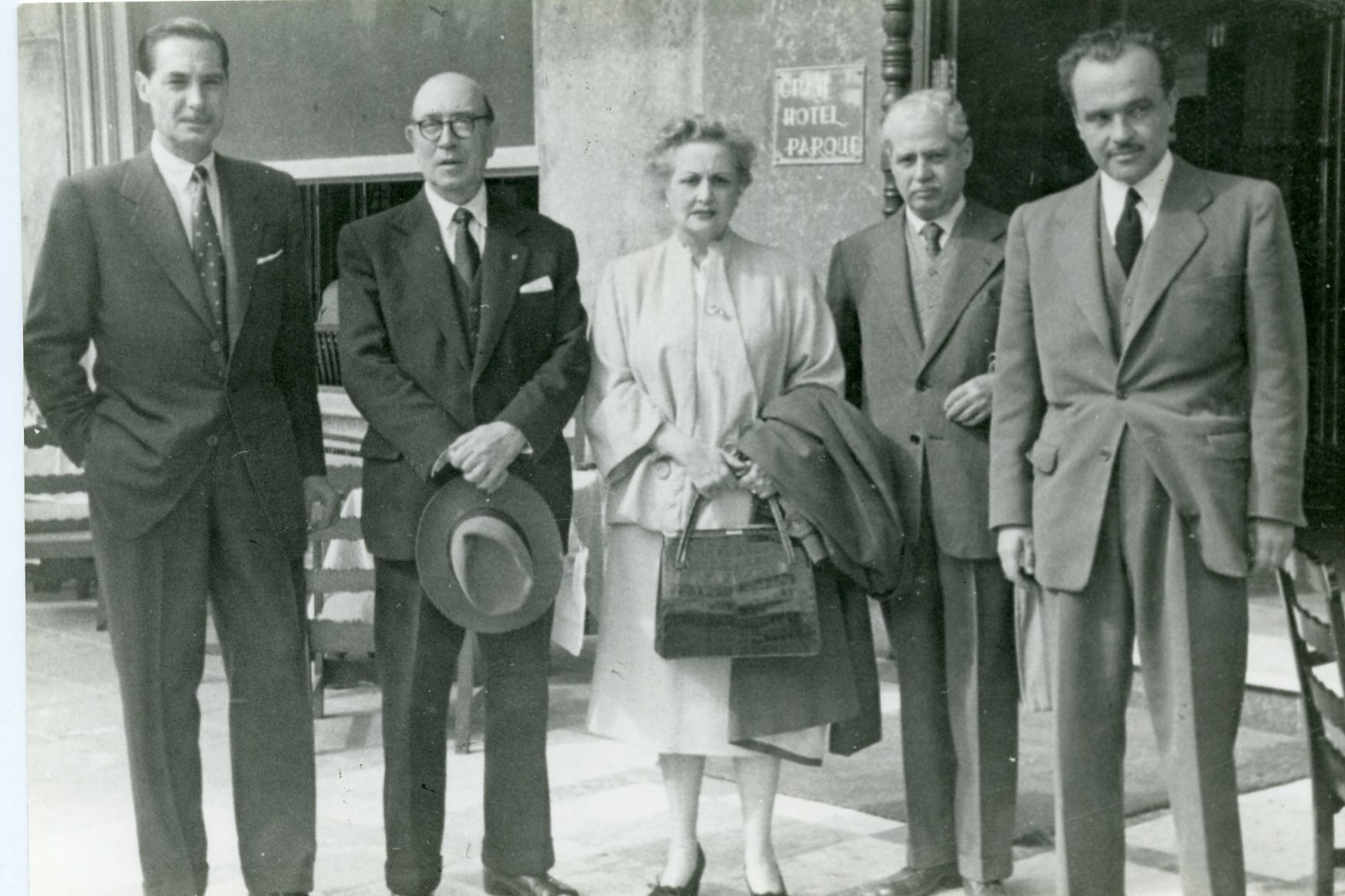 |
| Steering Committee of the Royal Spanish Football Federation chaired by Mr. Manuel Valdés Larrañaga under whose presidency the Canary Islands clubs were integrated into national competitions. | In the snapshot Dr. Cabot, Secretary of the Royal Spanish Football Federation at the entrance to the Gran Hotel Parque, on one of his trips to the Canary Islands. He is accompanied by: Mr. Alfonso Quiney Collis, Mr. Bernardino Correa Viera and a young Martín Moreno, who was then a sports contributor to the newspaper “Falange” and later Official Chronicler of Gran Canaria. | Posing for the camera at the entrance to the Gran Hotel Parque: Mr. Alfonso Quiney, Ricardo Cabot and wife, Adolfo Miranda and Bernardino Correa Viera. |
Mr. Luis González Vera. First General Secretary of the club.
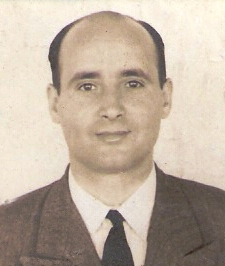
He was born in Las Palmas de Gran Canaria in 1917. He used to go hand in hand with his father to the games played at the old Campo España and even in his later years he remembered those experiences with great precision and detail.
Like other boys from Puerto de la Luz and by family tradition, his preferences were directed to the R.C. Victory. However, due to circumstances in his life, he would become the top leader of the Arenas Club. Like the other representatives of the historic clubs, presiding over said entity, he was summoned to a meeting at the Las Palmas Regional Football Federation where the birth of a unique team was already taking shape.
An extroverted man with a great sense of humor, he willingly agrees to the dialogue, apologizing for any memory lapses he might have:
”My beginnings in the yellow entity go hand in hand with those of the same club, since I was a member of the Fusion Conference that established the U.D. Las Palmas.
Being president of the Arenas Club, they called me to a meeting at the Regional Federation premises. I had not heard anything about the creation of a new club and all that took me a little by surprise. However, the Arenas Club was mired in a serious economic crisis that was difficult to solve. From that day on we continued meeting every Monday to discuss any difficulties that could arise. The CD. Gran Canaria, Arenas Club and Atlético Club would give the approval from the beginning. Another thing would be Marino and Victoria who put up a lot of resistance. When the Magna Assembly was held in the old R.C. Náutico, the UD Las Palmas was established and a Management Committee would be appointed, with the work of the Fusion Presentation being concluded."
“I was the first Secretary General that the institution had, although in reality we all came to lend a hand in whatever was needed. We had no staff and the club's coffers were completely empty. We worked intensely for many hours, filling out forms, cards, taking minutes, etc...
Very different from today's managers. They were years of real hardship that we tried to make up for with great dedication. I even helped with ticket sales or was a delegate alongside Mr. José Sánchez, affectionately known by the nickname of Pepito Pellagofio, true alma mater of the team and in my opinion the most beloved manager that UD Las Palmas has ever had. his story."
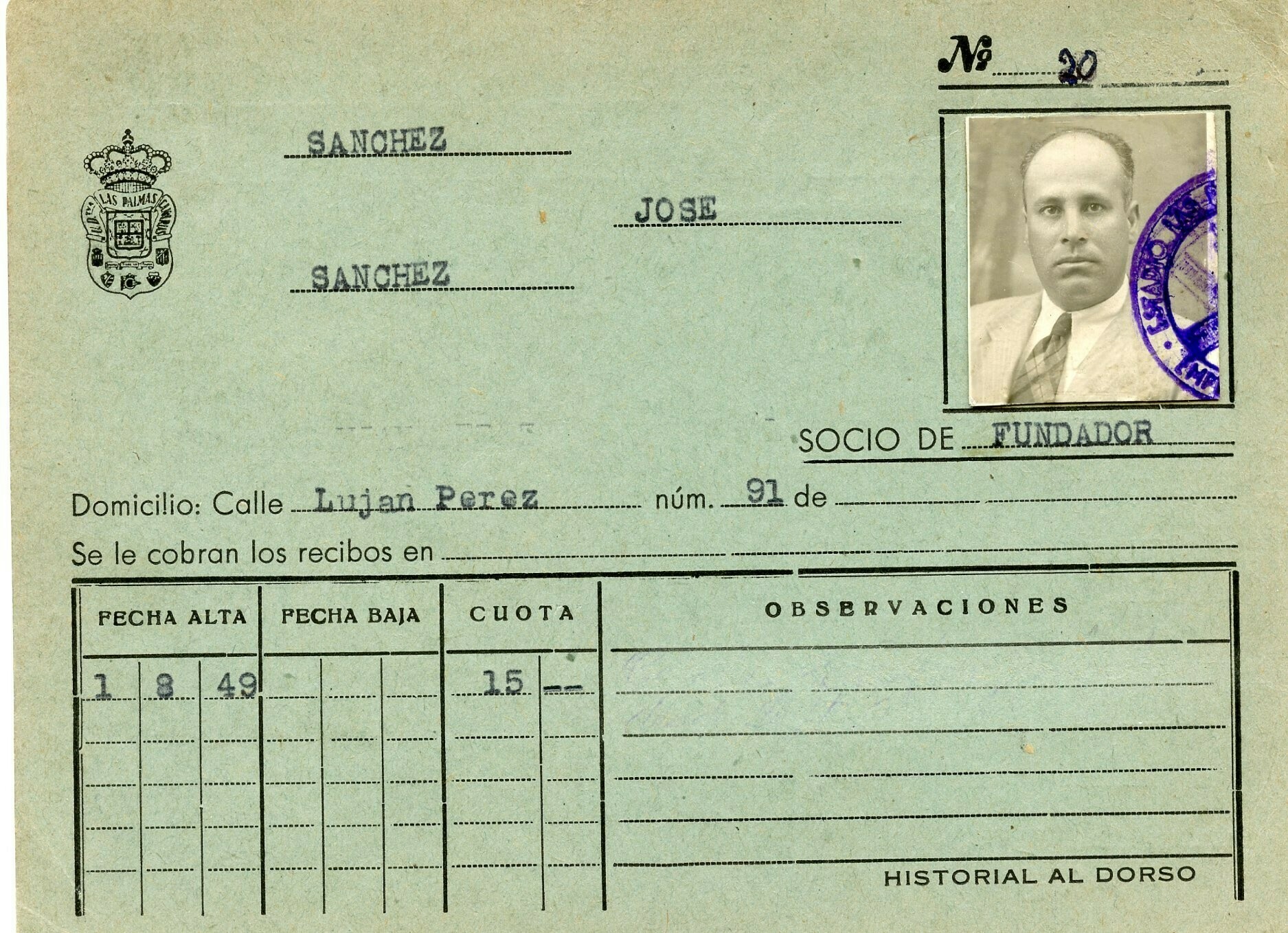 |
| Mr. José Sánchez y Sánchez, first liaison delegate of the UD Las Palmas. |
"Over time my father spoke with Mr. Lázaro Guerra, who worked as an administrator at the Peña Ateneo Los Amigos (Pala) Club in Playa de las Canteras. Mr. Lázaro Guerra was the first employee the entity had."
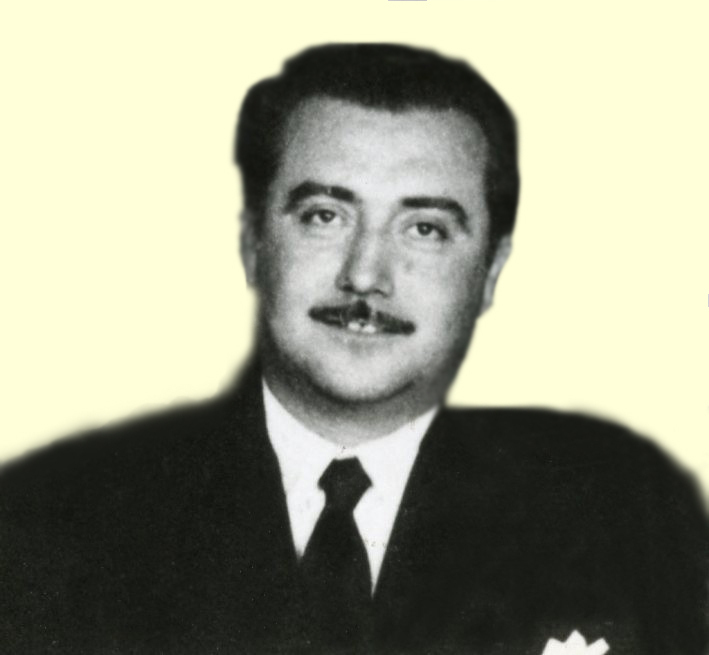 |
| Mr. Lázaro Guerra, former administrator of the Peña Ateneo Los Amigos Club (Pala) and first employee of the yellow entity. |
"In the same way, we should thank the collaboration of many supporters who worked selflessly at the club, as much or more than the members of the board of directors themselves.
Among these I could mention Mr. Bernardo Navarro, Expedito Calderín and Rivero Noble who would come to join as leaders.
On another occasion I was a coach with Trujillo Febles. Arsenio Arocha had been fired and for some reason, Carmelo Campos could not come to training. Trujillo Febles and myself took charge of the situation and since we didn't have the slightest idea about training methods, we asked the masseuse Juanito Gil about the exercises to do, which we then passed on to the players.
Time has followed its inevitable course and due to my age and my state of health I no longer go to the stadiums although I follow its trajectory with interest through the media. You must understand that I was one of the members of the Fusion Conference when the club was founded and constituted. For this reason, UD Las Palmas is for me like a son that you have seen be born and grow."
Financing of the club in the founding years.
Apart from the modest contributions of the Cabildo and City Council, it was financed from the social mass, which in the beginning was very small. Following the promotion to the First Division in the heroic match against Málaga, everyone wanted to become members. Although July 8, 1951 is a date very distant in time, the entity has never had, in proportion to the demographic index, the number of eleven thousand members that was achieved at that time.
In all honesty I have to admit that those players were made of different stuff. They were, in my opinion, the last players of the race, authentic gladiators who fought unspeakably to defend colors deeply rooted in our land. That was undoubtedly a very patriotic feat and that founding spirit has been totally lost.
We must understand that football has become excessively professionalized and today other interests take precedence.
When they ask me what I remember from that first time, the same answer always comes to mind:
What I remember best is Juanito Tacoronte's father running after me through the hallways of the old headquarters to ask me for money. I had given orders to Cristóbal “el Chato”, in charge of the material, so that he would notify me immediately as soon as he saw them arriving. This way, I had time to jump out the window that was on the side of the old headquarters. Although this story may seem comical, it is true reality. I hit myself more than once by throwing myself out of that rickety window, although, when there was money, they tried to satisfy them little by little. It was necessary to understand that they were neighborhood kids, from very humble families and most of them supported their own homes. If we didn't pay it was because there was no money. The company was surviving in a miraculous way thanks to the generous contribution of some managers who even paid for travel. I could mention a good number of them but especially Mr. Eufemiano Fuentes who contributed large sums of money.
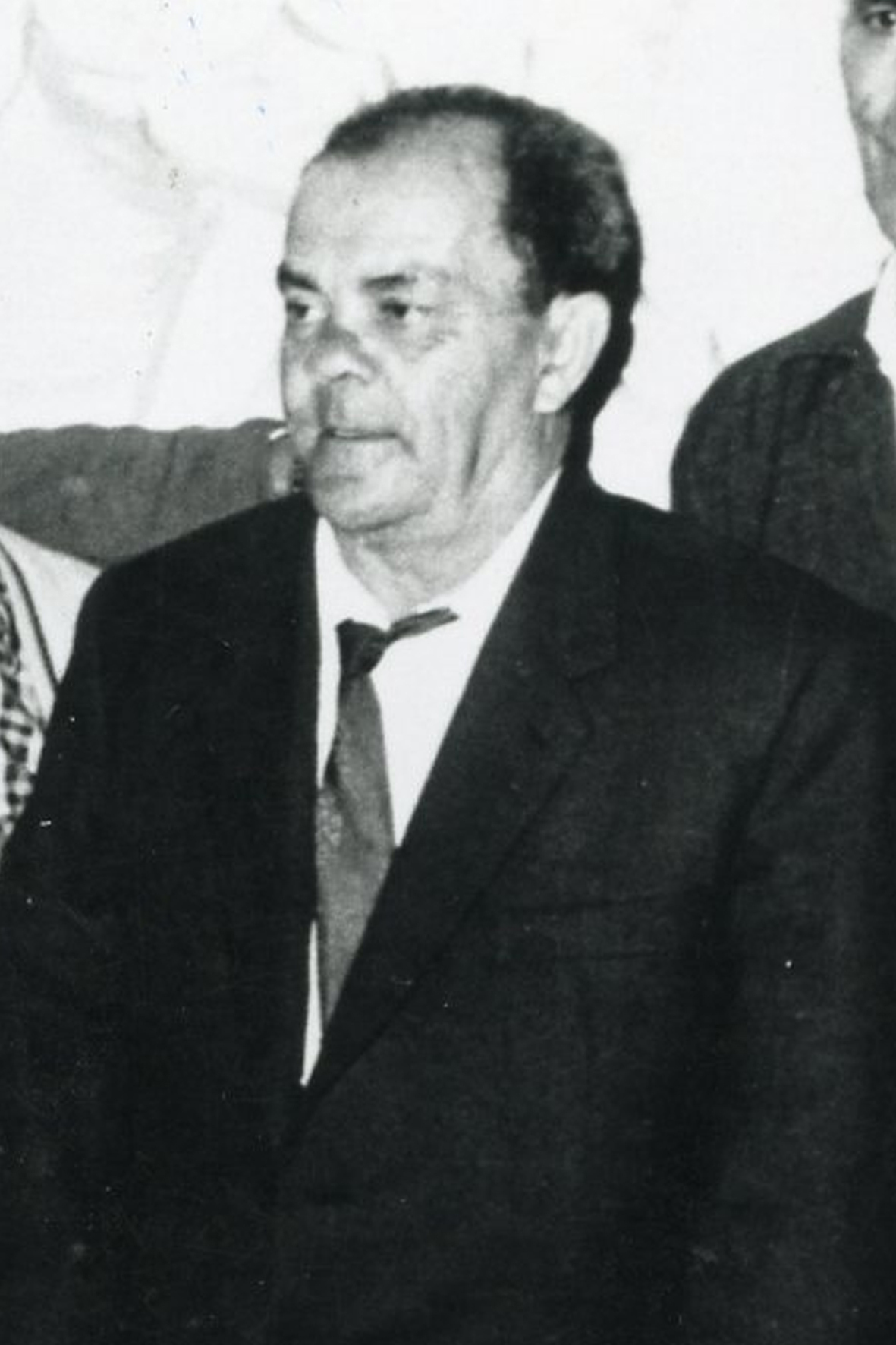 |
| Cristóbal “El Chato” |
Anecdote from Mr. José del Río Amor.
The first president that UD Las Palmas had was Mr. José del Río Amor, a socially relevant person and something that many people who are not very old are unaware of: a former great winger from the first years of our football.
He was a perfect gentleman, with extraordinary human quality, but his multiple occupations did not allow him to dedicate himself fully to the institution. The memory of him brings to mind a very nice anecdote. On one occasion he urgently called an extraordinary meeting to raise the issue of his resignation. The entire board of directors had been informed in writing in advance, giving the news a very important nature. We all met at the headquarters and seeing that the hours passed and the president did not appear, we believed that something serious could have happened to him, trying to locate him without positive results.
The next day I received a letter addressed to me at the club. It was from President José del Río Amor excusing himself for not having been able to attend the meeting because he had gone to the movies with his wife, completely forgetting about the meeting.
Despite this nice “lapse”, Mr. José del Río Amor was a very upright man, having managed to gain well-deserved prestige in Gran Canaria society.
With Eufemiano Fuentes he was different. We were friends since childhood and the treatment was more relaxed.
He had a very strong temperament. Perhaps for this reason he was not very popular among fans and players. However, I think that he has been the president who has contributed the most to the institution.
Apart from his great dedication to the entity, he put his personal assets at the service of the club and I would dare to say that if UD Las Palmas exists, it is largely thanks to him. It must be recognized that in the first years the club's coffers were completely empty and in difficult times Eufemiano knew how to cover travel expenses in full.
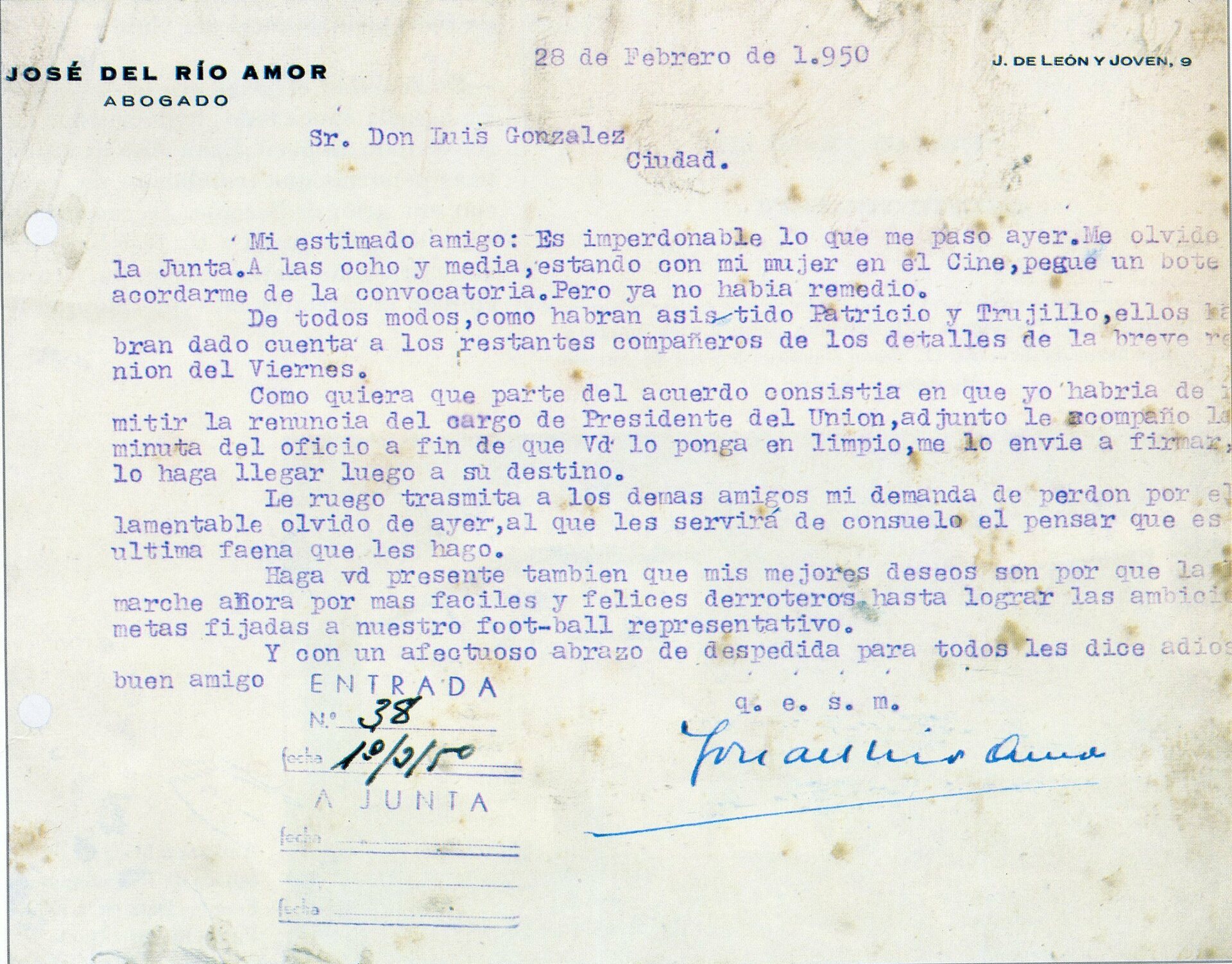 |
| Letter from the first president of UD Las Palmas, Mr. José del Río Amor, addressed to the Secretary General, Mr. Luis González Vera, apologizing for having forgotten about the extraordinary meeting. |
Apart from the meetings at the club's headquarters, we met at their old brick factory or at the tobacco factory on Pamochamoso Street, now converted into a garage.
In that old factory, among papers, cigarettes and cigars, important agreements would be made about the life of the club.
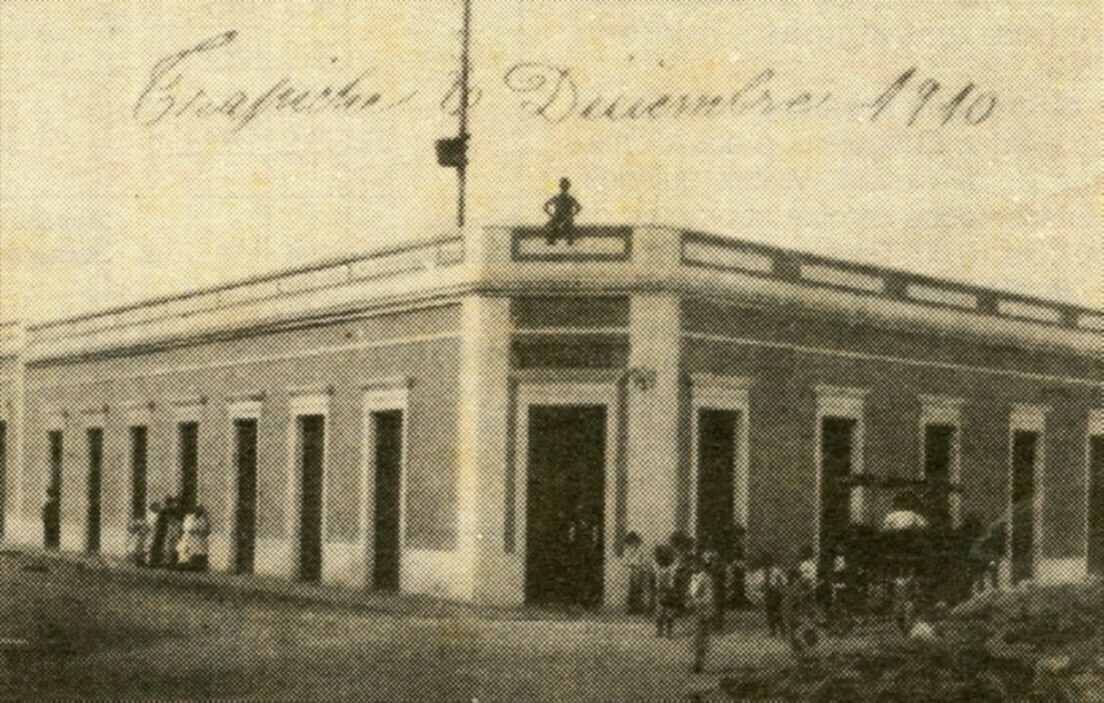 |
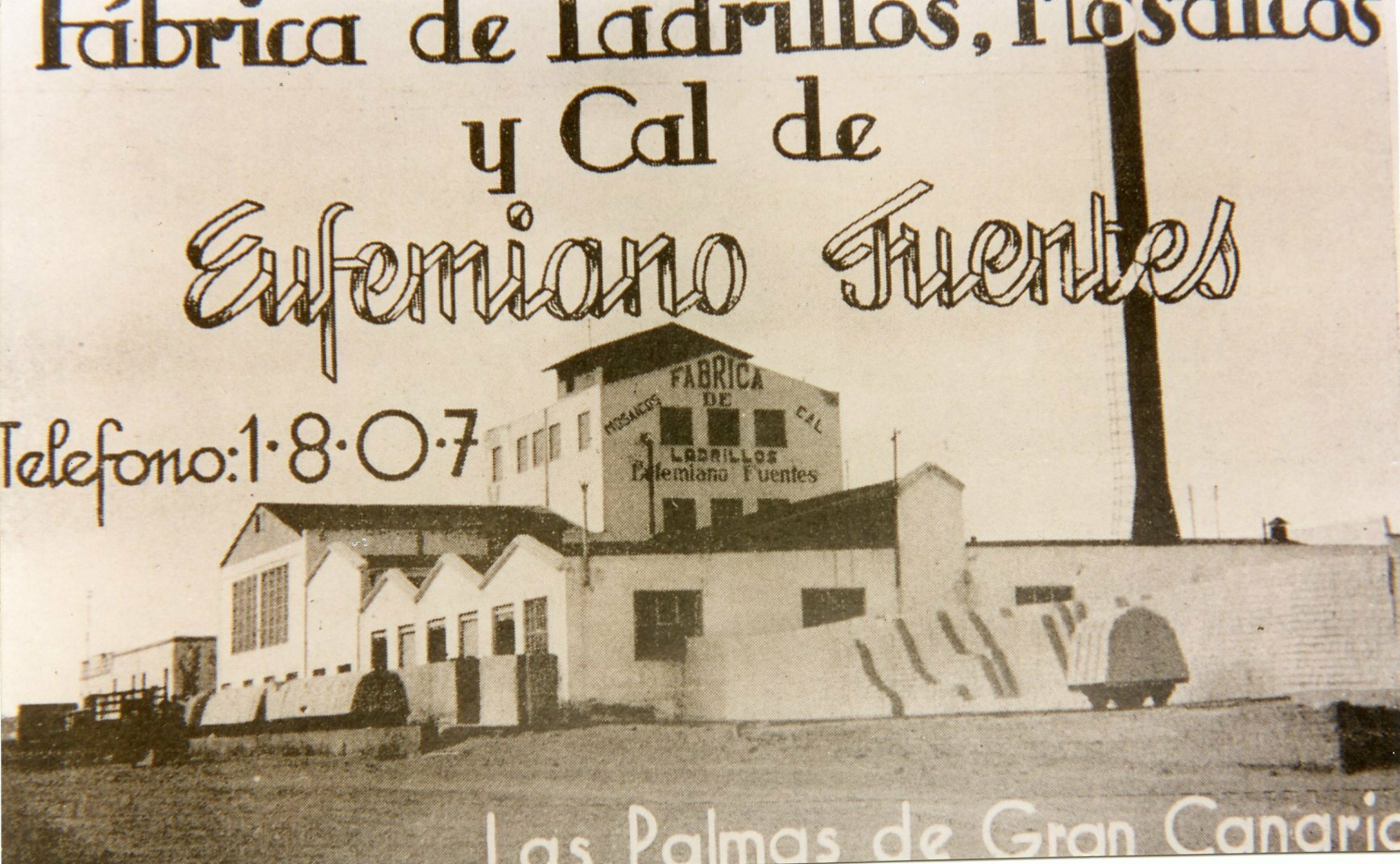 |
|
| Former tobacco factory of Mr. Eufemiano Fuentes on Pamochamoso street where important agreements regarding the life of the entity would be discussed. | Brick factory of businessman D. Eufemiano Fuentes. |
It comes to mind that on one occasion, due to a circular from the Royal Spanish Football Federation regarding players signed outside the required limit, we had to replace the records of Merino and Padrón, which presented certain irregularities with respect to the dates.
To give these tokens the required age, Eufemiano Fuentes, Trujillo Fébles and I poured a yellow liquid over the paper, subsequently raising them to the roof so that the sun could shine on them. The result was surprising!
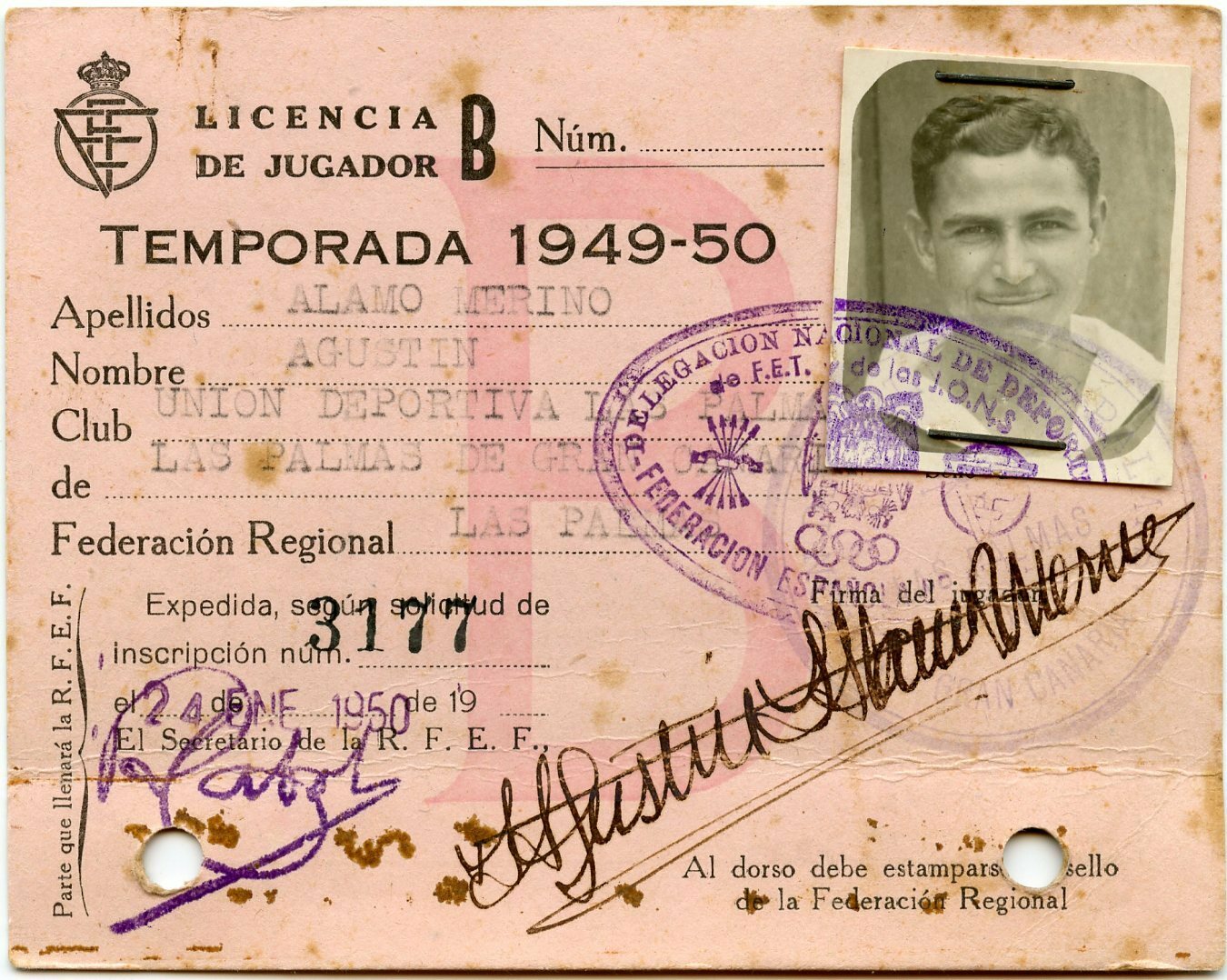 |
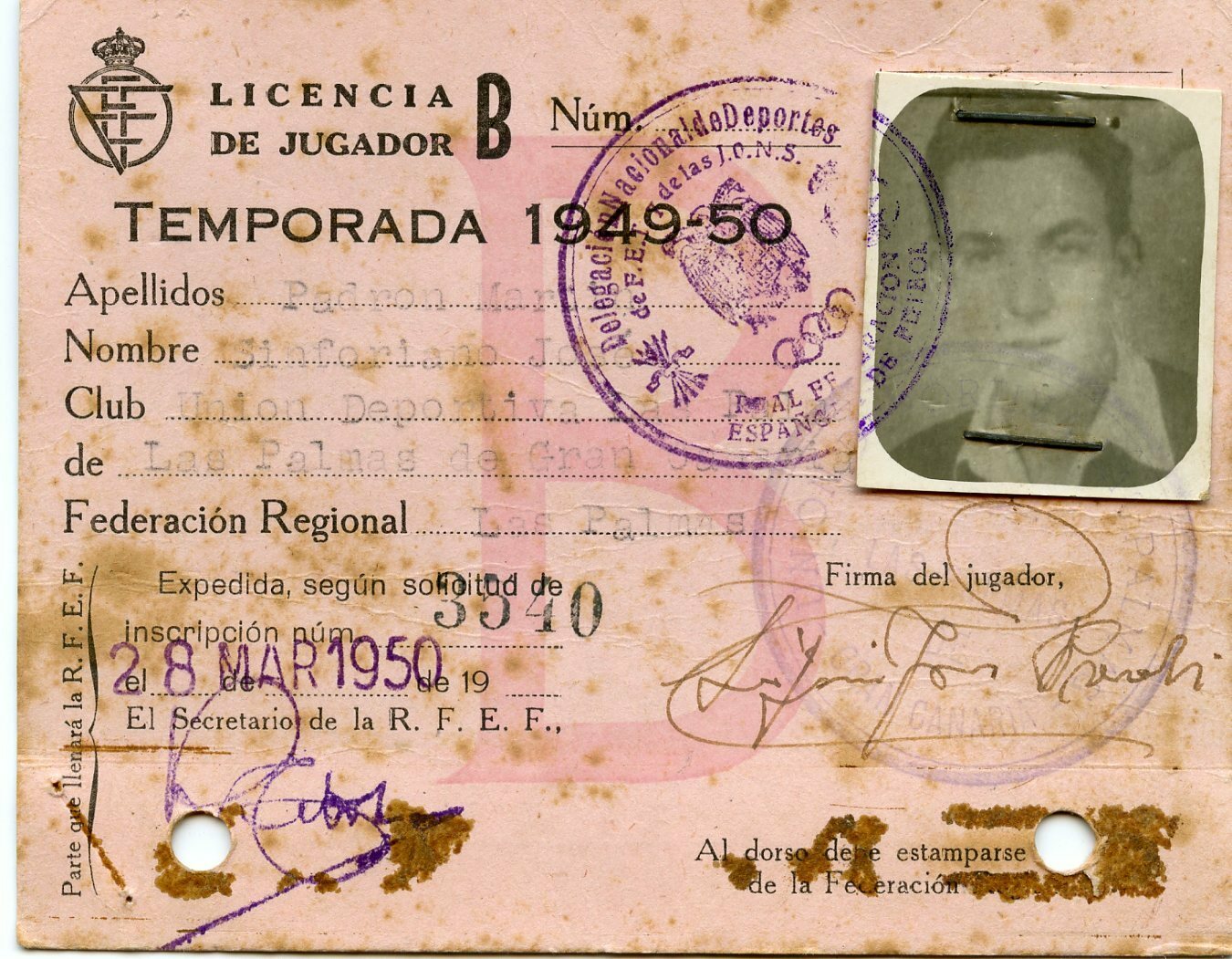 |
| Player license Agustín Álamo Merino. | Player license Sinforiano José Padrón Martín. |
Mr. Luis Rivero Noble, founding partner and member of the Fusion Committee that created UD Las Palmas.
In a wild and remote place in the Santa Brígida Watchtower, retired from all professional activity and with the only company of his faithful guard dog, Mr. Luis Rivero Noble lives his autumn days.
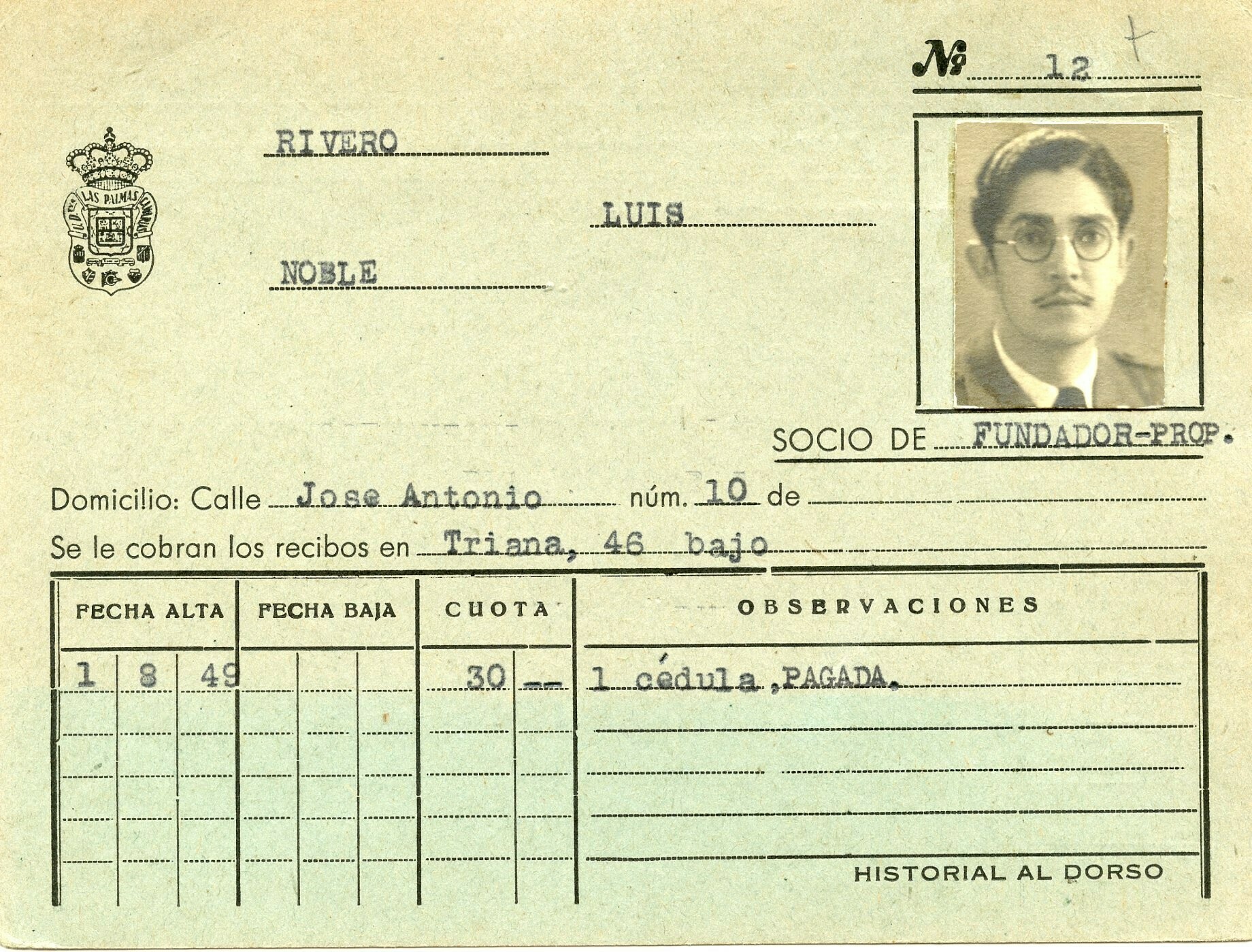
It is a dull, rainy winter afternoon and the place seems deserted. As soon as he sees our figure behind the large windows, he rushes down the garden urging us to enter his old house. There, among documents and books of the time, generously treated, he tries to create the right climate to weave his thoughts. After a long pause
He begins his story:
“Look, many years have passed and I am not used to interviews. At my advanced age and living with a pacemaker, I feel very tired.
During all these years no one had remembered me at all and all this takes me by surprise. I believe that due to my excessive discretion my merits have not been recognized although it is true that in all this long time I have been disconnected from football.
I left “La Unión” because I suffered a lot watching the games, and with my heart problems I always had to leave the field with a doctor by my side.”
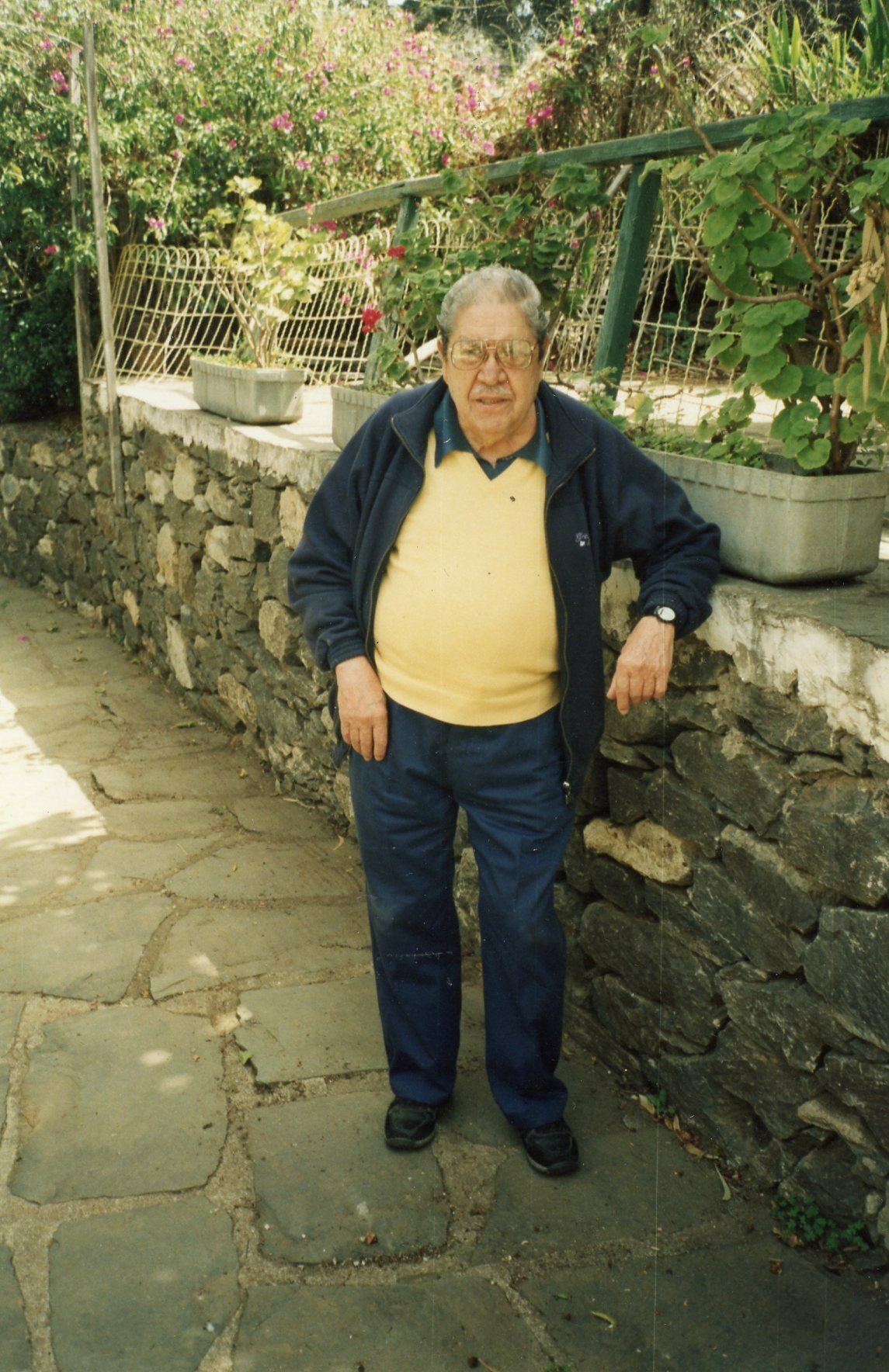 |
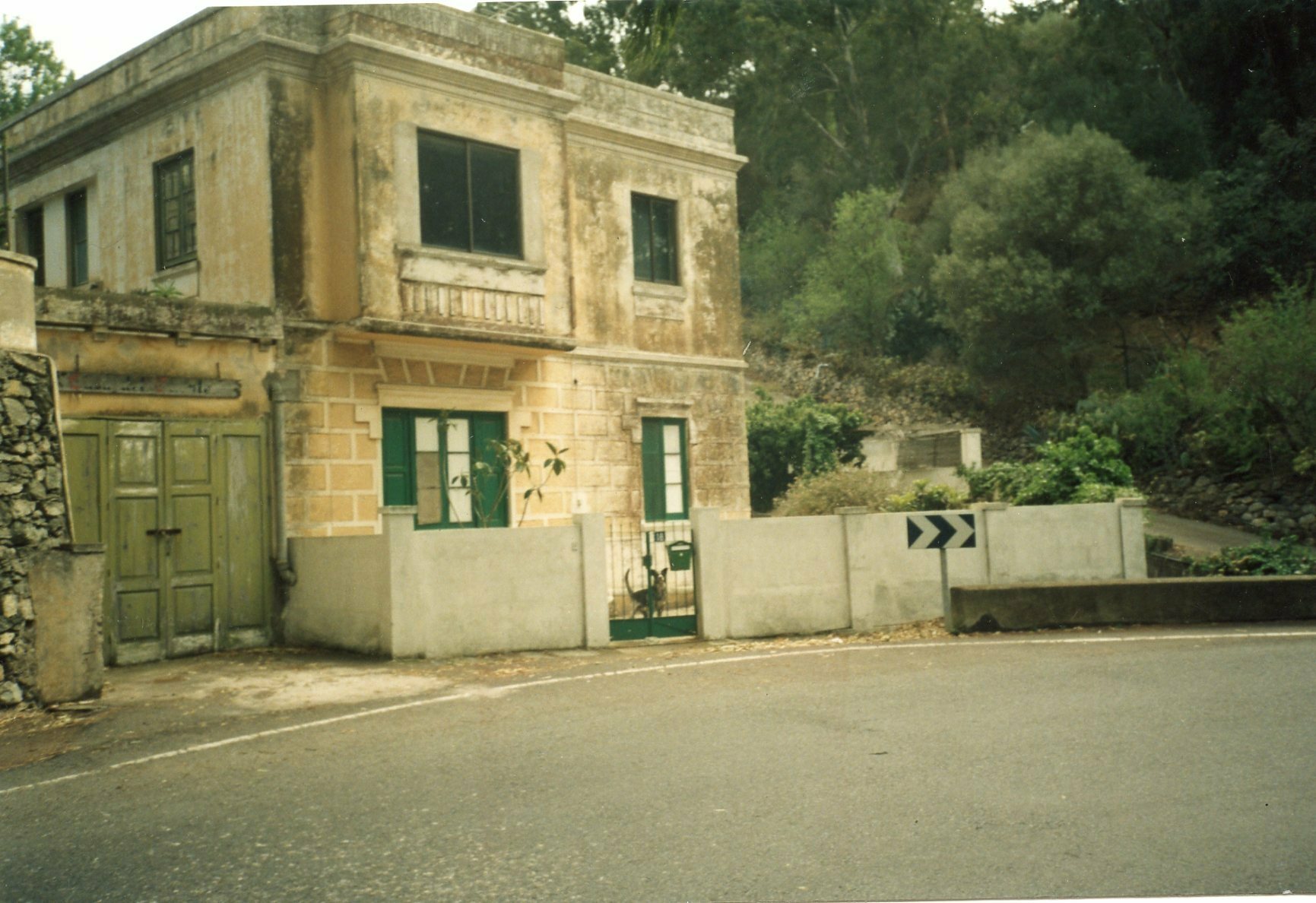 |
| Mr. Luis Rivero Noble in the garden of his house. | Home of Mr. Luis Rivero Noble in La Atalaya de Sta. Brígida. |
Canary Islands football and its decline.
After a break and savoring a cup of chamomile from their own garden, it continues…
“Look... It all started after the civil war ended. Upon returning, I became part of the C.D. board. Gran Canaria, although at the same time I simultaneously held my position with the technical direction of Gimnástica.
It so happened that the C.D. coach Gran Canaria Juan Zacarías left the management of the team on the eve of an important match that we had to play against Real Madrid, being forced to assume responsibility for the position. On this trip, Real Madrid took the opportunity to take Hilario Rodríguez and Miguel Cabrera who would partner with Luis Molowny on the merengue team. That constant bleeding of players could not be sustained under any circumstances!
The powerful clubs of the peninsula did not support the idea of our integration into National Football since they supplied themselves with great Canarian players at a very low price, pressuring the Nacional to oppose our just demands.”
Integration into national football.
"Laureate Lieutenant Colonel Mariano Gómez de Zamalloa, who served as a member of the National Federation, came to the island and negotiations began to be established."
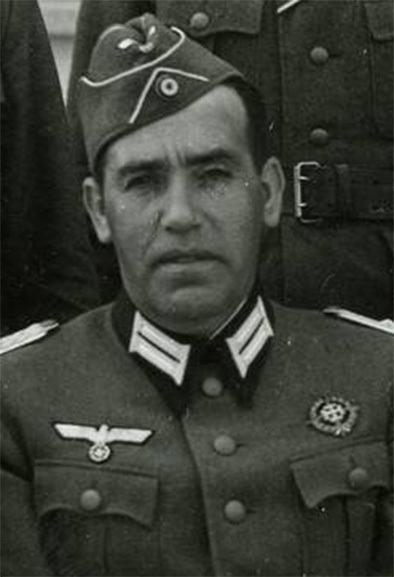 |
| In the image, the Laureate Lieutenant Colonel and Member of the Spanish Football Federation, Mr. Mariano Gómez Zamalloa, during his visit to the island to begin the process of our integration into National Football. |
"I was united by great ties of friendship with His Excellency Mr. Francisco García Escámez e Iniesta, of whom I will always keep fond memories. He was the one who introduced me to Mr. Gómez Zamalloa and to a certain extent he had a notable influence on the conversations with the members of the Presentation came to prosper. I remember that the Lieutenant Colonel was staying at the Gran Hotel Parque and we met at the National Bar which was located in front of the San Telmo Park."
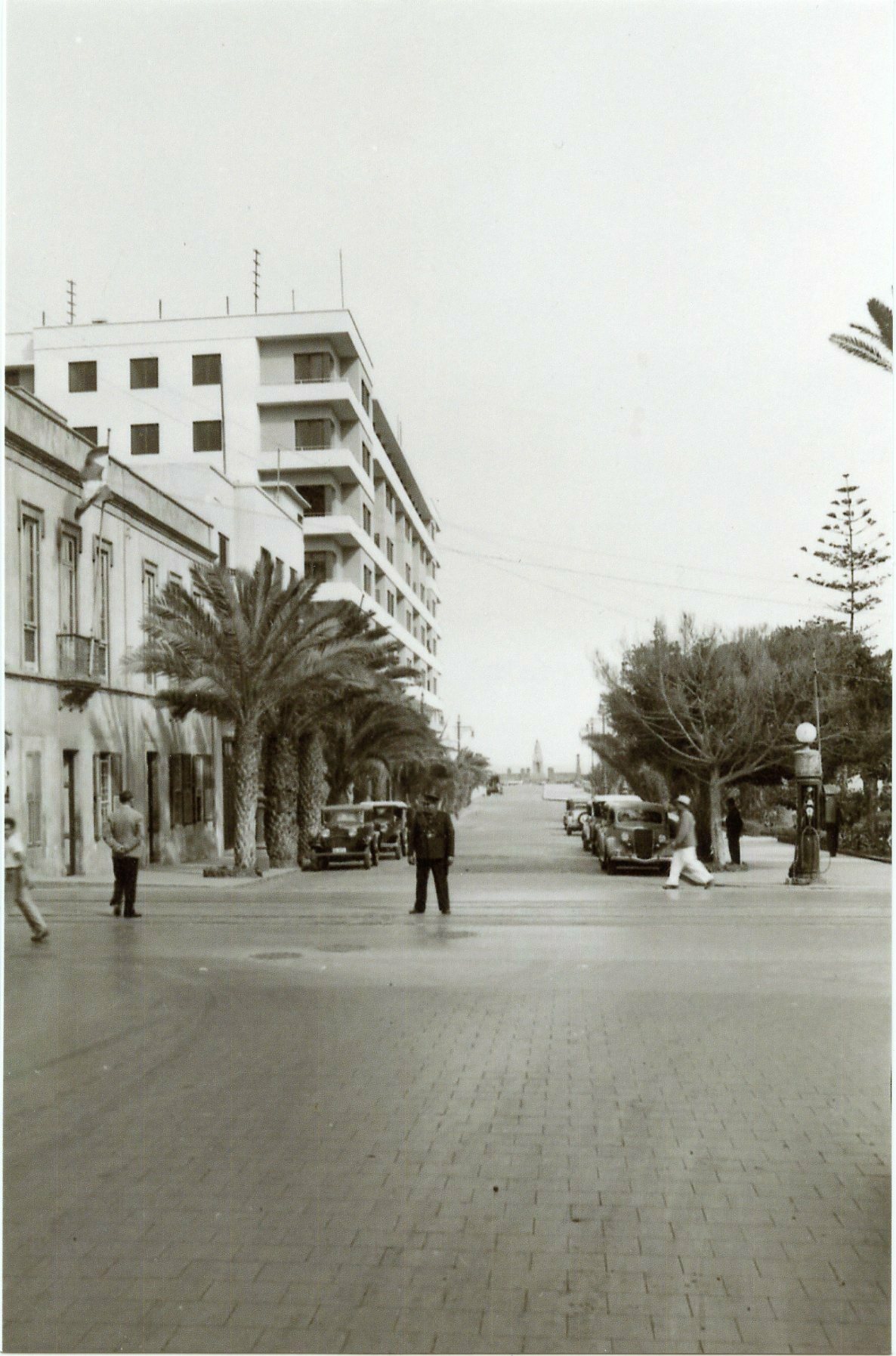
"Although at first it must be recognized that both Zamalloa and the Secretary of the National Dr. Cabot had been opposed and hostile to integration, they later promised to study the case and support our request."
The merger of the clubs.
“Over the years, memories are lost and I see the passages of my life in a kind of nebula. However, the process of establishing UD Las Palmas is something that will live latently in my memory.
The Arenas Club joined the C.D. Gran Canaria to be renamed UD Las Palmas. Atlético Club also merged without major difficulties although it would sell all its assets.
Regarding the R.C. Victoria y Marino C.F. It would be entering a different story.
There was a lot of friction and acrimony, leading at times to think that the problem would not have a solution, since well into the First Division of the National League, these two clubs had not yet fully merged. They were also not determined to sell the shares they had in the Las Palmas Stadium. I believe that the great triumphs of our team at the national level would awaken the general consciousness, producing a collective hysteria at a popular level that influenced and contributed in a notable and decisive way to the definitive merger of said clubs.
In any case, to their credit it is fair to say that these two clubs contributed the majority of players to the founding squad with the exception of some who were sold to peninsular clubs and although it is true that at the beginning there were also many difficulties regarding the lease of the stadium, in the end their attitude was very generous.”
We said goodbye to Mr. Luis Rivero Noble at the door of his house under a heavy downpour and the suspicious gaze of his guard dog who during our extensive talk had not left his master for a moment.
When we were leaving I suggested that I visit him again to take some photos for the book, he told me in a firm and hurried voice:
“Please don't delay. My heart is a little weak and tired and... you might come a little late. "I am very interested in contributing to this book on the history of UD Las Palmas since, forgiving immodesty, I am part of its history."
When I was leaving the secluded place I stopped for a moment to look with great pride at his house; pride in an ancient heritage that we had to safeguard and defend. No, his words had not gone unnoticed; They had helped me to verify the enormous greatness of our club.
I thought about all those people already missing who left us such a beautiful legacy; in our parents who transmitted to us their fervent love for these colors. I also thought about the great honor it represents to be part of this glorious club, emblem of all the Canaries.
Magna Assembly of the R.C. Nautical. End of the Presentation and New Manager.
Our entity and the R.C. Náutico de Gran Canaria have been the subject of abundant historiography over the years. However, there is very little published about the integration of Canarian football into national competitions and the constitution of our club in the historic Magna Assembly since all its study and documentation is limited to the publication of the volumes on the history of UD Las Palms that said without the slightest petulance, I have the honor of having written some time ago.
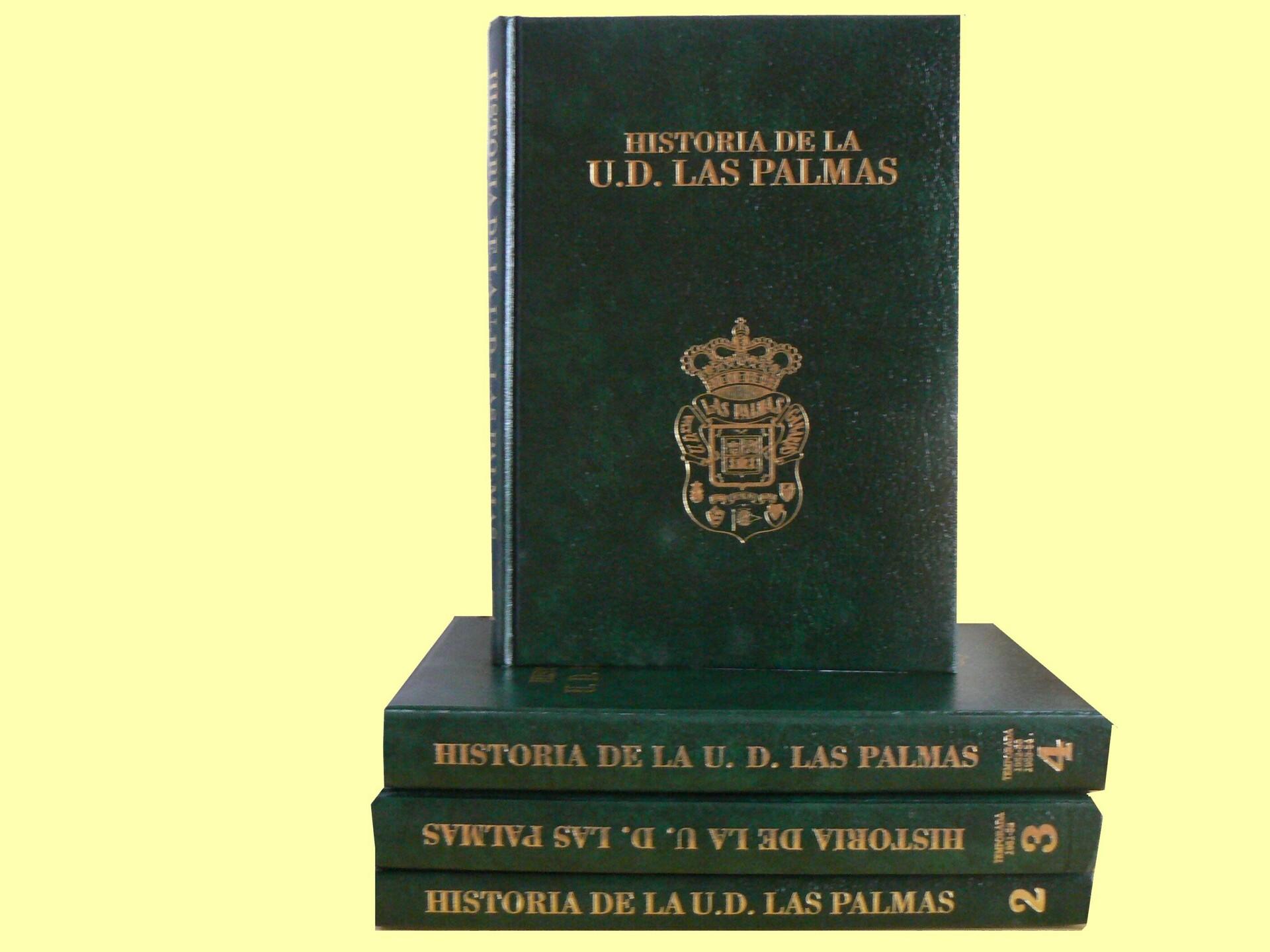 |
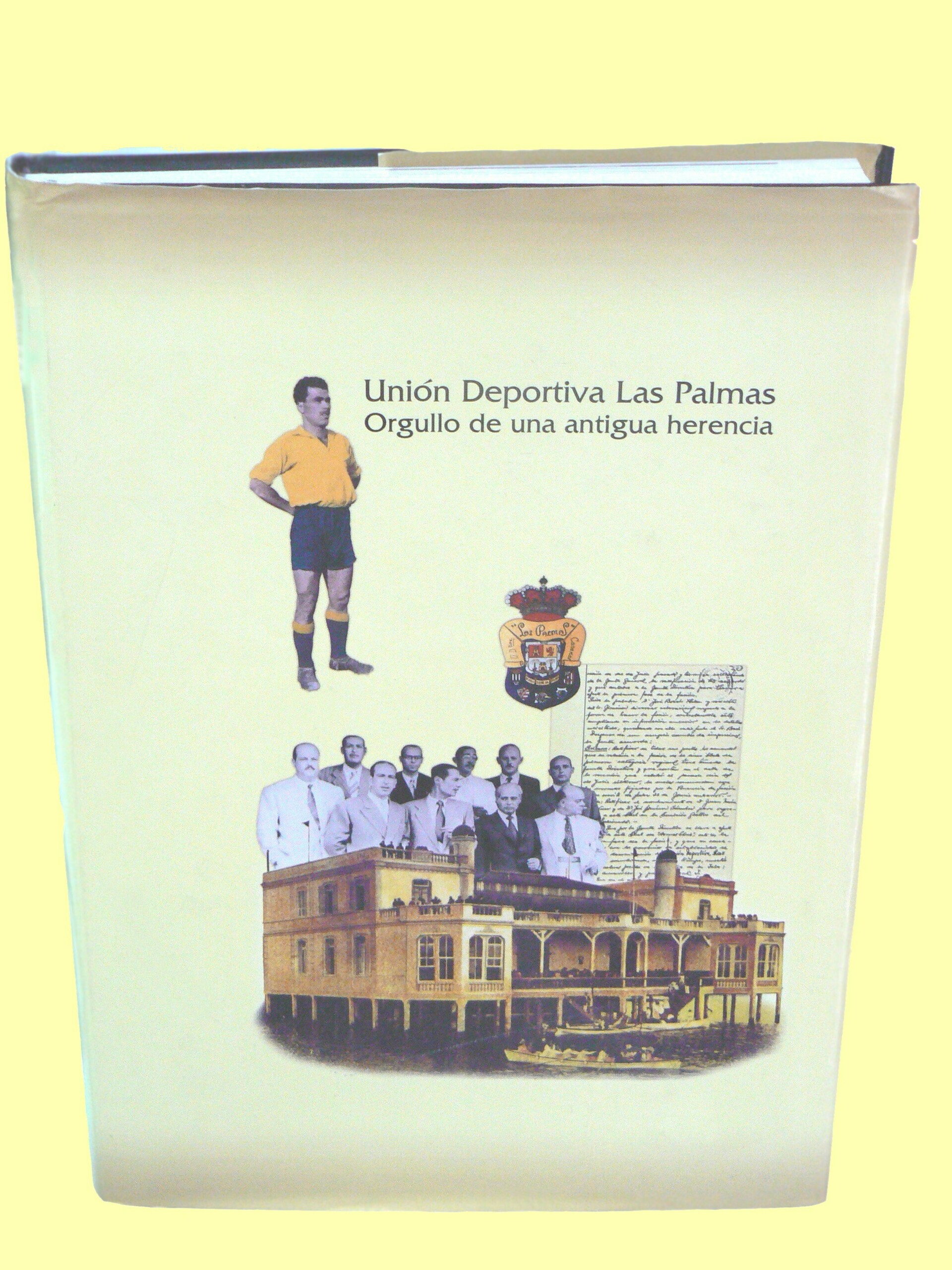 |
|
| Edited volumes on the history of UD Las Palmas where the entire process of constitution of UD Las Palmas and our integration into National Football would be reflected for the first time in the life of the club with a documentary base from the entity's archive. | Cover of the book “UD Las Palmas: Pride of an Ancient Heritage” published after the entity's 50th anniversary. |
Both institutions occupy an eminent place in Gran Canaria society and already form indissoluble ties that will last forever.
The old image of that potsromantic style building reminiscent of the 18th century founded by the illustrious Patricio Gustavo Navarro Nieto that rose on pilasters with its Venetian towers in perfect synchronicity.
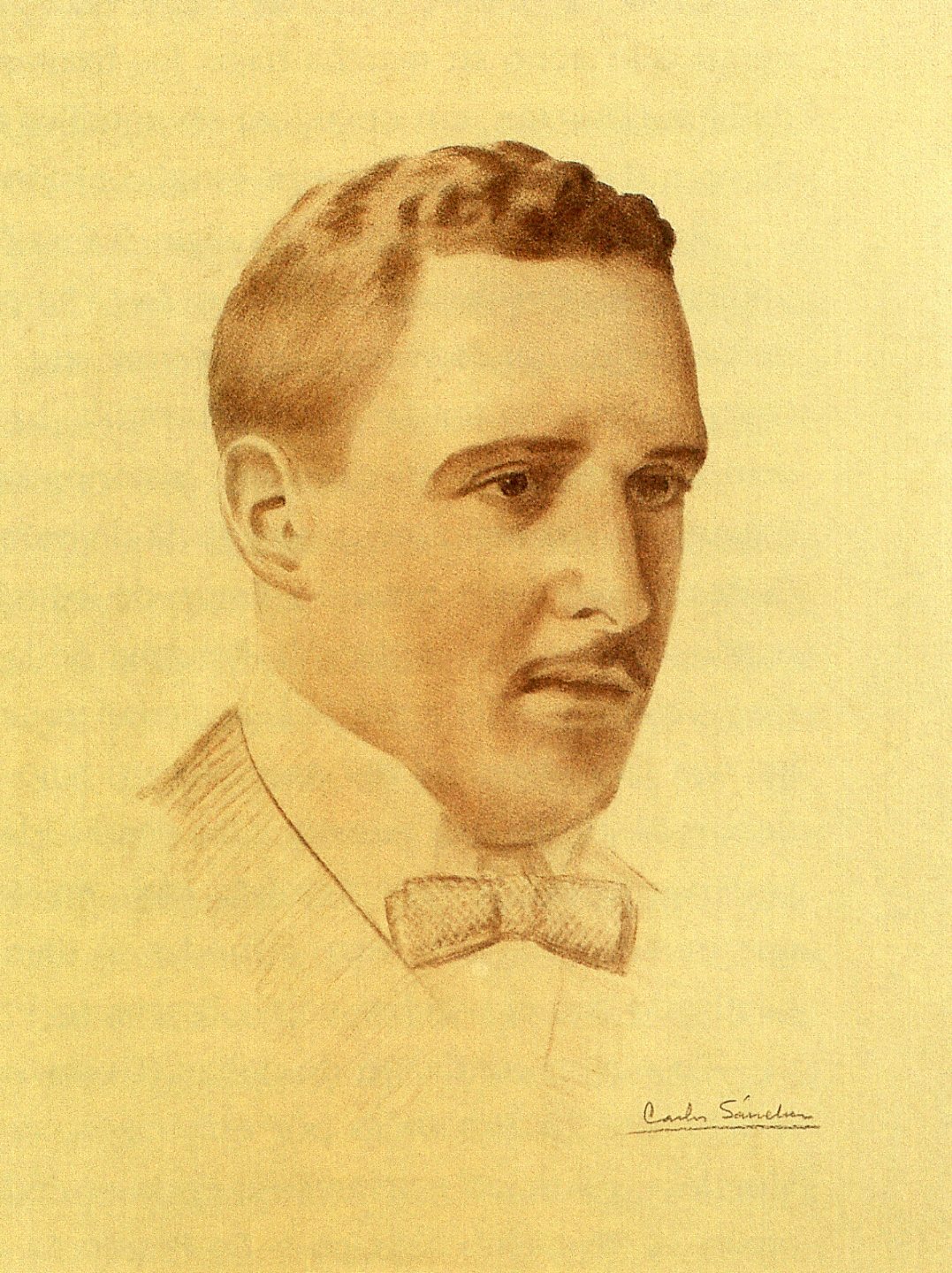
And that communicated with a small bridge over the silent waters of the bay, it still remains in living memory, in the collective memory of many generations of Gran Canarians, and of some like me in my childhood. We spent the summer very close to Las Canteras Beach and we frequently entered that idyllic place attracted by its majestic presence.
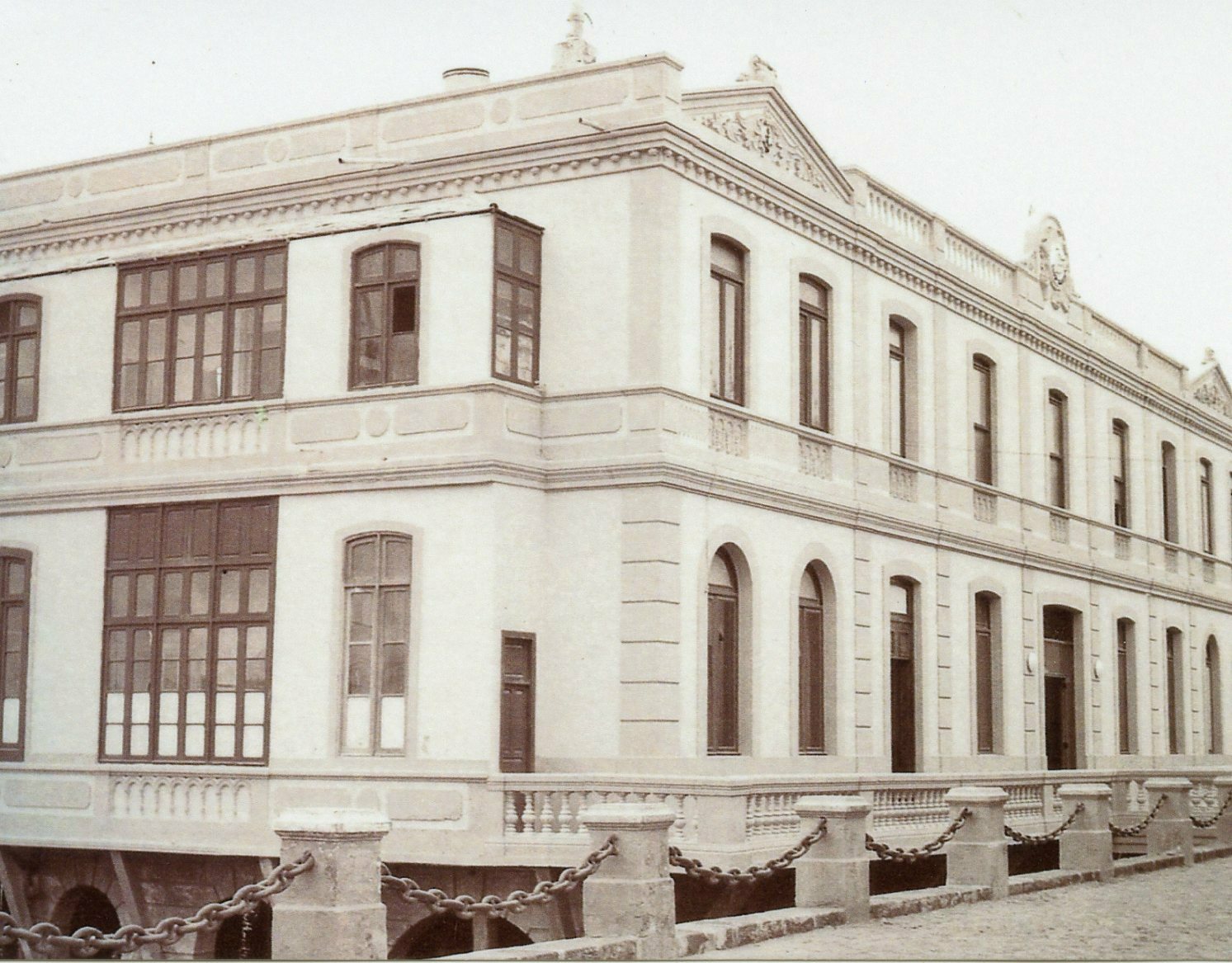 |
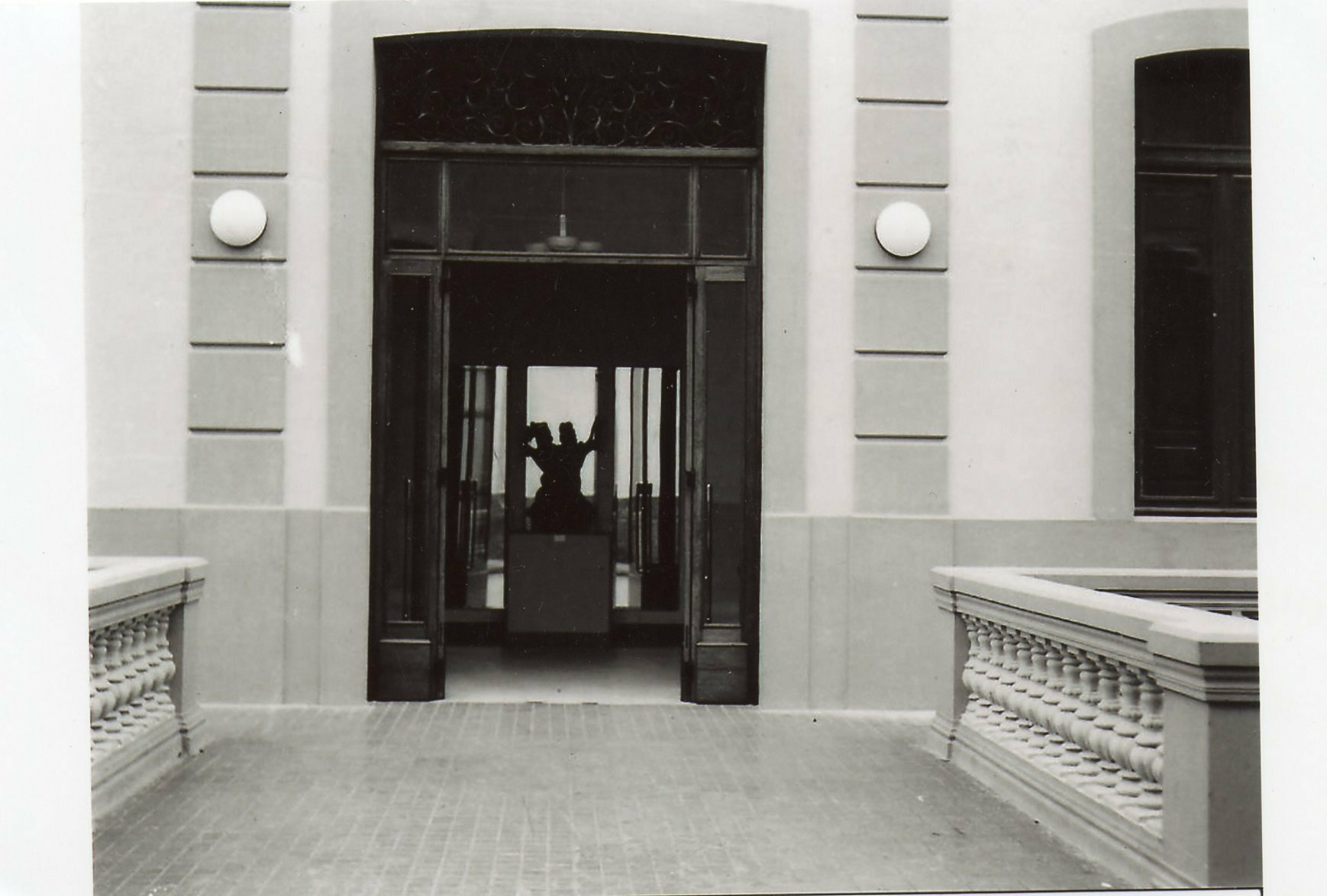 |
| Main and North Facade. | Entrance of the old R.C. Nautical of Gran Canaria that communicated with a small bridge over the silent waters of the Bay. |
And among the plurality and diversity of facets that the R.C. Náutico has played throughout its history, it is worth distinguishing one of special relevance that would become the social and sporting epicenter of the then peaceful city of Las Palmas de Gran Canaria. But although the incorporation of Canarian football into national competitions was now a happy reality, there were still many obstacles to be resolved at the level of local clubs that jeopardized the consolidation of this institution.
From the perspective of sixty years in memory, the time has come for new generations to learn about the trajectory, circumstances and transcendental importance that the historic Magna Assembly of the former Real Club Náutico de Gran Canaria had in the birth of our club. But why a Magna Assembly? Many readers will wonder: What real difficulties motivated her?
On August 16, 1949, the Merger Presentation would meet at the registered office of the Regional Federation for the last time.
Mr. Adolfo Miranda Ortega was the first to speak, making the following comments:
a) Once in contact with the Marino and Victoria clubs, in order to obtain an initial loan to be able to cover the first expenses of the new team, “Unión Deportiva Las Palmas”, such management had not been successful, due to having expressed said clubs being in a difficult economic situation.
b) Likewise, no response had been received from local corporations and authorities for the organization and financing of the team.
c) On the one hand, the documentation presented by the clubs R.C.Victoria, Marino C.F. and Atlético Club for the registration of players, did not in any way conform to the regulatory standards required by the National, with the Federation warning that it would be necessary to take drastic measures if said infractions were not corrected. On the other hand, the clubs had stated that if the company did not prosper, the five contracting entities would disengage from their commitment, returning to their club of origin.
d) The sending of the certification regarding unconditional membership to the new club had not also been received, indicating the president of R.C.Victora Mr. Montenegro Rioboó that he would call a general meeting to submit said approval to the consideration of the members, refusing to commit in a favorable sense.
e) Subsequently, the R.C. Victoria and Marino C.F., reflecting the feelings of their social mass, state in writing that they have accepted the creation of a new single team, but without this implying the disappearance of their clubs, which should remain active for the purposes of being a nursery or quarry. of the newly founded team.
f) Nor were they willing to renounce their recreational societies or give up their trophies or belongings.
g) Although it is true that these clubs would give up their top figures, it was still less true that players had been sold once the merger had been verbally agreed, as in the specific cases of Nóbregas and Miguel “El Palmero” who would be sold to the Málaga and Atlético de Madrid respectively.
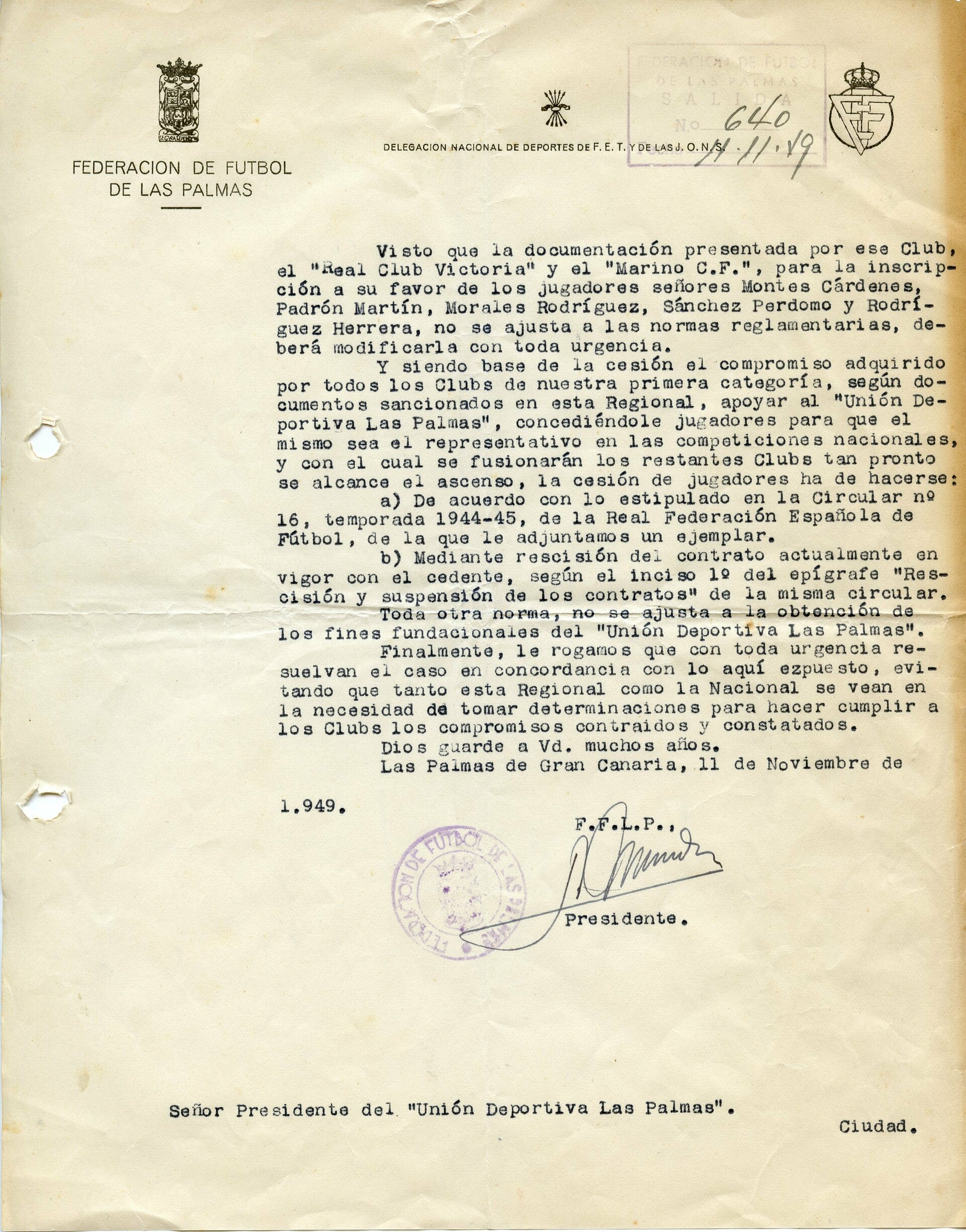 |
| Letter from the Las Palmas Football Federation notifying the irregularities presented in the documentation of R.C. players. Victoria y Marino C.F. |
h) Nor were these clubs willing to renounce their recreational societies, which would continue to function with total autonomy, nor to give up their assets, trophies or belongings.
i) To further aggravate the situation, the Board of Directors of the Las Palmas Stadium called Empresa Marino C.F. where Mr. Juan Rodríguez Doreste acted as secretary, he had opposed the sale of the sports venue, not promising in principle any agreement on its lease or selling the shares they had in the Insular Stadium.
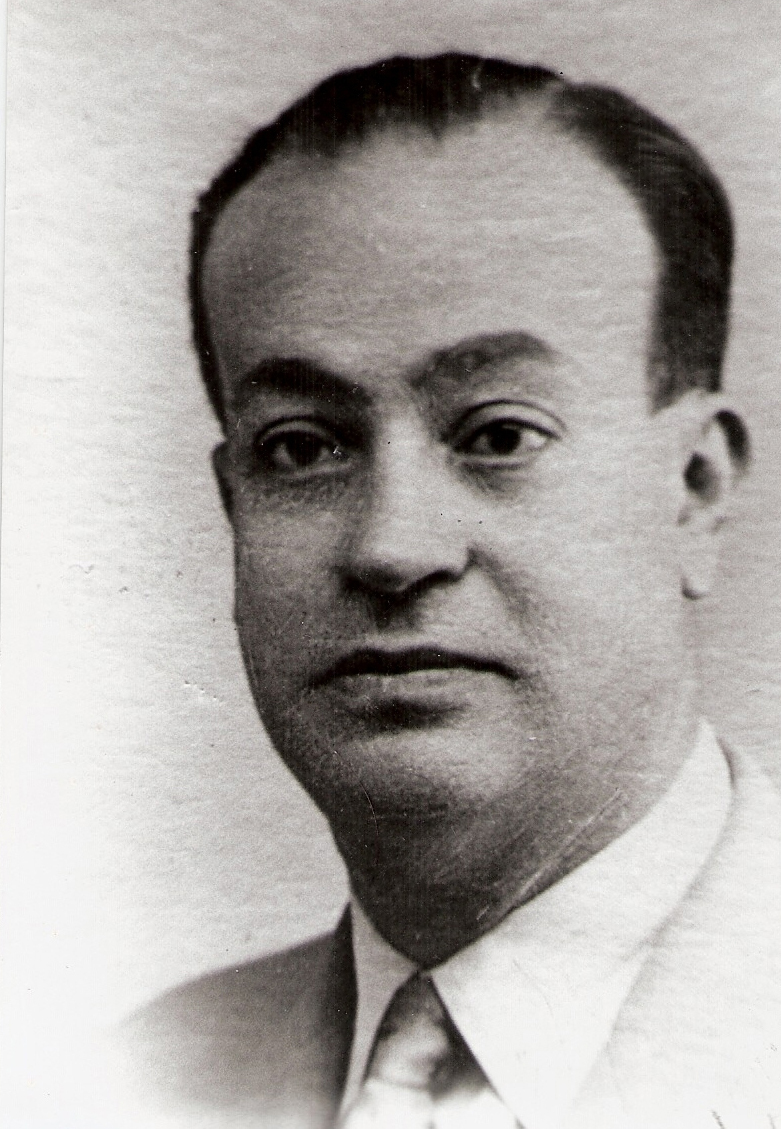 |
| Mr. Juan Rodríguez Doreste, secretary of the Board of Directors of the company Marino C.F. and later member of the board chaired by Mr. Eufemiano Fuentes |
With the competition so close, it was of great urgency to solve the economic problem, seeking an immediate solution.
Next, Mr. Rodríguez Monroy spoke, stating that he deeply regretted the obstructionist campaign that almost systematically opposed the creation of the “single team” by proposing a “Magna Assembly” that should have as its framework the old R.C. Náutico de Gran Canaria chaired at that time by Mr. Enrique Martínez Suárez. where invitations would be sent to club directors, local authorities and relevant people in our society who could offer their help for such a laudable goal.
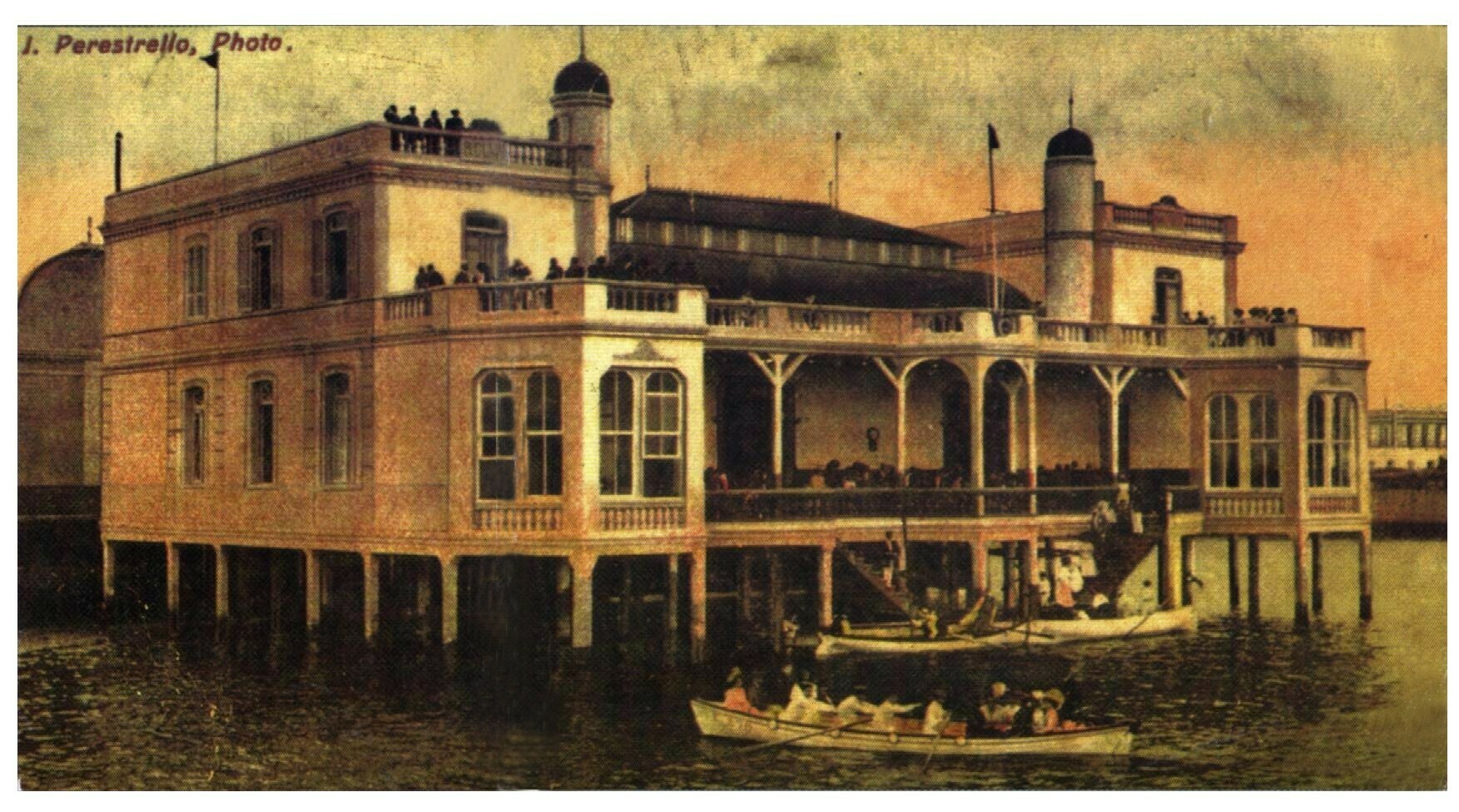 |
| R.C. Náutico. |
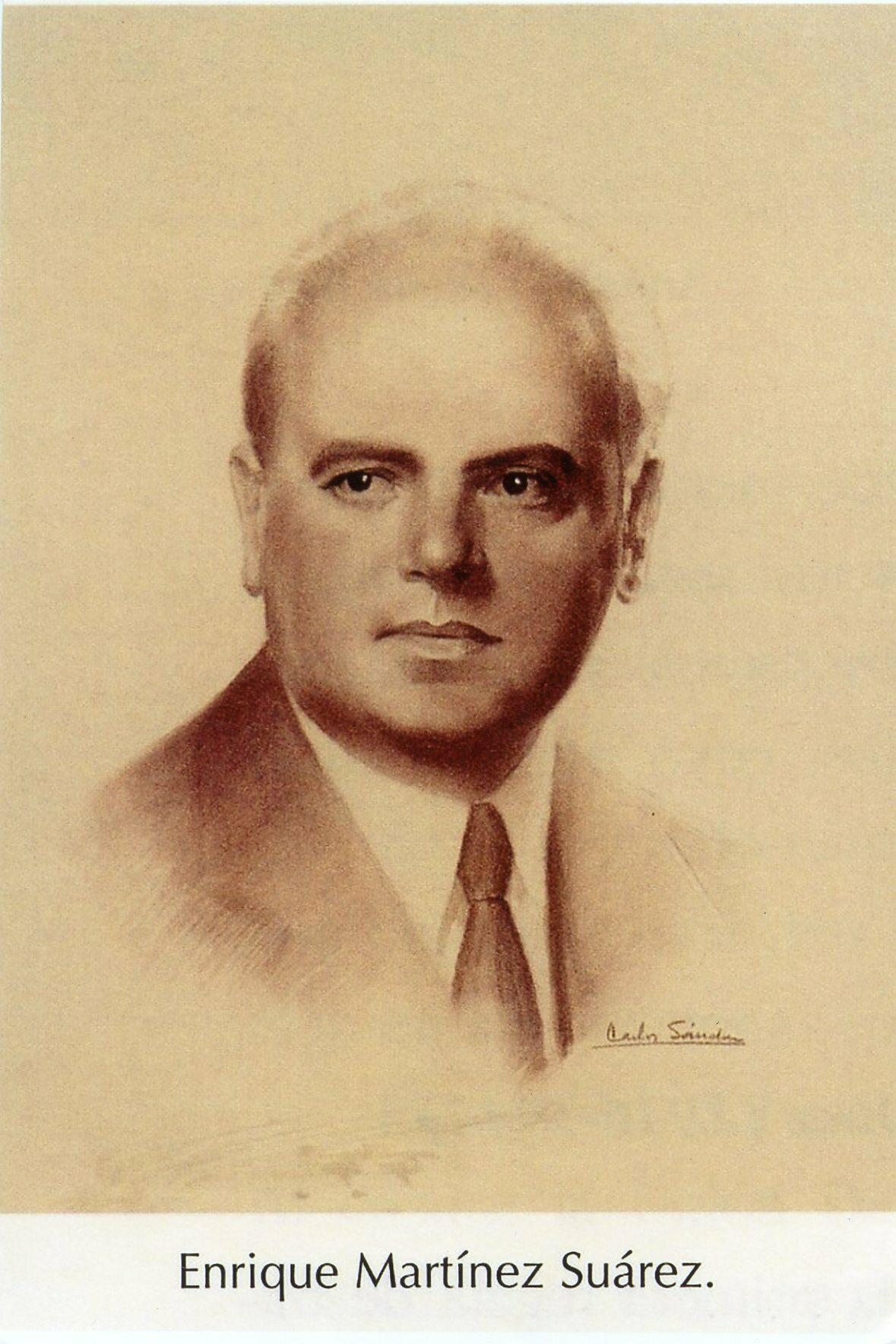 |
| Mr. Enrique Martínez Suárez, President of R.C. Náutico o Gran Canaria. |
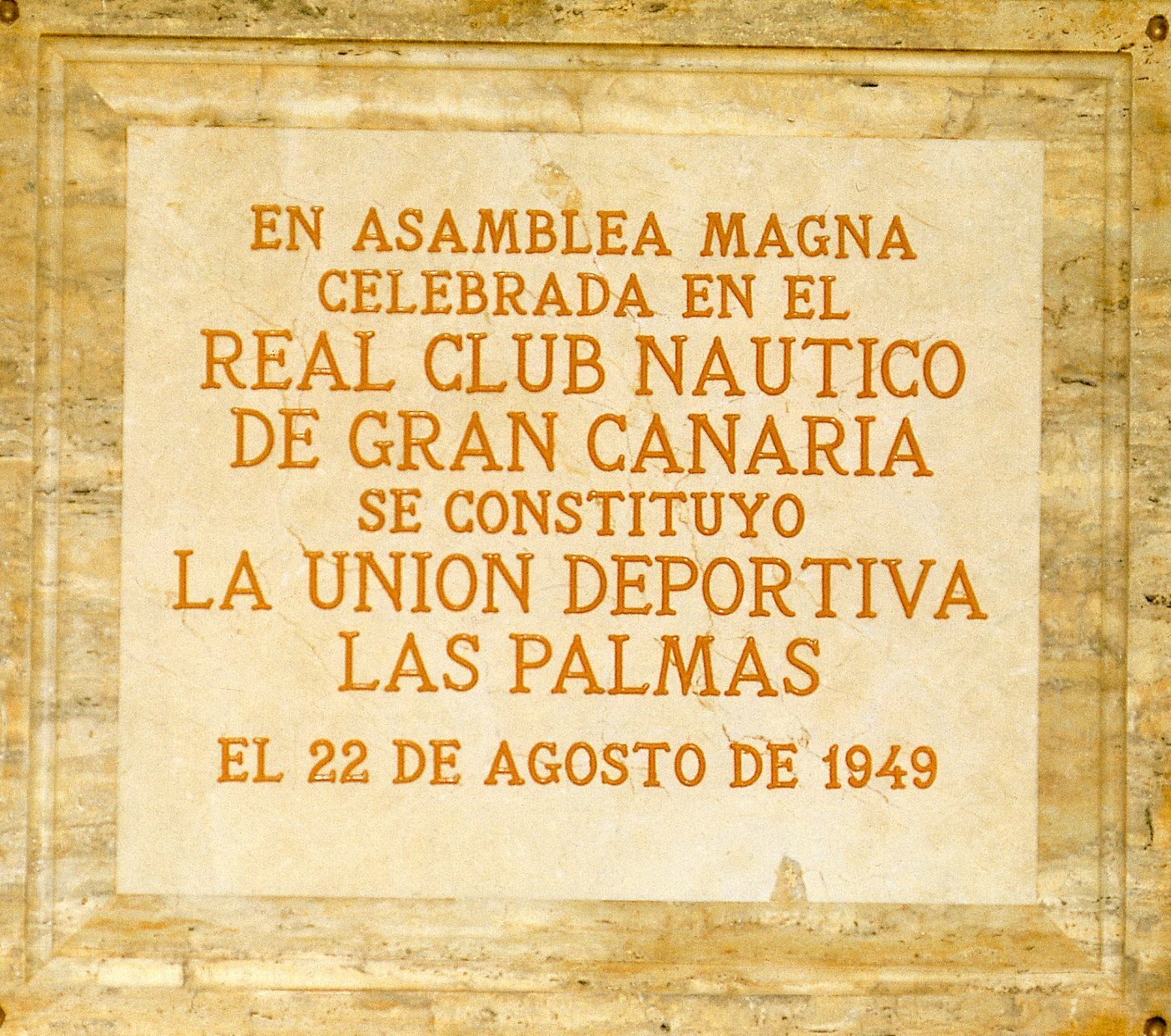 |
| Commemorative plaque of the constitution of UD Las Palmas that decorates the walls of the entrance to the R.C. Nautical of Gran Canaria. |
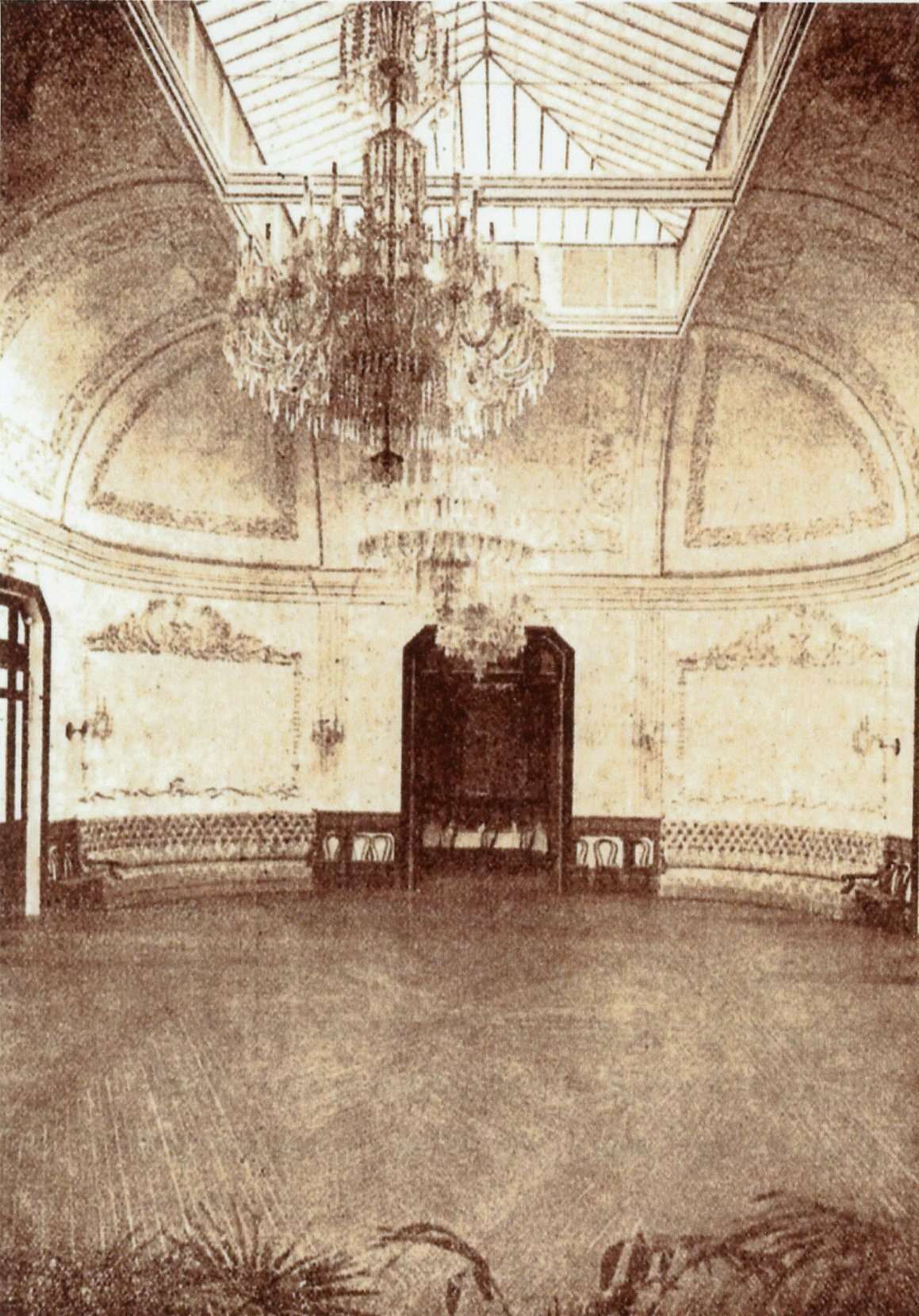 |
| Room where the historic Magna Assembly of the R.C. would be held. Nautical of Gran Canaria. |
The Merger Presentation unanimously agreed to accept the wise proposal of Mr. Rodríguez Monroy and, by virtue of this, considered calling the clubs on Monday, August 22, 1949 at 8:00 p.m. at the registered office of the former R.C. Nautical, where the following order of matters would be discussed:
a) Exposition of the work carried out by the Presentation and the status of the efforts carried out to establish our team in the national category.
b) Suggestions from the assembly members.
c) Constitution of UD Las Palmas.
d) Inauguration of the president and appointment of the new Management Committee.
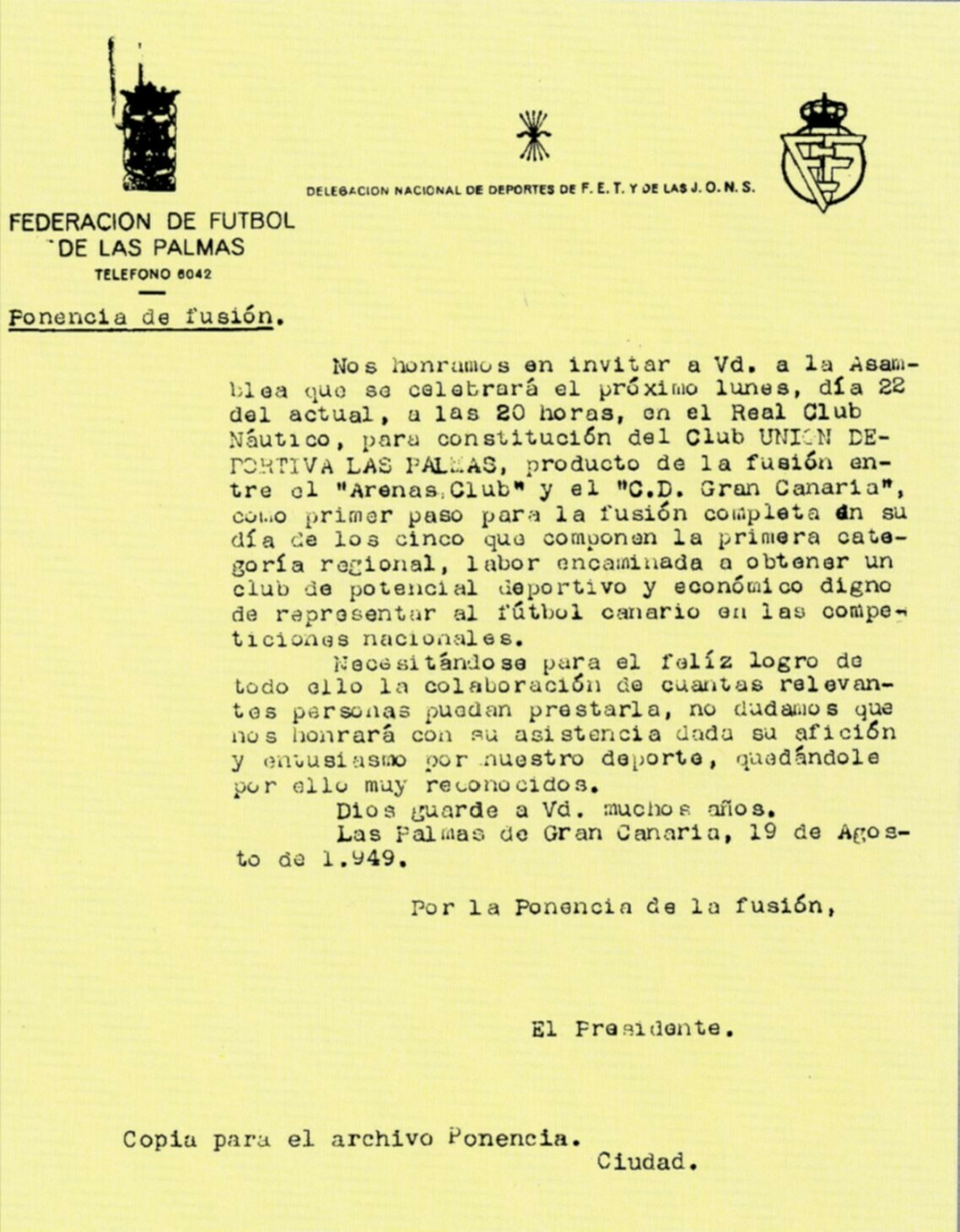 |
| Invitation to the Magna Assembly of the R.C. Nautical. |
It would be an enormous task to name here all the people who were present at said assembly. So that they are aware of that event, simply let them know that the capacity would be absolutely collapsed due to the enormous expectation that the event would arouse.
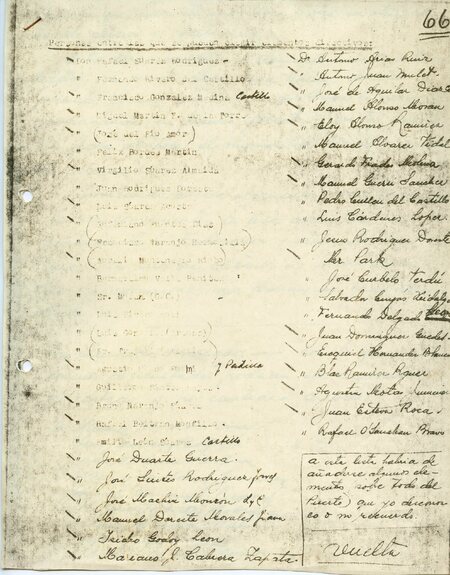 |
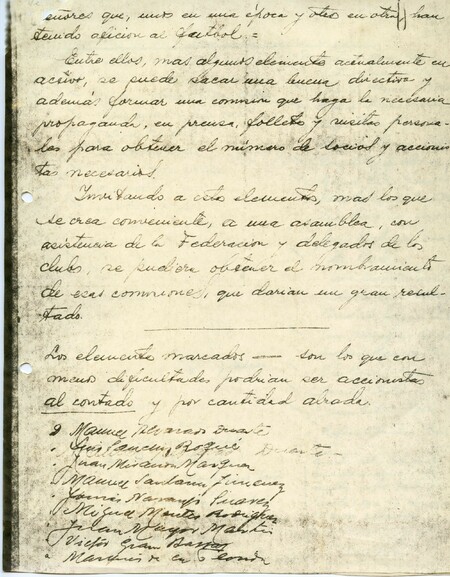 |
| In this list that you see blurred and deteriorated by the passage of time, which is ten pages long, more than two hundred people from all social classes have been counted, which considering the demographic index of those years is a highly considerable number. | |
Constitution of the U D Las Palmas
This historic Assembly, held with unusual expectation in the former headquarters of the R.C. Nautical, served to iron out differences and reach a total agreement, although it is fair to say that important achievements had already been achieved previously.
The efficient and laborious work of that Fusion Presentation had come to an end. Many hours of dedication and effort remained behind in this great undertaking, not without difficulties.
The Magna Assembly of the R.C. Nautical of that time in authentic social reference of both entities.
The R.C. Náutico de Gran Canaria and UD Las Palmas, from that founding date of August 22, 1949, crossed the threshold of reality to enter history and legend.
The five clubs would unanimously accept the following agreements at said assembly:
1) The C.D. Gran Canaria would join the Arenas Club under the new name of UD Las Palmas in the first phase of the Merger.
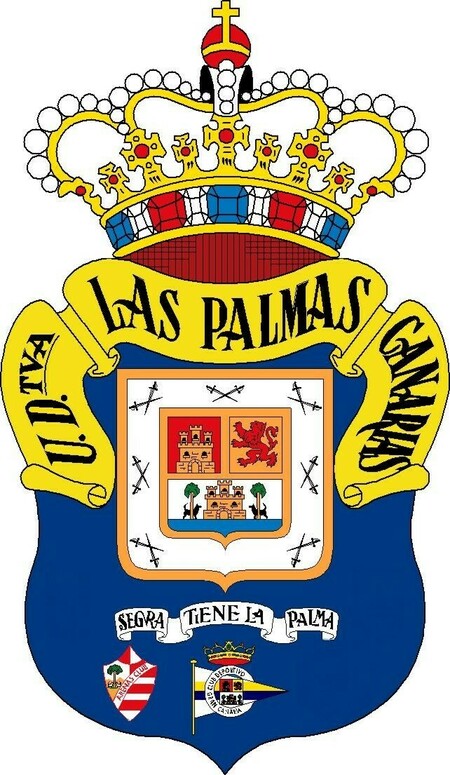
2) Once promotion has been achieved in the Regional League championship, carry out the second phase of the merger, completing it with the R.C. clubs. Victoria, Marino C.F. and Atlético Club.
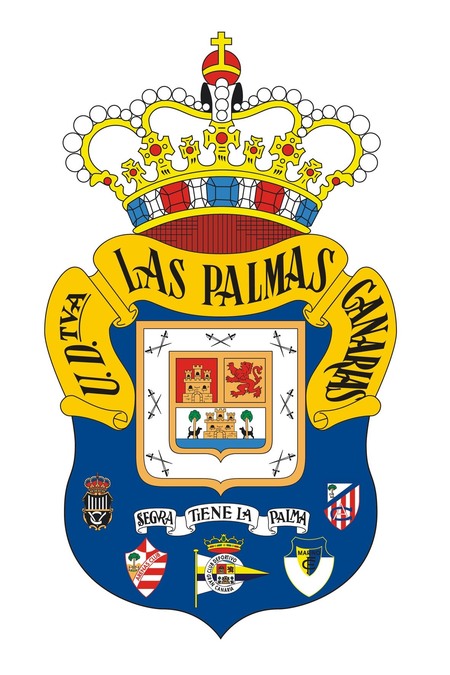
The CD Gran Canaria would be the base club of the merger not only due to its age but also because it was the only team that would be fully integrated by joining the Arenas Club in the first phase of the merger, donating its headquarters with all its trophies and belongings. That is to say, he handed over everything he owned, from the most modest boot to his most valuable objects, completely disappearing as a club.
There is no doubt that the creation of our representative team constituted from the first moment an authentic social phenomenon with extraordinary popular support.
UD Las Palmas, called by this glorious name because it was born from the union of all the Canarians, had become everyone's club in its own right.
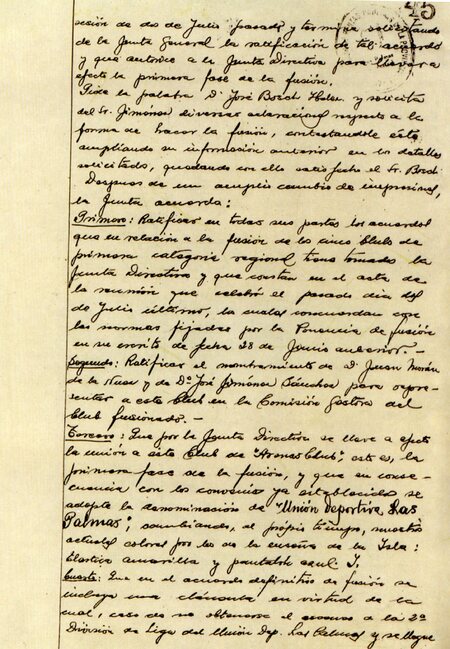
| Minutes of the C.D. Gran Canaria where in one of its stipulations the change of name of the club is perfectly reflected, reading the following: “That by the Board of Directors the joining of this club to the Arenas Club is carried out, that is, the first phase of the Merger and that as a result of the established agreements, the name of Unión Deportiva Las Palmas is adopted, changing at the same time our current colors (white) for those of the island's flag: yellow elastic and blue pants. |
Management Commission.
The Management Commission of the U. D. Las Palmas was made up of the following members:
| President | ||
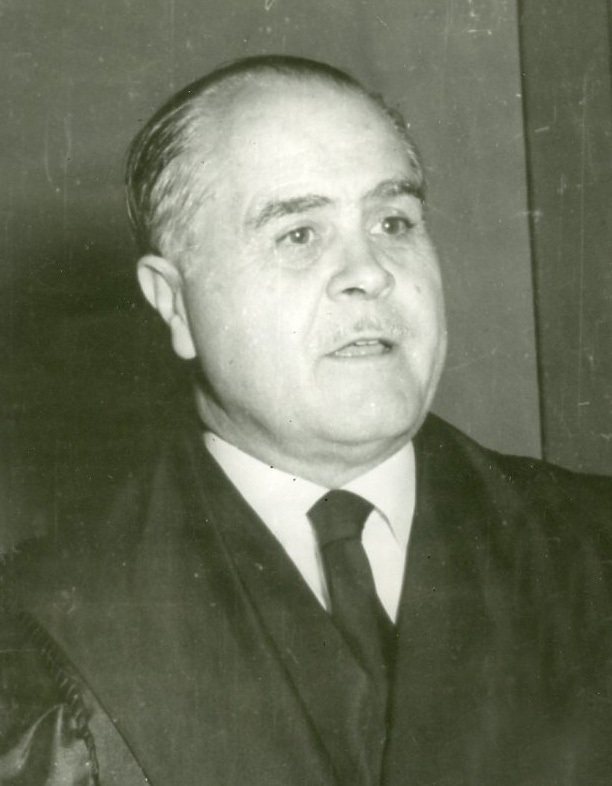 |
||
| Mr. José del Río Amor, practicing lawyer and person of great social importance. | ||
| Vicepresident I | Vicepresident II | Vicepresident II |
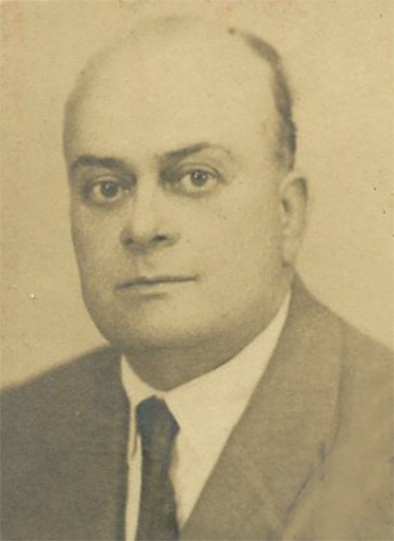 |
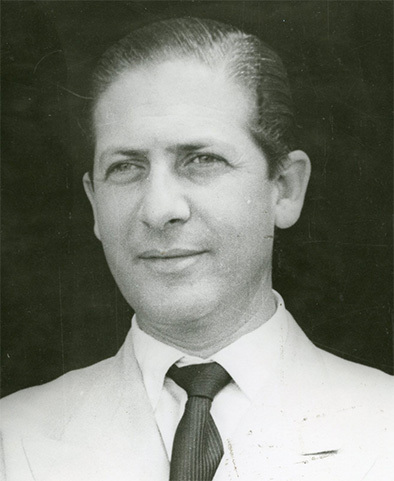 |
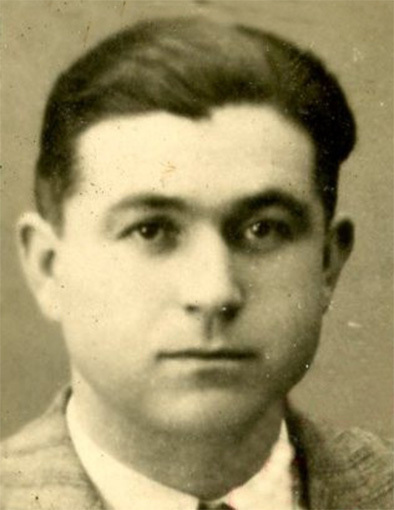 |
| Mr. Manuel Rodríguez Monroy, manager of the idea of merger and creation of UD Las Palmas. | Mr. Eufemiano Fuentes Díaz, president of Marino C.F. | Aurelio Montenegro Riobó, president of the R.C. Victory. |
| Secretary | Vicesecretary | Treasurer | Counter |
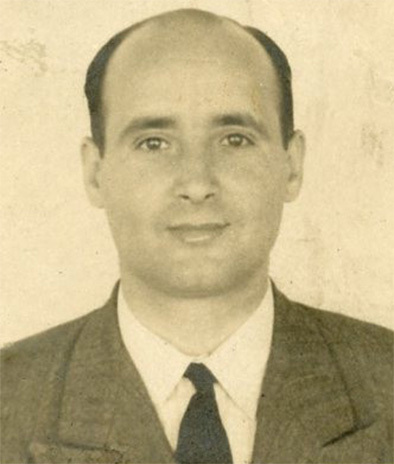 |
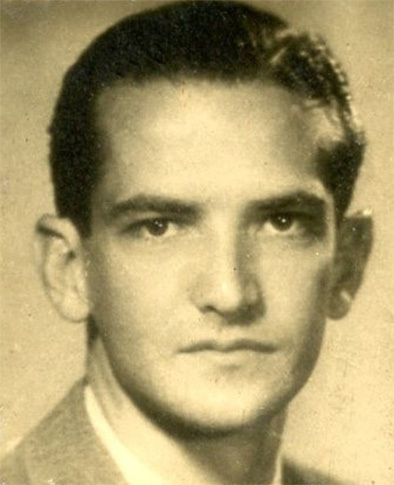 |
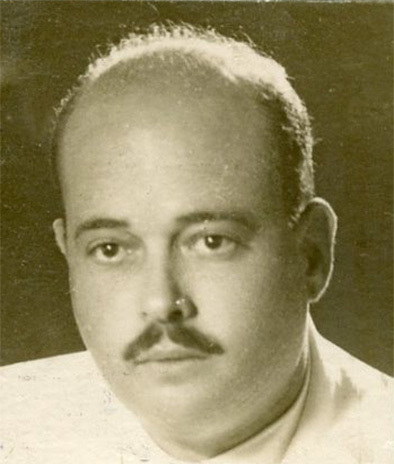 |
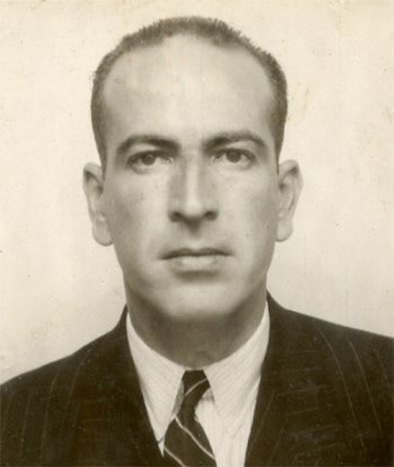 |
| Mr. Luis González Vera, president of the Arenas Club | Mr. Alberto García Sastre, secretary of the R.C. Victory | Mr. Francisco Naranjo Hermosilla, vice president of Marino C.F. | Mr. José Jiménez Sánchez, vice president of the C.D. Gran Canaria. |
| Vocales | ||||
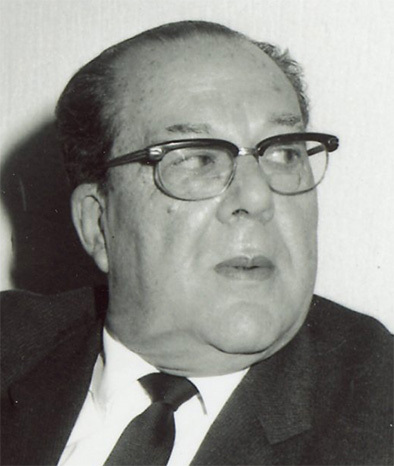 |
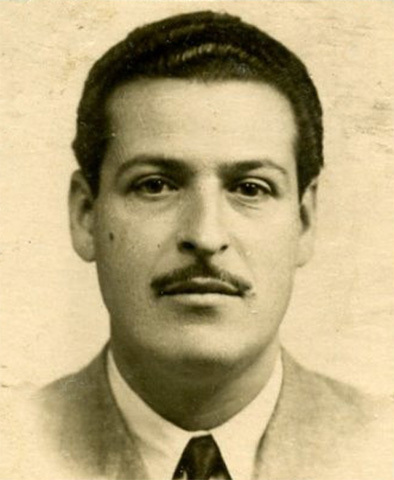 |
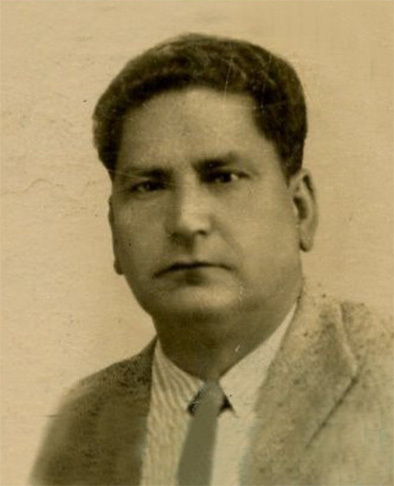 |
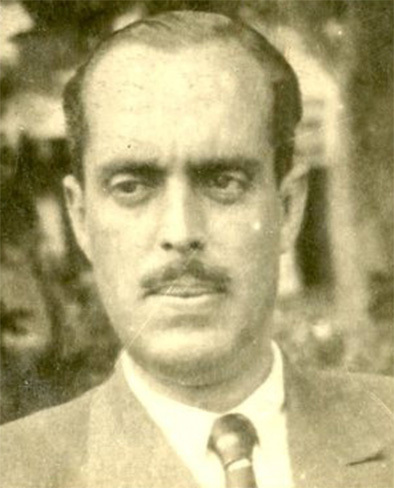 |
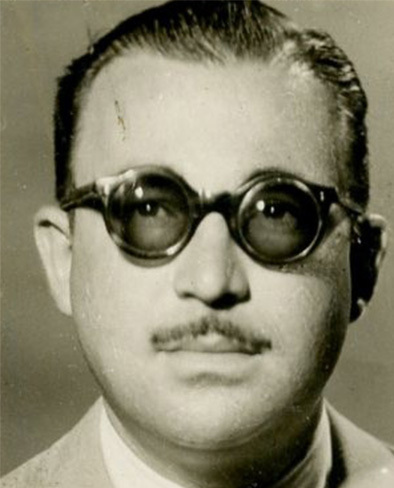 |
| Mr. Simón Doreste Struch. Marino C.F.. |
Mr. Juan Trujillo Febles. Atlético Club |
Mr. Víctor Santana Saavedra Atlético Club |
Mr. Bruno González García Atlético Club |
Mr. Guillermo Wyttenbach García. R.C. Victoria |
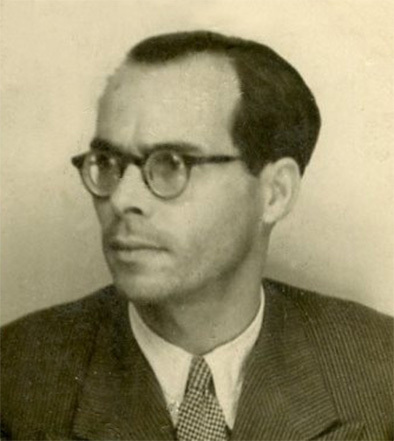 |
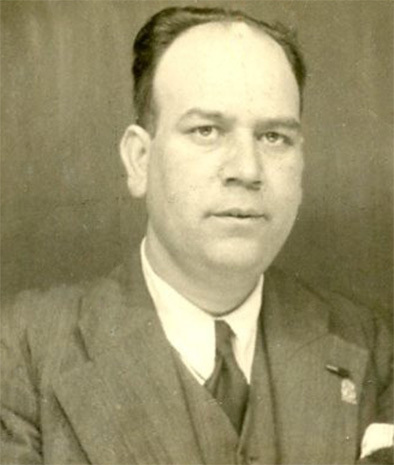 |
| Mr. Manuel Hernández Sánchez. Arenas Club |
Mr. Juan Morán de la Nuez. C.D. Gran Canaria |
Four days later, on August 26, 1949, at 8:00 p.m. the U.D. Management Commission met. Las Palmas, in order to celebrate its first session. Once it was declared open by Mr. President Mr. José del Río Amor, the first point in the order of matters prepared for the meeting was then discussed, which was the creation and distribution of the positions of the board of directors and the taking of possession. thereof.
The president, Mr. José del Río amor, took the floor briefly explaining the tasks of the new directors. Immediately afterwards, and after a short debate, it was agreed to create the position of technical secretary of the club.
The President then spoke in favor of expanding the number of members to five. This measure was taken to avoid excess work on the part of managers, and the suggestion deserved the approval of those present.
Likewise, it is agreed that the monthly fees to be paid by members would be twenty-five pesetas for preference and fifteen pesetas for general membership.
Finally, the President asked everyone for greater collaboration in favor of the greater success of our team, adjourning the session at 10:00 p.m. on the current day.
On August 31, 1949, Mr. Luis Rivero Noble would join the sports commission and on December 15, 1949, Mr. José Sánchez y Sánches and Mr. Expedito Calderín Alemán would join as members, proposed by their R.C. teams. Victoria and Arenas Club respectively.
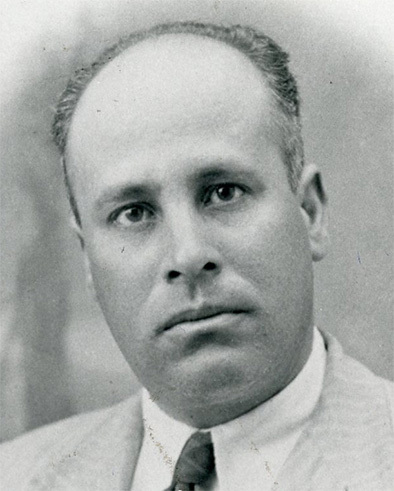 |
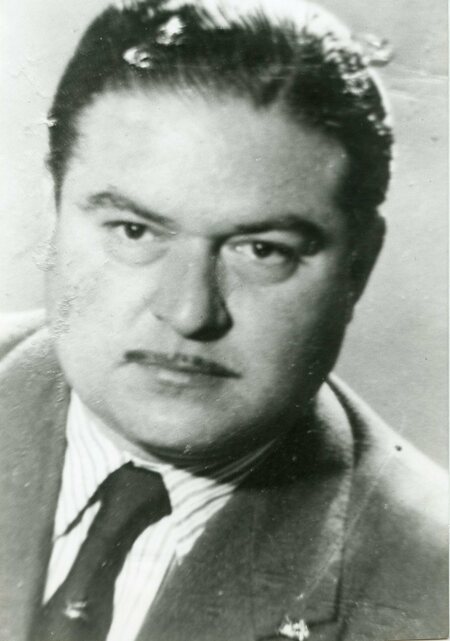 |
| Mr. José Sánchez y Sánchez. | Mr. Expedito Calderín Alemán. |
It should be noted that the work of the first president of UD Las Palmas was very brief. His multiple occupations did not allow him to fully dedicate himself to the position, being forced to delegate his functions to Mr. Eufemiano Fuentes Díaz, who would assume command on an interim basis until his definitive possession with the club's first board of directors.
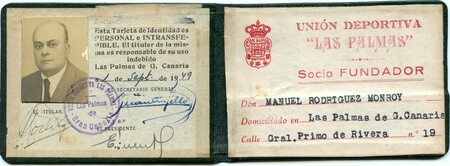
Membership card of Mr. Manuel Rodríguez Monroy.
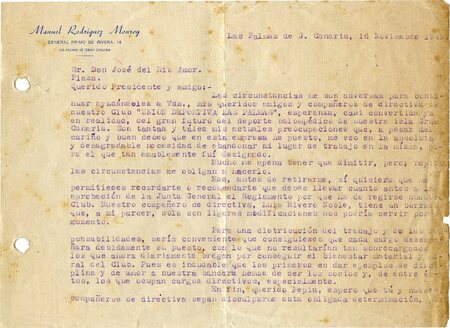 |
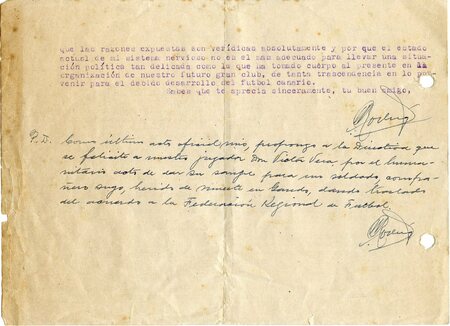 |
| Resignation letter from Mr. Manuel Rodríguez Monroy. | |
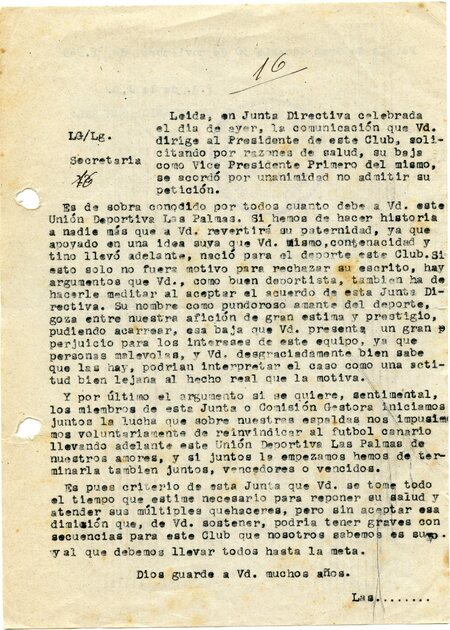 |
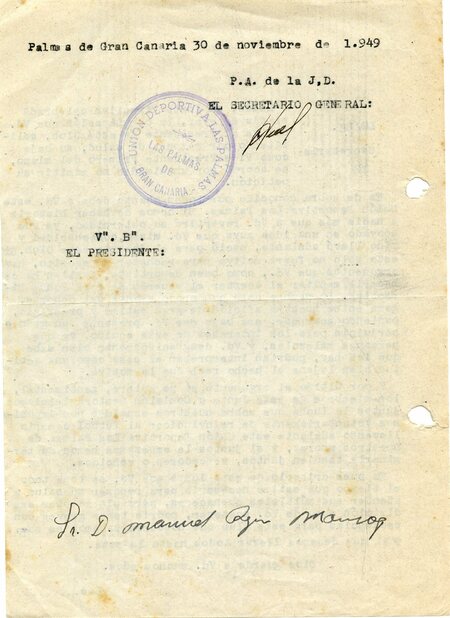 |
| Response not accepting the resignation. | |
Resignation of Mr. José del Río Amor.
Only six months after taking office as the first president of UD Las Palmas, Mr. José del Río Amor would present his resignation.
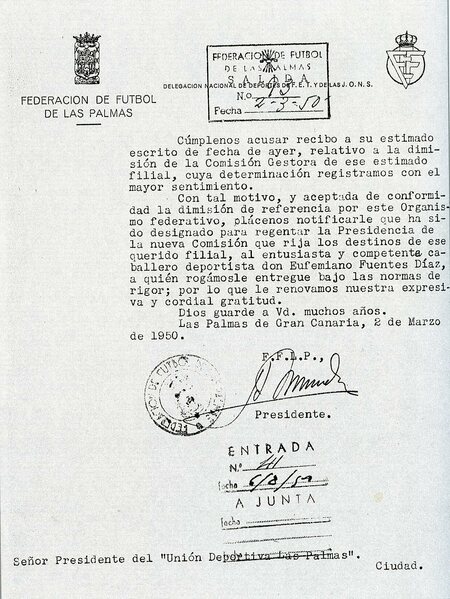 |
| Resignation of Mr. José del Río Amor as president of UD Las Palmas. Mr. Eufemiano Fuentes Díaz was appointed to the position of new president. |
On February 24, 1950, at 8:00 p.m., the Management Committee, chaired by Mr. Del Río Amor, met at the headquarters of the yellow club. Sports and administrative issues of interest to the entity would be addressed, especially the delicate economic situation that the club had been going through. The president then took the floor to apologize for his limited personal contribution in his half-year of management as head of the club, motivated by his excessive work and obligations as a lawyer, believing it was urgent to adopt a favorable decision for the club destinations.
As a measure of principle, Mr. Del Río Amor informed the board of the results of the conversations held with the president of the Football Regional, Mr. Miranda Ortega, notifying him of his intention to abandon the presidency of the U.D. Las Palmas, a fact that he carried out at that time, presenting his resignation irrevocably.
He went on to explain that after several contacts he had had with the vice president of the club, Mr. Eufemiano Fuentes Díaz, at a private level, he was willing to assume the presidency of the Management Committee, then briefly presenting the suitability of Mr. Eufemiano Fuentes. Díaz to carry out said position. Finally, Mr. Fuentes Díaz thanked the deference of unanimously proposing him for the presidency, as he deserved the trust of the representatives of the merged clubs.
Union Deportiva Las Palmas There is strength in unity.
In the newspaper Canarias Deportiva an article was published dated October 20, 1949, which we have chosen to capture the general feeling that existed at that time around the newly created Unión Deportiva Las Palmas.
Now that the unique team, the Unión Deportiva Las Palmas, is a reality, when all the Canarians open our hearts to hope and dream of seeing the representative colors of Gran Canaria, the gold of our beaches and the blue of our sea, it is It is fair to remember its true creators.
“Vis unita est fortior” said the Romans. There is strength in unity, the Spanish saying goes. All the canaries have just joined us and it is our U.D. Las Palmas the indissoluble bond that unites us. Very soon we are going to engage in a tough fight with other Spanish regions and as in the past the Doramas, Adargoma and Maninidra united, rising as one man from Gáldar to Tirajana to stop the invader, our teams have joined together.
There is, therefore, a lot of patriotism in this union. It is not in vain that the colors of our flag protect us; colors of Gran Canaria defended by the now forever glorious Las Palmas Sports Union.
“Canary, whoever you are and wherever you are, join the cause. The U.D. Las Palmas, with the colors of your flag, needs you.”
Let's not forget: There is strength in unity, defending the yellow colors of our team we will defend our island and make Gran Canaria bigger.
Luis Antúnez nº 1, the essence and perennial memory of our ancestors.
In this headquarters at Plazoleta de Luis Antúnez No. 1, UD Las Palmas has remained since its foundation in 1949, when the premises were kindly given to it by C.D. Gran Canaria, until October 22, 1992, when it was forced to abandon its premises after a long legal dispute.
Former headquarters at Plazoleta de Luis Antúnez No. 1. Previously it had belonged to the C.D. Gran Canaria, which generously donated it to the U.D. when the merger took place. Las Palmas with all its trophies and belongings.
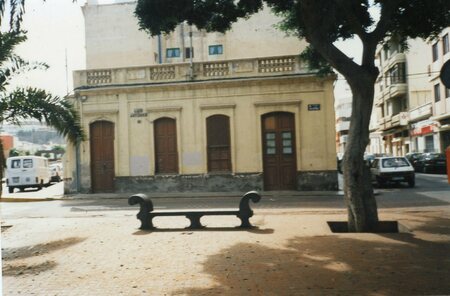 |
| Former headquarters at Plazoleta de Luis Antúnez No. 1. Previously it had belonged to the C.D. Gran Canaria, which generously donated it to the U.D. when the merger took place. Las Palmas with all its trophies and belongings. |
In the first founding years of the yellow team, the owner of the property was Mr. Juan Miranda Márquez and the cost of rent had increased from 50 pesetas with C.D. being the owner of the headquarters. Gran Canaria, popularly known as the thirty-three club or the glitter children's club at 75.50 (seventy-five pesetas and fifty cents) according to the club's minute books.
Years later the house would go to public auction and was awarded to Mr. Antonio Cruz Naranjo who was at that time a member of the yellow board (treasurer). Mr. Cruz Naranjo continued to graciously respect the old lease and always had a very generous attitude towards the club. Despite their repeated and generous offers to the leaders of the UD Las Palmas to agree to their purchase, the top yellow leaders, relying on the low rental regime and the rights granted by the leasing legislation regarding the extension forced, they did not consider its acquisition necessary.
In September 1970, UD Las Palmas would move to its current headquarters at 29 Pío XII Street, leaving the old headquarters for the exclusive use of branches.
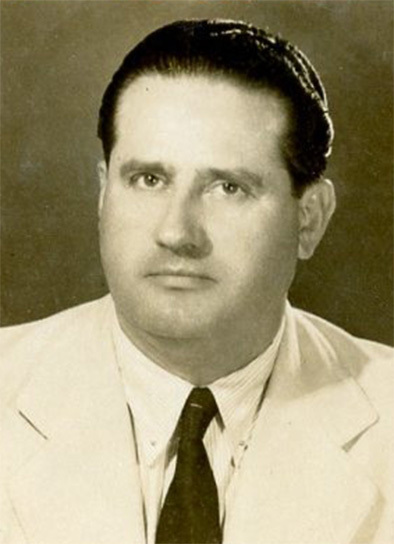
Mr. Antonio Cruz Naranjo.
When Mr. Antonio Cruz Naranjo died, his heirs, represented by the lawyer Mr. Francisco Martínez de Córdoba, claimed the premises, alleging in their defense that the yellow club already had a new headquarters and consequently it was not of urgent need for the entity. .
After a long judicial process, the Court favorably accepted the arguments put forward by the heirs, leaving Ms. Esther Cruz Guerra as the current owner.
There is no doubt that the loss of the old yellow headquarters was a huge disappointment for all fans, not only because of what was familiar and endearing to it but because it represented the weight of its history.
Many experiences from our childhood and youth went with her. Excited memories that have helped us deeply love this institution. It also hurts us to recognize and accept that part of our club's history has gone forever with her.
Evolution of the name and uniformity.
Regarding the name, since it was a merged club, there were certain differences and disagreements.
At first, “Deportivo Canarias” had some strength, but it would be rejected for referring to all the islands. “Las Palmas” and “Real de Las Palmas” would also come up, which were canceled as there was a club with that name at that time. Finally it was decided, I think with good judgment, to name a team that had been born from the union and effort of all the Canarians and that would be called Unión Deportiva Las Palmas.
It must be understood that it was based on not being able to be named after any merged club. This stipulation was recorded before a notary and still applies today in the club's statutes. I say this for those people who speak slightly without knowing the reality of the facts. As far as I'm concerned, the club has only had and will have one name: Unión Deportiva Las Palmas.
In reference to the evolution of the name, according to the merger documents, initially the club's former headquarters and the team itself were called “La Unión”. We must not forget that UD Las Palmas, as its name clearly indicates, was born from the union of all the Canary Islands. Others called the team since its foundation “The Unique Team” referring to the merger of the clubs.
Over time, words evolve into others and substantial changes occur at a phonetic, syntactic and semantic level. From the foundation until the mid-fifties, as the chronicles of the time clearly state, it was called “El Unión Deportiva Las Palmas” or simply “El Deportivo”. Over time there would be a phonetic change from the phoneme /e/ to /a/ adopting the article
feminine, becoming definitively called La Unión Deportiva Las Palmas or simply more informally La Unión Deportiva.
Regarding the shield, the work of the Fusion Presentation should be highlighted, in a very special way Mr. Simón Doreste Struch, who would speak with his cousin Mr. Simón Doreste Doreste, entrusting him with the difficult mission of configuring the entity's shield.
Mr. Simón Doreste was a renowned cartoonist who worked in this capacity in the advertising of the Royal Cinema. The first design or sketch and subsequently its final configuration are due to him.
Naturally, the idea had previously come from the Fusion Presentation. Once the motion presented by Mr. Manuel Rodríguez Monroy on February 4, 1949 in the Regional Federation of Las Palmas was accepted and all the historical clubs having been summoned to inform them of his intention, all the details of the new team began to be organized.
Mr. Simón Doreste Doreste has been one of the best cartoonists and publicists that the island has produced, exercising, outside of his profession, a priceless didactic work praised even by such relevant architects as Miguel Martín Fernández de la Torre.
The shield of the U.D. Las Palmas was configured in parts. At first, the city council was asked for the city's colors and coat of arms in a letter written by Mr. Lázaro Guerra Pérez, the institution's first employee. Finally, it was decided to reject the white color and only use the yellow and blue colors bordered by the five historic clubs.
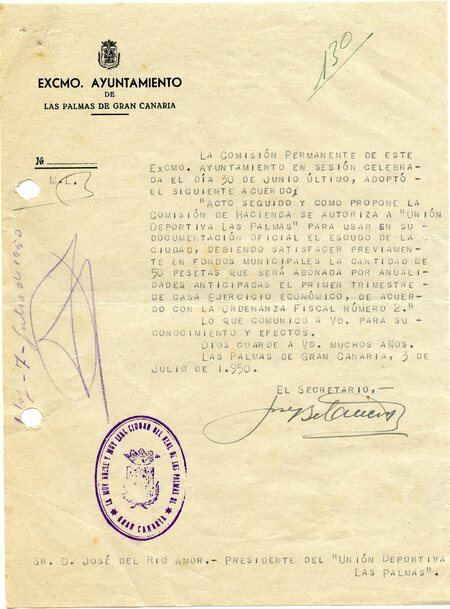 |
| Request to the City Council for the city's coat of arms with a letter written by the entity's first employee, Mr. Lázaro Guerra Pérez. |
The shields of the R.C. Victoria, Marino C.F. , Arenas Club and Atlético Club would be placed interchangeably without keeping any special position. Another different case would be that of C.D. Gran Canaria that would ask to be located in the center of all the merged clubs.
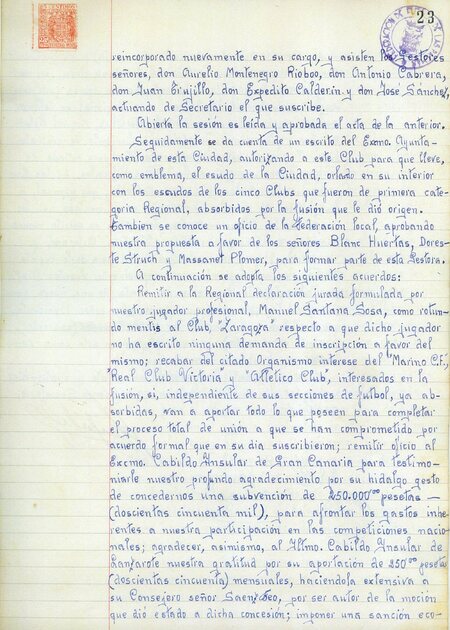
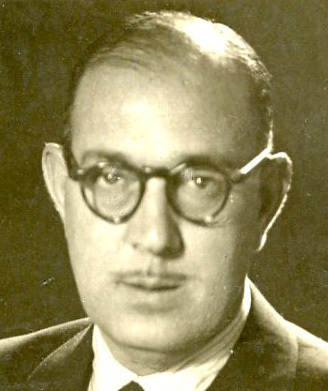
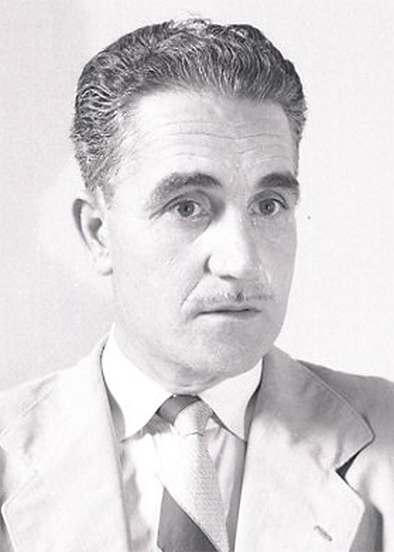
Patricio Blanc Huertas. Damián Mazanet Globex.
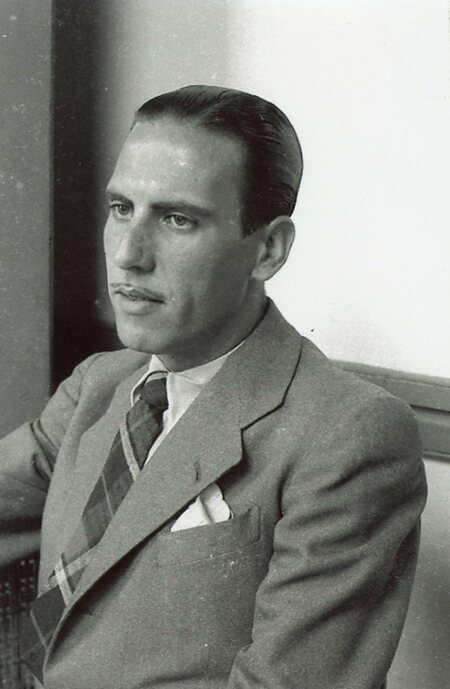 |
| Mr. Simón Doreste Doreste author of the first design of the UD Las Palmas shield. |
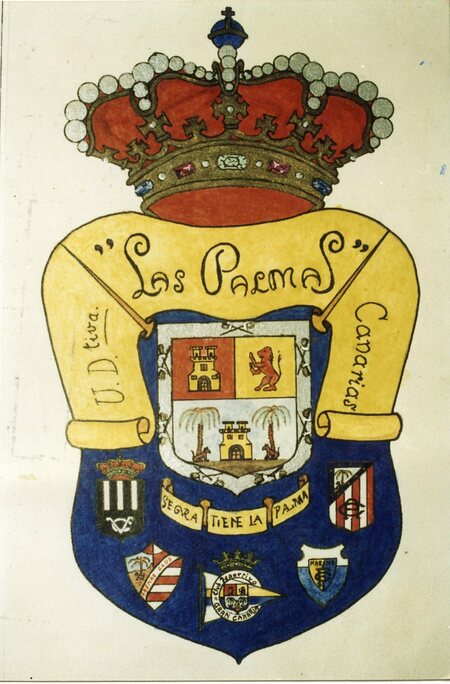 |
| First sketch of the U.D. shield Las Palmas designed at the end of the 1940s by Mr. Simón Doreste Doreste based on the city's shield, bordered with that of the five historic clubs. |
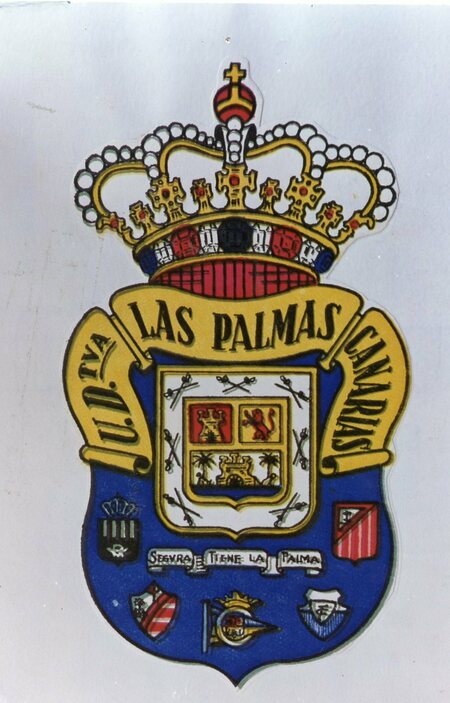 |
| Shield designed by the same author and fully configured in the 1950s. |
Uniformity.
The UD Las Palmas club uniform was configured as follows:
Shirt: Plain yellow.
Briefs: Plain strong blue.
Socks: Blue with yellow trim.
Shield: That of the city of Las Palmas de Gran Canaria bordered with those of the R.C. clubs. Victoria, Marino C.F., C.D. Gran Canaria, Arenas Club and Atlético Club.
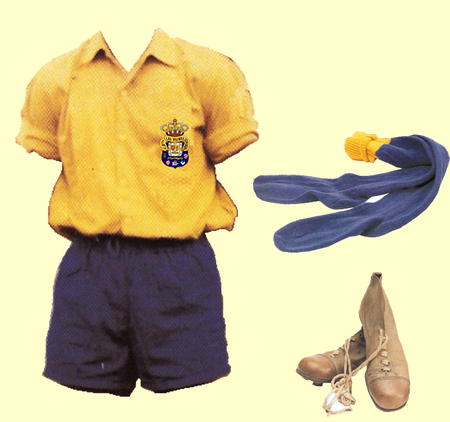 |
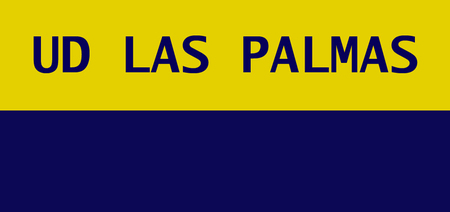 |
| Configuration of club uniformity. | Founding emblem of the U.D. The Palms. |
